Australian Made 30
Cyber crime is an almost invisible pandemic that has been infecting the world, and manufacturers need to be on high alert.
According to IBM’s 2022 X-Force Intelligence Report, manufacturing became the most attacked industry globally in 2021 – replacing financial services. Manufacturing is less of a target here says the Australian Cyber Security Centre (ACSC) — but for how long?

Cyber attacks worldwide are estimated to have stripped companies of US$8.4 trillion last year, according to Statista. com, and it’s only going to get more expensive. Industry estimates put the cost of attacks by 2025 between $10-$20 trillion (for context, nominal GDP for the US was $23 trillion last year).

Several of Australia’s biggest, hightech firms were shocked by last year’s breaches and data theft, despite a cascade of warnings over the years. Although
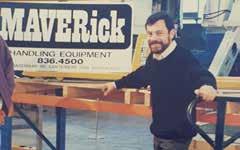

manufacturers are less likely to store consumer data than recent high-profile victims, they too will be shocked when their systems are breached, held hostage and production crippled.
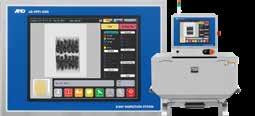
There’s a bucketful of reasons manufacturers are increasingly targeted by cyber criminals. Yet many are complacent and some oblivious as to just how vulnerable their systems are – making them even more attractive.
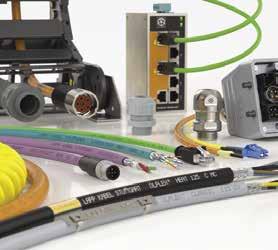
It’s sometimes been assumed industrial operations are less likely to be targeted because they don’t hold consumers’ personal data, but that’s no longer the case. The misconception is partly because most reported breaches are by public-facing firms which have had consumer data stolen and they have been compelled to tell people their data has been stolen.
Incidents reported, however, are just the tip of the iceberg: most often, victims
by Christine Powis
do not talk about it unless they have to.

Smart factories are busy enhancing production and supply chain performance by combining information tech (IT) and operational tech (OT) into reliable, interconnected factories which proactively analyse data for ongoing improvement. This integration can boost cross-functional collaboration, help plan and optimise processes, remediate quality defects and generally deliver better products faster and more cheaply.
Along with all these advantages, greater interconnectedness brings greater risk: each interconnection enlarges the attack surface. Yet the trend to more connectivity and more smart devices in the Internet of Things (IoT) is not slowing, and 5G networks’ next-level connectivity will accelerate it.
The risks are huge: around 60% of SMEs in the US which had a cyber Continues on page 14
AUSTRALIA'S LARGEST CIRCULATING MANUFACTURING MAGAZINE Issue 130 Feb/Mar 2023 $12.00 inc. GST 18 20 48 Logi-Tech partners with Aria Cybersecurity to protect older legacy OT systems Industry maverick hands over company - but isn’t ready to retire yet Tailor-made measurement with A&D Australasia Manufacturing’s
industry ACCESS OVER 25,000 L APP CABLES, CABLE GL ANDS & CONNECTORS ONLINE. Make the right connection with L APP Australia. lappaustralia.com.au sales@lappaustralia.com.au 1800 931 559 LEADER IN CABLE AND CONNECTIVIT Y SOLUTIONS
cyber status: most attacked
AUSTRALIA’S PREMIER MANUFACTURING SOLUTIONS EVENT 9TH – 12TH MAY 2023, MELBOURNE • MCEC SCAN HERE TO REGISTER NOW! 1699AMWMEL23INDUPDATE
60
Manufacturing trends for 2023
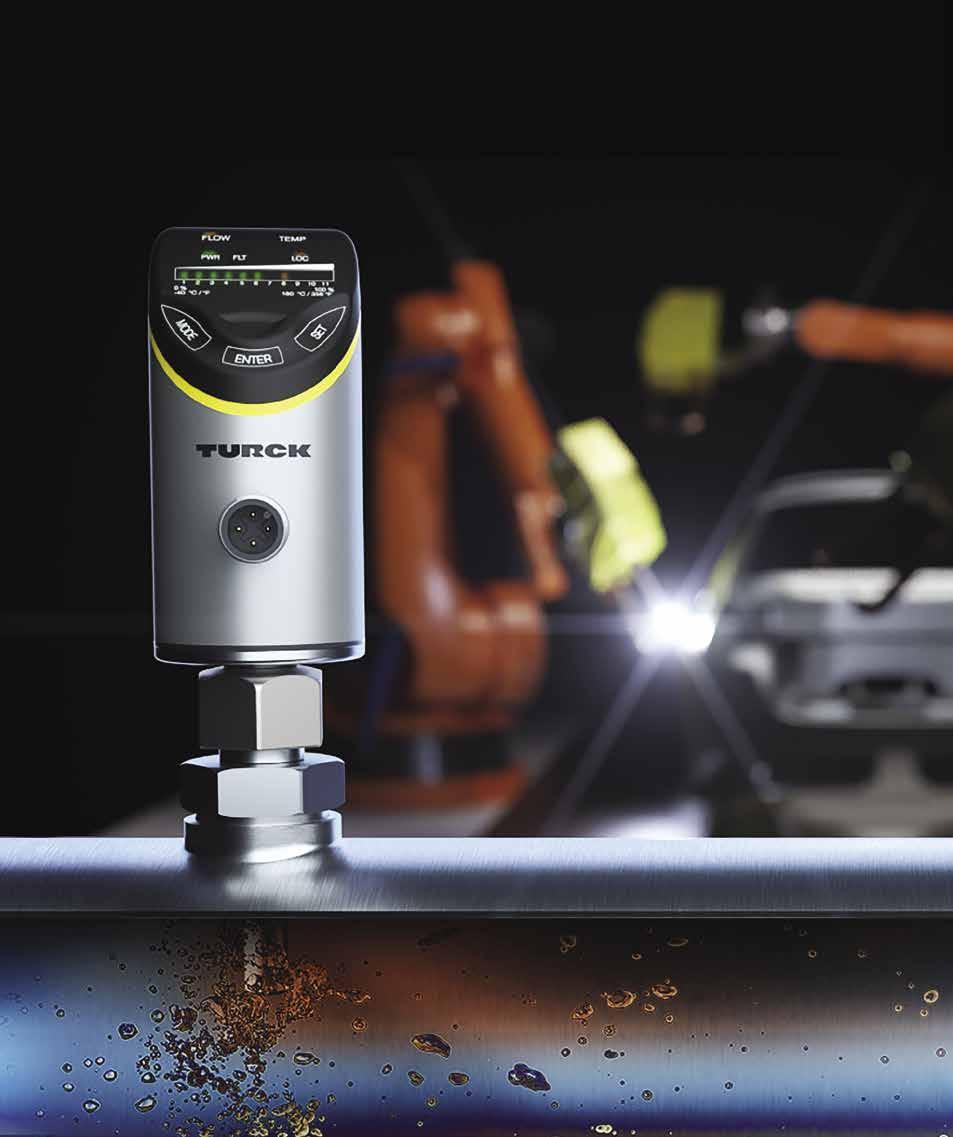


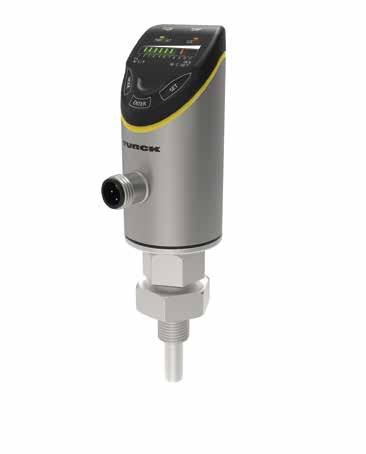
Getting Territorial about manufacturing
By Margie Smithurst
It’s an ambitious goal for an economy that’s underpinned by primary resources and raw materials.
By 2030, the Northern Territory government wants its economy to be worth $40 billion, requiring a sustained annual GSP (Gross State Product) growth rate of 3.9%.
With current forecasts sitting at $35.2bn, there’s considerable ground to make up – an extra $1.4 billion per year worth of output, according to the Territory Economic Reconstruction Commission report.
markets,” says the AMGC’s NT Director, Charmaine Phillips, “and there are good existing capabilities here already. The pandemic showed how cut off the NT was from a lot of suppliers, and forced local businesses to strengthen the region’s manufacturing ecosystem.”
Money for manufacturers
Phillips says the AMGC is looking to invest in NT manufacturers to support them in adopting advanced manufacturing technology and processes in order to make more products locally, to work smarter and become more competitive.
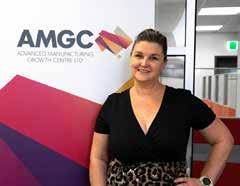
But there are challenges, admits Charmaine Phillips, including businesses not understanding what advanced
Manufacturing Ecosystem Fund
(AMEF) is administering $7.5 million of NT Government money, and has supported six local manufacturing projects since opening in 2021.
Slated as a five year program, the AMEF has already committed $2.2m, with another 30 applications in various stages of the pipeline.
The first co-investment was with Palmerston-based company Corrosion Instruments (CI), which is also first off the rank with a new product.
First NT electronics production
After three years of development, Corrosion Instruments has launched CI-Tx, a system that remotely monitors and
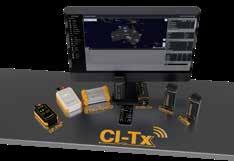
electronics production manufacturing facility. And Pattemore is hoping to eventually hire out their in-house equipment to other local businesses to build local capabilities.
It’s about capability
Fundamentally, the AMGC believes manufacturing needs to be looked at as a capability rather than an end product.
The AMGC’s Tyson Bowen cites the example of how they encouraged the only wristwatch manufacturer in Australia, Nicholas Hacko Watchmakers, based in Sydney, to pivot to producing space components.
Wristwatch making is a process that requires difficult precision engineering, with techniques, knowledge and machining equipment similar to the capabilities required to manufacture space componen-
To get there, the NT is hoping to bolster its underdeveloped manufacturing sector, which currently accounts for only 3.6% ($1.1bn) of the Territory’s GSP and employs around 3,400 people.
Leveraging the NT’s considerable resources base to add value is one way forward. The growing opportunities in the defence, maritime and space sectors are another, as is expanding on manufacturers’ current capabilities.
This is where the AMGC, the Advanced Manufacturing Growth Centre, comes in. In partnership with the NT Government, it is identifying opportunities in all regional centres, and says the NT is uniquely placed for manufacturing expansion.
“Darwin is well positioned for export
manufacturing can be, and not being aware of the technology that’s available, nor having access to it.
controls the cathodic protection on pipelines, wharves, storage tanks and tunnels.
Previously, monitoring corrosion on such large metal infrastructure was an onerous task that had to be done manually, says founder and Managing Director, Sam Pattemore.
Pattemore says they sought co-investment largely because global supply chain issues for electronics meant a local prototype and testing facility was urgently needed.
“One of my initiatives this year will be to take the NT delegation to the Australian Manufacturing Week in Melbourne (in May) so they can build relationships, increase their knowledge of what’s being used elsewhere, and start thinking about how they can incorporate that into their organisations.”
The AMGC’s Advanced
With $110,000 from the NT-Government (via the AMEF fund), matched by their own $110,000 in funding, the company has been able to buy machinery and tools, including a PCB prototype printer.

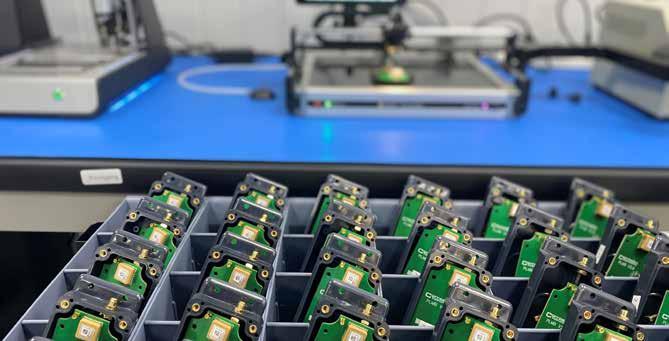
This allows them to manufacture prototypes in-house, meaning they can commercialise products much more quickly.
Critically, it’s also the NT’s first
try - for micro satellites, for example.
The company now has an offshoot, NH Micro, which offers precision contract manufacturing not just for the space sector, but for scientific instruments and the semiconductor industry.
In the NT, the AMGC’s Charmaine Phillips is cautiously optimistic.
“I’ve lived here for 16 years and worked with industry for a long time. I’m very supportive of local businesses here in the NT.
“But we do have a perception challenge to get over in these early days, which is why having this five year program is great.
“That allows me to work with manufacturers to get a change of thinking happening, so that they can look at their
strategic goals for the next 3-5 years, and hopefully put processes in place to adopt advanced manufacturing technologies, which is where AMGC can then support them in further developing increased local manufacturing capabilities.”
INDUSTRY NEWS
Corrosion Instrument’s CI-Tx hardware in production
“Darwin is well positioned for export markets”
“The NT’s first electronics production manufacturing facility”
“The AMGC believes manufacturing needs to be looked at as a capability rather than an end product.”
Corrosion Instrument’s CI-Tx system
Charmaine Phillips, AMGC’s NT Director
4 | Industry Update Issue 130 Feb/Mar 2023 industryupdate.com.au
Corrosion Instruments’ team, with Sam Pattemore 4th from left
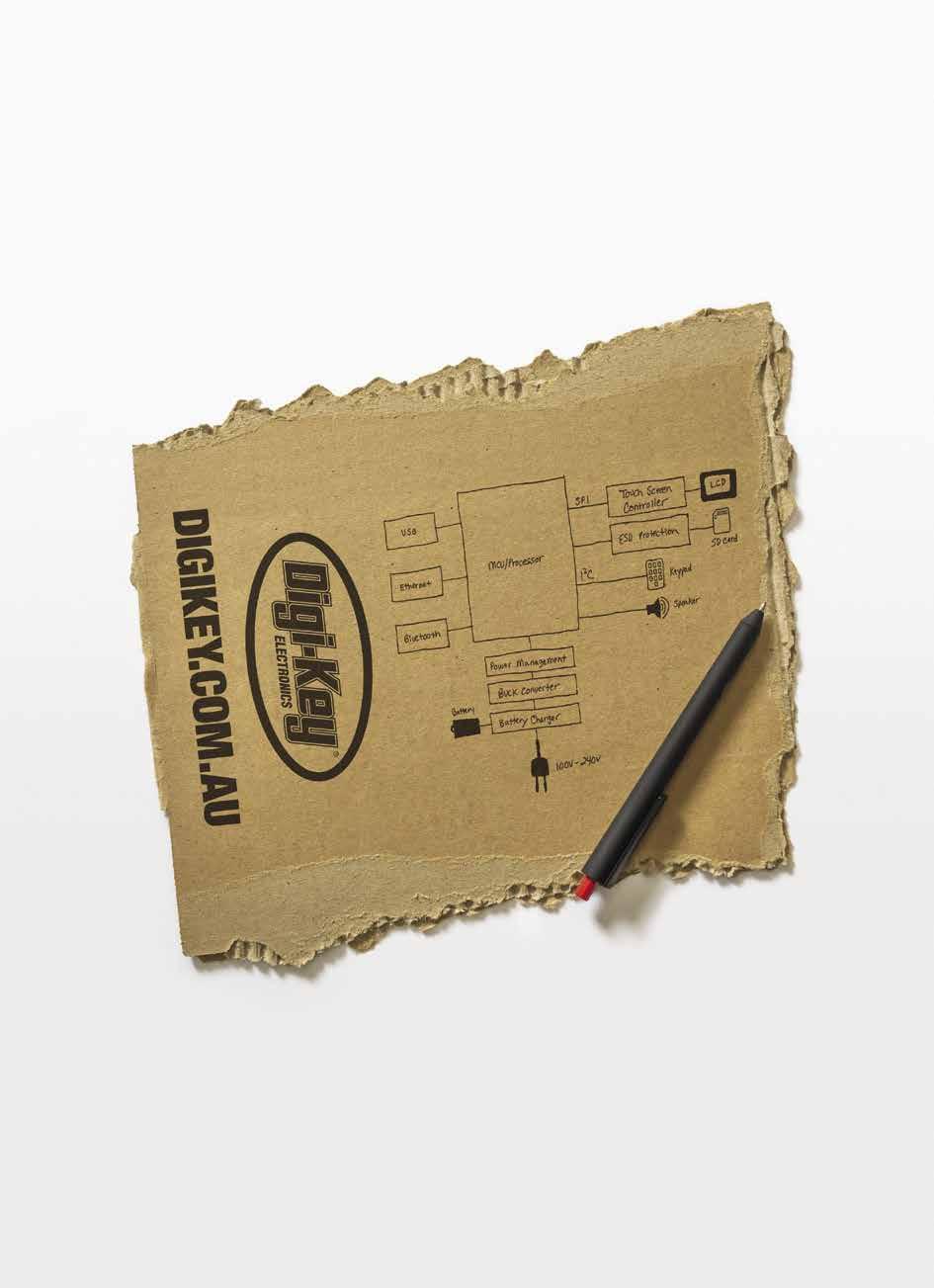
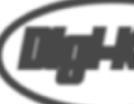










CONTENTS
www.greasemax.au

MANUFACTURING MAGAZINE
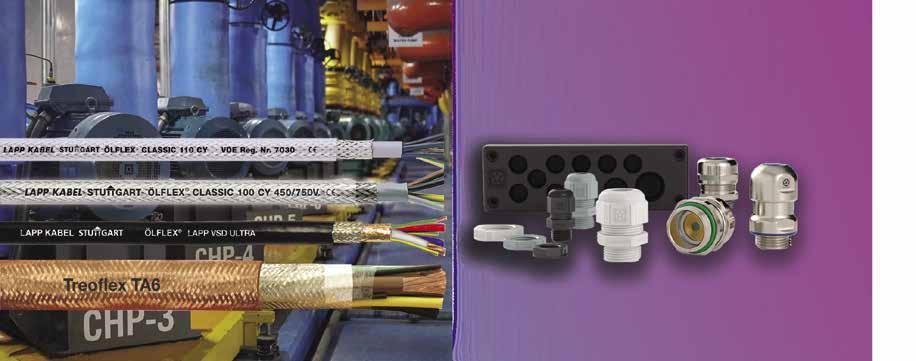
Industry Update Media Pty Ltd ABN 25 083 502 783 Suite 403, Level 4, 116-118 Christie Street, St. Leonards NSW 2065 +61 2 9439 1288 / sales@industryupdate.com.au
Circulation 17,754
Readership 71,016 as at September 2022
All material in this publication is copyright to the publisher and/or its contributors. No material may be reproduced in part or in whole without the written consent from the Publisher. It is a condition of purchase or acceptance of this magazine that the Publisher does not assume any responsibility or liability for any loss or damage which may result from any inaccuracy or omission on this publication or from the use of the information in this publication or from the use of the information and illustrations contained herein and the Publisher makes no warranties, express or implied, with respect to any of the material contained herein. © Copyright Industry Update Media Pty Ltd 2023
Publisher SCOTT FILBY scott@industryupdate.com.au
Editor CHRISTINE POWIS editor@industryupdate.com.au
Writer MARGIE SMITHURST writer@industryupdate.com.au
Universities & Collaboration Editor DAVID SLIGAR unieditor@industryupdate.com.au
Sub Editor WILLIAM POOLE subeditor@industryupdate.com.au
Advertising Sales Director SCOTT FILBY scott@industryupdate.com.au
Marketing Manager DUMI UDESHIKA marketing@industryupdate.com.au
Creative Director EDWIN KWONG production@industryupdate.com.au
Production Manager DUMI UDESHIKA copy@industryupdate.com.au
Video Editor & Producer CHARLIE LOUGHLIN video@industryupdate.com.au
Office Manager NICOLE CHARLES nicole@industryupdate.com.au
Finance & Accounts MICHELLE ALCOCK michelle@industryupdate.com.au
Consultant TRACY FILBY tracy@industryupdate.com.au
Accounts Receivable LYN SLIGAR lyn@industryupdate.com.au

Subscription Assistant SAM HICKS info@industryupdate.com.au
Circulation Assistant JERIN BURZACOTT circ@industryupdate.com.au
Printer
Developer
M
SPOTPRESS Web
JINI
R
simply superior! single point lubrication WHAT’S POOR LUBRICATION COSTING YOU? MEDIAKIT2023 MANUFACTURING MEDIA AUSTRALIA’S NO.1 MANUFACTURING & INDUSTRIAL EQUIPMENT MAGAZINE & DIRECTORY DOWNLOAD MEDIA KIT Industry News 4 From the Publisher 8 From the Minister 10 From the Shadow Minister 12 Cyber Security 14 Manufacturing Trends 20 Business, Finance & Accounting 22 Australian Made 30 Automation 34 Machinery 44 Materials Handling 45 Focus on South Australia 58 Workplace Health & Safety 64 Women in Manufacturing 69 Energy, Waste & Recycling 72 Doors 76 Products 79 Events 82 Treotham Automation supplies an extensive range of high-quality flexible cables, cable glands and accessories. Each state office has a full range of products in stock ensuring fast turnaround for all orders. Our highly experienced technical engineers provide thorough and reliable ser vice to custom-build solutions for projects of any size or application. 100 Australian Owned and Managed Celeb ating 30 years -1992-2022 Contac t Treotham Automation 1300 65 75 64 info@treotham.com.au Treotham has a full range of VSD cables and cable glands in stock now. 6 | Industry Update Issue 130 Feb/Mar 2023 industryupdate.com.au
Deakin’s ManuFutures hub opens doors to more businesses

More Victorian businesses are set to benefit from Deakin University’s expanded $20 million ManuFutures hub – its advanced manufacturing innovation facility.
Having doubled in size, the now complete and new-look ManuFutures building at Deakin’s Waurn Ponds campus is partnering with 14 successful and emerging businesses to grow advanced manufacturing capability in regional Victoria and Australia.
It can now deliver an increased number of tenancy opportunities, new manufacturing incubator programs, training, and product engineering services.
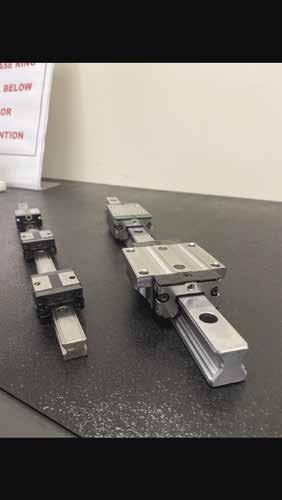



The expansion was funded by the Victorian Government ($10 million) and Deakin University ($10 million) as part of the Government’s $350 million Victorian Higher Education State Investment Fund launched post-COVID.

Deakin Research Innovations Regional Manufacturing Director Mark Curnow said the completion of ManuFutures2 puts Deakin University at the forefront of manufacturing innovation for entrepreneurs, start-ups and existing businesses.
“Our new ManuFutures2 building includes collaborative working spaces, further rental tenancy bays for manufacturing businesses, and an Innoveering Centre that includes product engineering and development capability, and opportunities for research collaboration and integration,” Mr Curnow said.
“Four new manufacturing businesses





have already moved into the new spaces as tenants, with room for two more. A total of 14 successful and emerging global manufacturing businesses now call Deakin’s ManuFutures home.”
Deakin University Deputy ViceChancellor and Research Professor Julie Owens said ManuFutures demonstrated Deakin’s leadership and success in real world research and commercialisation, in partnership with industry.
“Since opening in 2018, ManuFutures has a successful track record of helping entrepreneurs and start-ups take ideas from paper, to prototype, to emerging global businesses,” Professor Owens said.
“ManuFutures has helped create more than $1 billion in company value, incubated more than 17 advanced manufacturing start-ups, helped companies establish export markets in more than 35 countries, hosted 500 student placements, and created more than 120 advanced manufacturing jobs.”
Victoria’s Minister for Training and Skills, Higher Education, and Agriculture, Gayle Tierney, said that the Victorian Government’s investment in ManuFutures as part of the Victorian Higher Education State Investment Fund is helping to strengthen innovation, training, and industry collaboration in regional Victoria.
“Deakin’s new advanced manufacturing hub provides a space for higher education and industry to collaborate on complex challenges, ensuring opportunities in emerging industries and future jobs for Victoria’s regional communities,” Minister Tierney said.
To learn more about ManuFutures tenancies, training and services visit: deakin.edu.au/manufutures
The
to
...for all your linear motion needs 54-58 Arkwright Drive, Dandenong South Vic. 3175 Tel: 03 9706 7888 info@lineartechnik.com.au www.lineartechnik.com.au LINEAR BEARINGS LINEAR SETS ALUMINIUM PROFILES PROFILE RAIL GUIDES • Expert Product Knowledge • Huge Stock Holdings • Fast Access to all Brands • 24/7 Breakdown Service • Fully equipped Workshop facilities • Same Day Despatch to all States on Stocked Products With over 50 years of combined experience, Linear Technik has gained an enviable reputation as Australia‘s leaders in Linear Motion Technology. Our product and industry knowledge is second to none and our range covers all aspects of Linear Motion Technology. Linear Technik has a solution for all Linear applications!
name
remember
ManuFutures deakin.edu.au/manufutures INDUSTRY NEWS Industry Update Issue 130 Feb/Mar 2023 | 7 industryupdate.com.au
Deakin
Industry Update’s first bumper edition for 2023 is our biggest in four years and it covers a lot of ground: from vital cybersecurity information (the first of a two-part series) to the manufacturing trends ahead and developments in the renewable energy sector.
As well, drawing from the lessons of Covid, many manufacturers are looking to the challenge of supply chain sovereignty. The Federal Government considers its proposed $15bn National Reconstruction Fund, yet to pass parliament, as a key driver for this shift, with what it says is a vital new approach to industry investment.

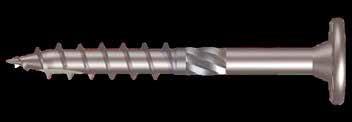
Meanwhile, industry collaborations and co-investments, both at the R&D and the more mature stage, are proving productive and profitable. The IMCRC recently closed shop, saying it leaves a $6 billion legacy from its 70-plus project collaborations with companies, universities and CSIRO. The AMGC continues to look for funding opportunities in the sector, and we highlight one of its first product launches in the Northern Territory
- a remote corrosion management system that has enabled the NT’s first advanced electronics facility. Workplace health and safety continues to be a priority. For a number of years, Industry Update has drawn attention to the dangers of silicosis and recently wrote about the CFMEU’s call to ban working with the ‘killer stone’, the engineered stone in benchtops and other work surfaces that’s behind the life-threatening lung disease. It’s good to see Sixty Minutes focus on the issue recently, which has led to governments doing the same.
And finally, 2023 is filled with unmissable manufacturing expos, including Australian Manufacturing Week in Melbourne in May, and in the same month, the WHS Show will be held in Brisbane for the first time. Also look out for an innovative new food expo, thinkfood LIVE in Sydney in October. Here at Industry Update we’re preparing for another invigorating year in manufacturing, and we look forward to you joining us.
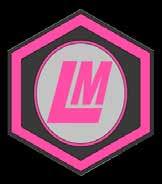
No-one could have missed last year’s explosive news about data security — or some companies’ lack of it — and government was on the front foot in response.
Even when launching its principles for cyber security to members in late October (perhaps in response to Medibank and Optus breaches), the Australian Institute of Company Directors (AICD) had its launch event hijacked by hackers. As the Sydney Morning Herald reported at the time, a fake Eventbrite link – which unsuspecting AICD members clicked on – was posted in LinkedIn’s chat function asking for credit card details. The AICD then had to urgently ask participating members not to use any links posted there and pretty much stop the event in its tracks.
If organisations advising members on security and high-tech data experts at Optus and Medibank were caught out by hackers, Industry Update wondered how manufacturers are challenged by cyber security issues. In our cover story this issue we found manufacturers have much to grapple with.
Not least is the global trajectory of manufacturing in criminals’ crosshairs. If Australia is to follow world trends, by all reports our manufacturers are about to become the top target for cyber criminals as they have elsewhere.


So it’s vital manufacturers protect their intellectual property, all records of staff, customers and business partners — and importantly all their interconnections. Connecting digital systems with external parties means that, no matter how well protected your system is, it is vulnerable if any of your connected partners have weaknesses. You need to secure your back yard but know that your external connections have equally protected theirs.
Our cyber feature this issue outlines the challenges and how to think about cyber security. Next issue we run a manual from cyber and risk expert, Ashwin Pal of RSM Australia, for securing your operational tech (OT) specifically. The OT side of the manufacturing house is the least understood tech and faces the most challenges.

FROM THE PUBLISHER
Publisher Scott Filby
UNIT 3/64 HASSALL STREET SMITHFIELD 2164 PH: (02) 9757 4367 SALES@LMFASTENERS.COM.AU LM FASTENERS PTY. LTD. TYPE 17 WASHER HEAD LMFASTENERS.COM.AU
Editor Christine Powis
8 | Industry Update Issue 130 Feb/Mar 2023 industryupdate.com.au


Minister for Industry and Science Ed Husic
This year is critical for Australian industry as it recovers from challenges either caused or highlighted by Covid. Onshore capacity to safeguard against future supply chain threats will be key.
Local manufacturers’ commitment to greater self-reliance is in no doubt yet many companies continue to be impacted by political, economic and climatic change — made more complex by tightening credit markets here and overseas.

Against this background, the rollout of the $15 billion National Reconstruction Fund (NRF) has assumed even more importance and greater urgency.
The Albanese Government was elected last year with a mandate to revive this country’s ability to make world-class products.

Australia has long been over-reliant on manufactured imports. That trend started well before Covid struck but the pandemic underlined the need to diversify and rejuvenate Australia’s local industries.
By enabling complex value-added manufacturing, we’ll lessen our dependence on overseas supply chains, create more secure, well-paid jobs for Australians, and put the economy on a more sustainable footing.
To help deliver this goal, we’re working to have the NRF up and running as soon as possible this year. The legislation to establish the NRF was introduced into Parliament late in November and I expect it will pass into law soon.
In the meantime, we’re consulting with industry and the community on other elements of the NRF such as its investment mandate, its management structure, and its operational objectives.
The NRF represents a new approach to industry investment in Australia, and a vital new approach to creating real, well-paid jobs.
It will invest strategically in industries that play to Australia’s natural and competitive strengths, that have good growth prospects, and help us address climate change and other national challenges.
Investment decisions will be made by an independent board. The fund’s goal is to achieve a positive return on
investment, as does the Clean Energy Finance Corporation.
The NRF will not provide grants nor duplicate existing government grant initiatives that support early-stage research and development or commercialisation.
NRF will provide finance, including through loans, guarantees and equity, across seven priority areas:
• Renewables and low-emission technologies
• Medical science
• Transport
• Value-adding in the resources, agriculture, forestry and fisheries sectors
• Defence capability
• Enabling capabilities

The NRF will complement other investors to help create the widest possible range of financing options for up-and-coming manufacturers to ensure our most innovative manufacturers and start-ups can grow and be competitive.
We’re under no illusions about the challenges of putting our industry on a more advanced footing. In the 1980s, large parts of Australia’s manufacturing base were uncompetitive after years sheltered behind high tariff walls.
The costs of this protection were unsustainable – and the Hawke/Keating government responded with industry restructuring plans and reduced tariffs. The resulting plans – led by then Industry Minister John Button – helped vulnerable sectors of manufacturing to modernise, innovate and find new markets.
Forty years on, we need similarly transformative strategies to broaden and advance Australia’s industrial base.
The NRF is central to our plans to nurture a new generation of innovative companies — supported by a strong STEM-skilled workforce — to form a competitive, sophisticated industrial sector. It needs to function efficiently. To that end, I urge you to keep submitting feedback around implementation of the NRF.
FROM THE MINISTER
NRF consult.industry.gov.au/ national-reconstruction-fund 10 | Industry Update Issue 130 Feb/Mar 2023 industryupdate.com.au

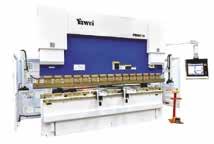
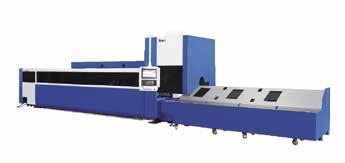
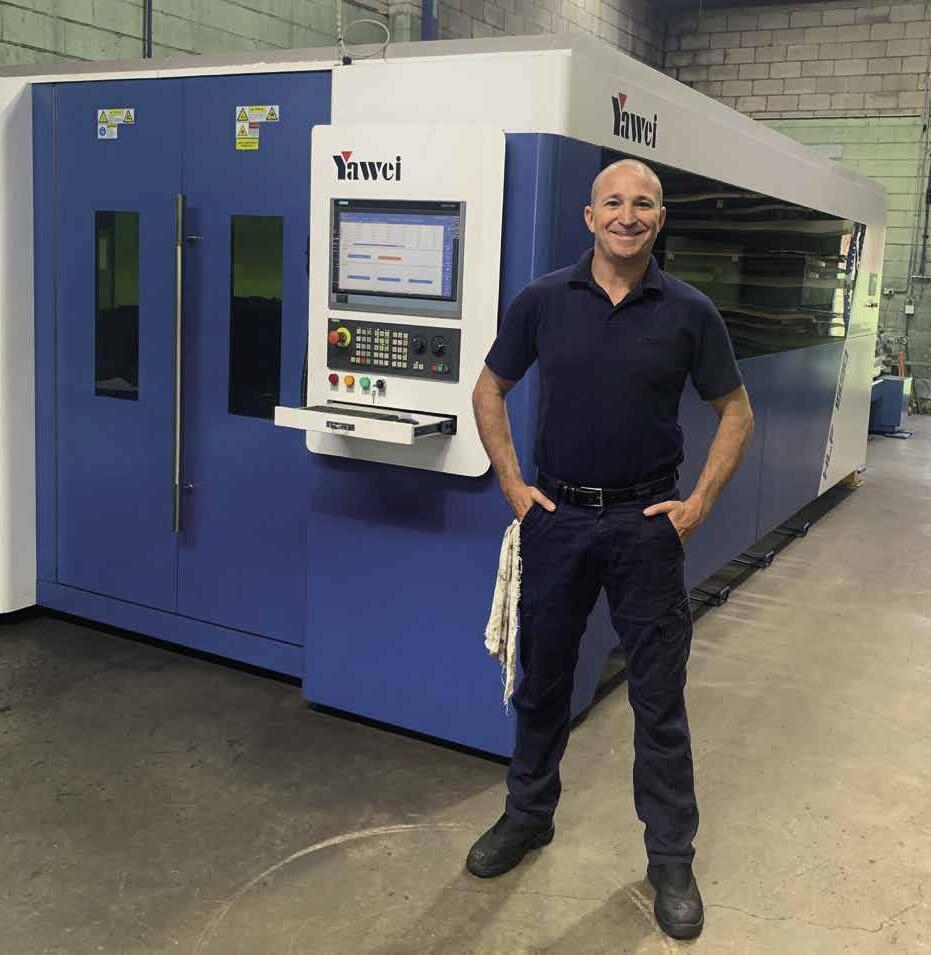
Fiber Lasers • Tube Lasers • Turret Punch Presses • Pressbrakes • Guillotines • Automation Call: Email: Visit: 03 9706 8066 sales@appliedmachinery.com.au appliedmachinery.com.au GROW YOUR BUSINESS WITH YAWEI. THAT’S APPLIED THINKING. Precision sheetmetal processing solutions.
FROM THE SHADOW MINISTER
Deputy Leader of the Opposition and Shadow Minister for Industry
Sussan Ley

Time and time again, I’ve heard a phrase which really frustrates me. You have probably heard it too — “We need to become a nation that makes things again”.
Whenever I hear it, I want to shout back, “Australians do make things here, and we are bloody good at it too”.
That phrase talks down one of the most vital parts of our economy.
Australia has a diverse and dynamic manufacturing sector which gets on with the job, even when government gets in the way, which is all too often.
The job of any government is to facilitate conditions for growth, innovation and further investment.
The LNP’s Modern Manufacturing Strategy, developed in close consultation with industry, set a solid foundation to build up our industrial base.
Take manufacturing complementary medicines for example — in Australia we are world leaders. We are known for great produce, innovation and our
quality-assured products — this is doubly so in medicine and preventative health. It was clear to me as Minister for Health that there’s incredible opportunities in this booming sector.
We have a significant opportunity to take medical manufacturing to the next level through the 2020s and beyond. As the booming populations of south and south-east-Asian middle classes grow, Australian-made medical products should be their first port of call.
Yet there is work to do to get that right. Making medical products and medicines requires state-of-the-art, skilled, advanced manufacturing processes. Governments and industry have to work hand in hand to make the most of the opportunities.
government procurement must function well so that SMEs have the opportunity to provide services and products.
It’s a sector that needs to hit the highest of benchmarks for quality and safety, and rightly so — that is why our products are so sought after.
Take Blackmores, which last year celebrated its 90th year in Australia. This second-generation family business still acts on the founder’s vision and is a household name.
We need to celebrate these success stories. Not play down our national potential.
Complementary medicine manufacturing is a high-demand and high-growth industry. The medical products and medicines sector today supports 30,000 workers across the supply chain, and more than 2,500 manufacturing workers.
The Coalition’s Modern Manufacturing Strategy provided a long-term vision to support the scale and competitiveness of medical manufacturing. It outlined opportunities for Australian businesses based on strengths, emerging industry trends and market potential. We also laid out how industry and government, together, could capture opportunities and address barriers to scale.
And we backed it with investment to support companies that want to grow their manufacturing here.
Building up our medical products and medicines manufacturing requires specific things from governments: they must ensure they build a skilled workforce so the sector can commercialise technologies and advanced manufacturing capabilities.
Governments are the main customers for many medical products so
But regulation needs to balance safety and trust with market access. Government must support businesses as they navigate new markets so they can compete globally. We mustn’t let Australia’s potential success be hobbled by obstacles such as an over-priced energy market.
When the LNP was in government, we backed the medical and medicine manufacturing sector as a national manufacturing priority. We need to see that approach continue.
While we are at it, we need to recognise the good work being done across the manufacturing sector. That starts by acknowledging that we do build stuff here, and we are good at it too.
Attention forklift operators - show off your skills!
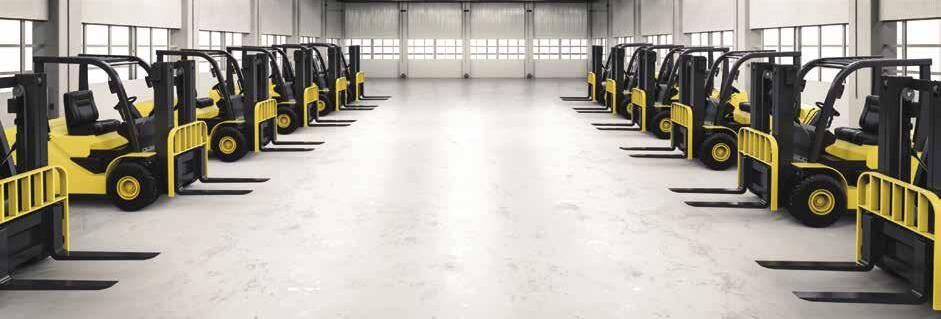
The inaugural Australian Forklift Championship powered by CeMAT Australia is searching for the best of the best in forklift operators around the country. With prizes and bragging rights on the line, the competition will be fierce. Split into three separate events, Male 21+, Female 21+ and Junior, the competition will begin with a self-assessment portion, running from February to May. This will be the opportunity for
competitors to prove themselves against their co-workers in a familiar environment and will be used to choose the competitors for the semi-finals, to be held in Sydney, Melbourne, Perth, and Brisbane.
The semi-finals will be a competition between the top forklift drivers in each state, where competitors will be judged on safety, knowledge, accuracy and speed for the honour of entering the Australian
Forklift Championship finals. Held at CeMAT Australia 2023, the finalists will compete in two competition categories, counterbalance and reach truck. The winners in each category will earn amazing prizes, and the overall winner will become the first ever Australian Forklift Champion, earning the Bill Henman Trophy and industry publicity. Register as either an individual or company. All registration proceeds
will go to the CeMAT Australia Charity Partner, Healthy Heads. CeMAT would like to thank the Australian Forklift Championship Sponsor, Hyundai Forklifts Australia.
“We do build stuff here, and we are good at it too”
“The medical products and medicines sector today supports 30,000 workers”
CEMAT
12 | Industry Update Issue 130 Feb/Mar 2023 industryupdate.com.au
Australia cemat.com.au
First critical minerals plant
An Australian-first critical minerals demonstration facility originally slated to process vanadium will be expanded to process cobalt and rare earth elements in Townsville.
The Queensland government believes the new facility will unlock Queensland’s next mining and manufacturing boom.
“Queensland has the sunshine and wind above the ground combined with the critical minerals below the ground to make batteries and renewables with renewable energy,” said Premier Annastacia Palaszczuk.

Yet to be built, the $75 million facility will cost more than seven times the original planned vanadium processing facility and is expected to commence operations by the first half of 2025. The just-secured site for the facility is at Cleveland Bay Industrial Park, sitting between the Sun Metals (Korea Zinc) zinc refinery and Glencore Copper refinery and is within a few hours’ drive of some of the mines which would use the facility for testing the quality of raw materials which could include alumina and molybdenum.
batteries and advanced materials in Queensland with minerals mined from Queensland.
The facility is a key action in the Queensland Resources Industry Development Plan, and supports the delivery of the $62 billion Queensland Energy and Jobs Plan and the transformation of Queensland’s energy system to deliver clean, reliable, affordable energy to provide power for generations.
The Premier made the announcement while visiting the Sun Metals green industrial precinct.
“Sun Metals is not just the largest private employer in Townsville, it is a world-leading green industrial precinct processing the zinc needed for wind towers and batteries with renewable energy and using hydrogen to store and transport renewable energy,” the Premier said.
Minister for Resources Scott Stewart said there was enormous potential for vanadium mining and production in North Queensland.
“North Queensland provided copper during the second industrial revolution to transport electricity and now stands at the centre of the clean energy industrial revolution,” said the Premier.
“After working with prospective users [miners], universities, and research centres, the facility will not only be able to process vanadium, a key component of large-scale batteries, but it will be expanded for a range of critical minerals like cobalt and rare earth elements to be processed.“
“This facility will prove up the commerciality of critical minerals in Queensland, creating jobs not just in mining but in processing and manufacturing.
“Critical minerals are needed to build the SuperGrid, batteries and the wind and solar farms under the Queensland Energy and Jobs Plan.
The facility is part of a $150 million commitment announced in December 2022 for common user infrastructure to support the development, extraction and production of critical minerals.
The $100 million Critical Minerals Investment Fund managed by Queensland Investment Corporation will further support Australian businesses to compete globally and make
“Global demand for vanadium in batteries and high-quality steel is expected to outpace supply before the end of the decade. Queensland has world-class, highly economic deposits of vanadium in accessible marine shale.
“Because they hold their charge in a liquid form, vanadium redox batteries can be built to a much bigger scale, powering larger communities for longer,” he said.

“Vanadium has the potential to be the ‘Eureka’ moment for North Queensland.”
“There is already interest from companies in using the facility and once the market sees the quality of Queensland’s valuable resources for themselves, they will have confidence to invest in commercial scale facilities and downstream manufacturing infrastructure — creating thousands of good, skilled jobs for Queenslanders.”
The Premier said that Sun Metals and Ark Energy had paved the way for future critical minerals processing plants in North Queensland.
“The opportunities in North Queensland include mining and processing the minerals for vanadium, zinc bromine and iron flow batteries, cobalt and nickel used in lithium-ion batteries, high-purity alumina for LEDs, batteries and semiconductors, rare earth elements used in electronics and silicon for solar panels and semiconductors.”
“Already we have seen Queensland
INDUSTRY NEWS
See more at www.business.gov.au
Pacific Metals secure an agreement with General Motors to supply minerals for electric vehicle batteries.
Queensland Premier Annastacia Palaszczuk Photo: Griffith University
ENCLOSURE CABINET PRECISION COOLING Designed to keep your electronics cool and operating at optimum performance - Cooling capacities range from 30W to 6kW - IP Ratings – IP54 (Indoor), IP56 (Outdoor) & IP66 (Harsh) - Mild Steel Powder Coat and Stainless Steel - Seifert also offer Peltier Coolers, Heat Exchangers Fan Systems, Heaters and accessories – Complete Thermal Solutions KEEP COOL 03 9801 1906 e info@seifertsystems.com.au w seifertsystems.com.au Industry Update Issue 130 Feb/Mar 2023 | 13 industryupdate.com.au
“North Queensland ... now stands at the centre of the clean energy industrial revolution.”
Manufacturing’s cyber status: most attacked industry
by Christine Powis
Greater connectivity brings greater risks as well as efficiencies. Smart factories need to get smart with security on both sides of the manufacturing house – in information technology (IT) and operations technology (OT). This month, we publish the first of Industry Update’s two-part feature on cyber security.*
security breach went out of business, the US Securities and Exchange Commission reported in 2022.
Low-hanging fruit
The speed at which manufacturers are integrating systems to catch up with the rest of the business world means little or no focus on security which makes them easy pickings. Digitisation and systems integration is a new phase for most manufacturers so rookie mistakes are likely and hackers know this.
As manufacturing has digitised, it has experienced more cyber-related incidents, often through interfaces and OT control systems managing industrial operations. OT includes programmable logic controllers and distributed control systems, embedded systems and industrial IoT devices. The latter includes interconnected sensors, measuring instruments, and other smart devices networked with industrial applications, including manufacturing and energy management.
Application Programming Interfaces (APIs) allow different systems to talk and share data. Every time a once-discrete system needs to talk to another, it uses an API and, without the right precautions, increases the attack surface. And, without adequate security, the convergence of OT and IT enables vulnerabilities in one area to be used by hackers to traverse to the other.
operational risks, such as cyber security, were the greatest danger to smart factory initiatives.
Deloitte and MAPI found a significant share of manufacturers which are getting smarter in the production area have yet to build cyber capabilities to secure their new critical systems. While 90% of surveyed manufacturers said they could detect cyber events, very few proactively monitored their OT environments, and less than half had run security assessments in the last six months. Almost one quarter surveyed do not even run annual risk assessments.
Faced with a cyber threat, the report said, these IT and OT leaders are not ready to respond. This is also true when new technologies go online in periods between risk assessments.
Low priority
Industry experts say manufacturers’ attention to security suffers from many factors, not least workplace culture, including security awareness and different teams’ priorities:
• Inadequate training: last year the World Economic Forum’s (WEF) Global Risks Report 2022 declared 95% of cyber security issues can be traced to human error and that insider threats, accidental or intentional, create 43% of breaches across all sectors
insurance than think about the issues. Beware: prices for cyber insurance in the US are skyrocketing: up by 96% in Q3, 2021 alone, and a 204% jump on the previous year, says the WEF.
• Not all IT teams are as security-savvy as they should be, and perhaps too ready to try a work-around that creates a weak spot
• Factory floors’ fear of downtime means systems have not been patched to latest versions so they’re vulnerable
• Old factory equipment that’s impossible to update to work with more secure OT
• Smaller businesses looking for security services can face an unexpected constraint: security providers too busy for ‘smaller’ $100,000 jobs
“Outdated infrastructure and lack of visibility into the OT environment provides attackers with an easy way in,” says John Shier, senior security advisor at IT security company Sophos.
“The convergence of IT and OT is increasing the attack surface and exacerbating an already complex threat environment,” says Shier, referring to gaps between security for production systems and front-office IT.
Patching does mean downtime but it’s vital: most of the significant incidents responded to by the Australian Cyber Security Centre (ACSC) in 2021-22 were due to inadequate patching.

of a patch release or technical write-up. But security measures don’t always mean downtime according to Ashwin Pal, Partner at Cyber Security and Privacy Risk Services with RSM Australia — in fact, most of his recommended OT security measures do not (as outlined in the next issue).
“Even encryption shouldn’t slow things down noticeably for users,” says Pal. “People say it does but it’s usually network configuration and capacity that slows things.”
Observers say every company will experience a security breach that affects its continuity, yet they also say that most SMEs — which typify Australian manufacturing — don’t have a disaster recovery plan.
Complacency
Reports of complacency include one security provider’s survey of manufacturers’ knowledge of their systems and their APIs: it showed manufacturers’ confidence in their system security to be badly misplaced.
Noname Security’s survey found that while 71% of respondents were comfortable and confident in API security, 76% had experienced a security incident and yet 74% didn’t know how many APIs were involved in their systems! Noname had surveyed 600 cyber security professionals in the UK and US in six markets including manufacturing.
“When we go out to an organisation to build an inventory of their systems, we find they’re not aware of 20% to 30% of their APIs – so they can’t secure them,” says Filip Verloy, a Technical Evangelist with Noname.
Deloitte and the US’ Manufacturers Alliance for Productivity and Innovation (MAPI) studied cyber security and risks for manufacturing. Almost half the manufacturers (48%) of 600 IT execs with global firms surveyed by the 2019 Deloitte and MAPI Smart Factory Study said
• OT teams naturally focus on physical machinery, tangible products and maximising production. often wary of ‘interference’, there’s a reluctance to give IT oversight and a tendency for OT to integrate systems ad hoc.
• Business leaders not being IT savvy, not unlike their OT teams! IT advisors struggle to get points on cyber security through to leaders. The C-suite has been criticised for preferring to pay cyber
The ACSC warns that criminals persistently scan networks for unpatched systems offering entry points for higher value targets. Most breaches observed by the ACSC used simple tools and techniques including phishing, targeting third-party service providers and exploiting unpatched or badly configured systems using public vulnerabilities. These methods are low cost and scalable, and exploits can be deployed within hours
External-facing connections are exposed to the world and therefore a greater risk but a rise in phishing has bumped internal APIs onto the risk list too.
“Because phishing is now prevalent and gives hackers valid user credentials, they then log in ‘internally’ as that user, so internal security must be a priority too,” says Pal.
“Security is about securing all layers, not just the main ones. The way networks are now designed means the lines between
CYBER SECURITY
“60% of SMEs in the US which had a cyber security breach went out of business”
“Systems integration is a new phase for most manufacturers so rookie mistakes are likely and hackers know this.”
14 | Industry Update Issue 130 Feb/Mar 2023 industryupdate.com.au
Continued from front page
internal and external are very blurred.”
Pal recommends all APIs be controlled with strong authentication, authorisation, and logging controls, and be backed by regular penetration testing to detect any vulnerable APIs.
Broken rules
Experts say the ‘triple-A’ rule of security — authentication, authorisation, and accounting — has not failed.
“The problem is it’s often not applied properly, as in last year’s Optus and Medibank cases,” says Pal.
“Big companies often outsource development and testing new developments to other countries but, with outsourcing, rules are more likely to get broken.”
successful, highly sophisticated supply chain hack. SolarWinds made what seemed a routine software update available for its network management software, Orion, but it had been planted with malicious code, which was far-reaching because as network management software, Orion is in contact with entire networks.
The technique was so advanced, it is believed Russia was behind the action: they found a way to infiltrate Orion’s sealed code and to create a system that used domain names to select targets and mimicked Orion’s communication protocols so they could hide “in plain sight”, as radio NPR put it.
Naturally, many of Orion’s subscribers downloaded and deployed the malicious updates. Even by the conservative, best estimate of the SolarWinds’ CEO, Sudhakar Ramakrishna, 18,000 customers were affected, numbering about a dozen government agencies including the Pentagon, Treasury, Justice and Energy Departments and 100 companies such as Microsoft, Intel and Cisco. Understandably, the government went into overdrive with sanctions and executive orders.
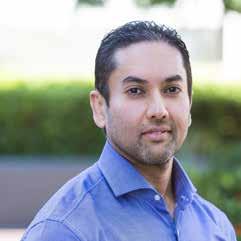
Government policy
Industry observers believe Optus had a test system set up by an outsourcer with an API open to the Internet so anyone on the Internet could access the test system, and the test system had production data — actual customers’ data.
This view sees the hacker accessing Optus data without authentication, without authorisation, and without any accounting because no logs were generated for what was done so no one knew what was accessed, and importantly, that the data was not masked or otherwise represented.
Optus claims this was not the case.
CIO Mark Potter says criminals made concerted efforts to bypass Optus defences to steal data, that it was a malicious and persistent attack, and not at all like data being accidentally left out in the open, as Home Affairs Minister, Clare O’Neil suggested.
Third-party threats
As the Optus breach shows, your security is only as good as your business partner’s. This is crucial for manufacturers connecting with third-party suppliers, customers, developers and, some suggest, even security service providers.
Connections with partners multiply weaknesses and enhance the attraction for hackers. As US cyber security consultancy Mandiant says in its M-Trends 2022 report, “the supply chain is as attractive a target as ever, providing a potential entry point into multiple vendors.”
The attack on US software company SolarWinds in 2020 was a frighteningly
More recently, in July 2021, supermarkets in Sweden closed after a cyber attack on its IT services provider based in Florida. Then in February, 2022, an attack on satellite services in Ukraine forced electricity-generating wind farms to shut down across central Europe.
Whether on the cloud or on premises, businesses must be confident of the security of any externals with which they connect. Potential business partners can offer their bona fides but a manufacturer needs to diligently discover their true security posture, all their precautions and if they’re vulnerable. Any manufacturer should want to know if its potential business partner has suffered breaches, how these happened, the outcomes and how future breaches are being prevented.
If a manufacturer is considering links with big companies, even a Google search can find mentions of breaches in an annual report or media reports. A manufacturer can give a potential partner a questionnaire to investigate what access is required, why they need it, who in their organisation would have access, and all protocols observed to get access and during access.
Vetting potential third parties is a business in itself: companies such as Upguard specialise in risk management of the attack surface and connections
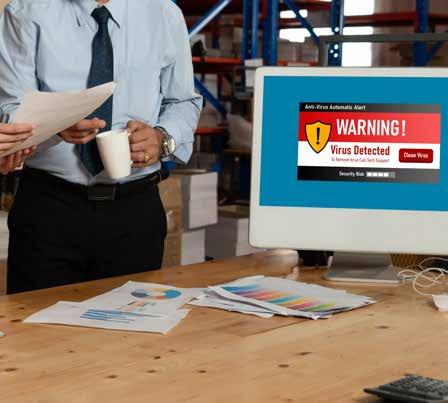
Following the Optus and Medicare breaches last year, Home Affairs and Cyber Security Minister, Clare O’Neil announced Australia was “punching back” with a new team of 100 cyber crime experts to proactively hunt down cyber criminals. The team is being put together by Australian Signals Directorate and Australian Federal Police.
Businesses’ obligations
Under the Privacy Act, data breaches are when personal information is accessed without authorisation, is stolen or lost, including employee records.
Companies with revenues of $3 million or more must take reasonable steps to protect personal information and must report breaches both to the Australian Privacy Commissioner and to people whose data has been affected within a reasonable, practical timeframe.
The Labor government reacted to last year’s high-profile breaches by hiking fines for companies failing to adequately protect data or report
with partners including ongoing monitoring of partners and automating security questionnaires. Many manufacturers hire security consultancies to thoroughly vet potential partners.
The WEF found that 39% of respondents to its survey had been affected by an incident originating with a third party, reporting that “They were ‘collateral damage’ after their operations were disrupted by attacks on companies
breaches, up from $2.2 million up to either:
• $50 million or more
• thrice the benefit obtained from misuse of data, or
• 30% of a company’s turnover for the relevant period
Penalties will be decided caseby-case by the Australian Privacy Commissioner. See www.oaic.gov.au Company directors were this year also put on notice that they can be scrutinised by corporate regulator ASIC if they failed to prioritise cyber security and their businesses are hacked by cyber criminals.
The government has advised companies not to pay ransoms to hackers and is considering further policy reform including whether to make paying ransom illegal.
For firms managing critical infrastructure and essential goods or services (groceries, transport, health), more strict obligations include timeframes for reporting to Australian Cyber Security Centre. See www.cisc.gov.au
from whom they bought or to whom they sold.”
Almost all respondents to the WEF (90%) were concerned about the cyber resilience of third parties which had access to their systems, and businesses are reacting to rising threats by strengthening controls for connected third parties and re-evaluating countries with which they do business.
“76% had experienced a security incident and yet 74% didn’t know how many APIs were involved in their systems!”
CYBER SECURITY
Industry Update Issue 130 Feb/Mar 2023 | 15 industryupdate.com.au
Ashwin Pal, Partner Cyber Security and Privacy Risk Services, RSM Australia
Top target
Manufacturers made up 23% of the attacks that IBM’s X-Force team of responders, hackers, researchers and analysts remediated in 2021.
In Asia, manufacturing was targeted almost as much as financial services (29% vs 30%).
Ransomware
The ACSC is not alone in pointing at ransomware as the most destructive cyber crime.
While cyber crime is diverse and huge in scale, ransomware is a threat on multiple levels. Ransomware’s impacts include business disruption from locked away or encrypted data. Despite a good backup system which can get a business running again, manufacturers’ intellectual property can be abused and they also face reputational damage if stolen data is released or sold on. Even when ransom is paid, a business cannot trust a thief to not continue to abuse stolen data. And then there’s the clean-up and reconstruction of more secure systems.
Ransomware has a good success rate for hackers, it’s easily spread and cheap to deploy. ACSC responses to ransomware incidents in 2020-21 went up more than 75% compared with 2019-20, racing ahead of growth of total number of reports, up by only 13%.
Ransomware attacks occur because:
1. An employee clicks on a phishing link that downloads ransomware
2. Hackers pick up credentials from remote access users, often individuals using their own device. A hacker can intercept staff member’s remote access either by phishing or details bought on the dark web
3. Hybrid working has increased both attack surface and attack numbers. Companies with remote users expose many applications and their internal system structures to the world.
The ACSC’s and government’s advice is not to pay ransoms to hackers, and Home Affairs this year said it is considering making ransom payments illegal. See the ACSC’s Ransomware Prevention and Protection Guide.
Ransomware was the most common type of attack on manufacturers, making up almost a quarter of attempts.
While malware increased by 358% in 2020, ransomware increased faster, by 435%, the WEF report in 2022. It also noted a four-fold rise in the known collective value of cryptocurrency received as ransomware in 2020 over 2019.
Australian manufacturers seem to have dodged a storm of cyber bullets so far.
In mid-2022 the Australian Cyber Security Centre (ACSC) reported that only 4% of Australian incidents to which it responded attacked manufacturing, and financial services was similarly affected. Meanwhile the federal government copped most of the attacks — at 24% and state governments 10%, with the health sector experiencing 9% of incidents involving the ACSC.
Although sophisticated, the financial sector was an obvious target so it advanced its security further, and now thieves look elsewhere.
While the highest profile breaches in Australia have been public-facing organisations, bad actors are attracted to manufacturers because they’d be decimated by loss of intellectual property or downtime. Not only that, low tolerance for downtime can also mean manufacturers might not have adequately patched and protected their systems.
As Sophos’ senior security advisor John Shier says, “Manufacturing is attractive for cyber criminals due to the privileged position it occupies in the supply chain.”
That was clearly flagged by the mid2021 ransomware attack on big meat processor JBS when its US network stopped for several days — leading to disruption across the US, literally piles of dead animals at its door, a $14 million ransom and more in losses and system clean-up costs for JBS.
Sophos’ 2022 report State of Ransomware in Manufacturing and Production found that cyber incidents demanding ransom are increasing for manufacturers, up by nearly 20% on 2021 but it still saw what it called a “low” attack rate: 55% of surveyed manufacturers reported ransomware attacks. Sophos surveyed 5,600 IT professionals in mid-sized firms across 31 countries,
including 420 in manufacturing and production.
Sophos’ also found manufacturing and production paid the highest average ransom of any business type at more than US$2m, far higher than the cross-sector average of US$800,000. In Australia ACSC’s much lower count on the average cost per cyber crime reported to it here was $39,000 for small businesses and $88,000 for medium-sized businesses.
Interestingly, Sophos reported that of those manufacturers breached and held to ransom, most did not pay the ransom: 36% paid compared with payments by 46% average across sectors.
Original sin
Insecurely designed equipment can create a problem from the start. Integration aside, risk can be inherent in products a manufacturer uses: the US Cybersecurity and Infrastructure Security Agency lists more than 1,200 known OT system-related cyber security issues as Common Vulnerabilities and Exposures (CVEs) that arise from more than 300 OEMs and system providers.
In the first half of last year, the agency found 560 CVEs, most of which were new. Of those CVEs reported, 131 affected multiple sectors but manufacturing was the most directly affected sector: it suffered 109 reported system CVEs.
RSM’s Pal says OT devices are often made by industrial equipment manufacturers and although their devices have computing code, they are not designed with cyber security in mind so they are inherently vulnerable.
“It could be robotic arms in car manufacturing or extruders of aluminium cans run by computer code – made by machine makers that are not cyber security experts. I know manufacturers of large systems that have had vulnerabilities come up when there’s a cyber breach when the equipment’s on the factory floor.”
Evolution
While many cyber crimes are becoming more sophisticated, they’re also being tried out by less skilled actors through ‘cybercrime-as-a-service’ (CaaS) on the black-market.
ACSC reports that CaaS’s ever-increasing range includes provision of server infrastructure used to host cyber crime campaigns, the sale of access to compromised victim networks, money laundering, and development and obfuscation of malware.
Ransomware-as-a-service (RaaS) provides technically unskilled bad actors with ability to launch highly profitable attacks. In addition, the CaaS industry allows actors to monetise their

“Leading to literally piles of dead animals at its door, a $14 million ransom and more in losses”
“They were ‘collateral damage’ after their operations were disrupted”
CYBER
16 | Industry Update Issue 130 Feb/Mar 2023 industryupdate.com.au
SECURITY
Resources
The Australian Cyber Security Centre offers guidelines on security focus areas at cyber.gov.au/acsc/view-all-content/ ism/cyber-security-guidelines

That same page can link you through to specific guides for SMEs, bigger firms and infrastructure organisations including security for small business assets on the cloud and how to report a breach. The ACSC offers Essential Eight mitigation strategies for MS Windows-based networks, Strategies to Mitigate Cyber Security Incidents and an Information Security Manual.
• There is advice on ransomware, Business Email Compromise and other threats.
• If you suspect a cyber security crime and need advice, call the Australian Cyber Security Hotline on 1300 292 371
• IBM X-Force Threat Intelligence Report 2022 is at ibm.com/downloads/cas/ ADLMYLAZ

initiatives, Deloitte found the value delivered to be worth the risks. What is urgently needed, Deloitte says, is a holistic approach to the OT and IT environments and prevention and mitigation plans that focus on secu


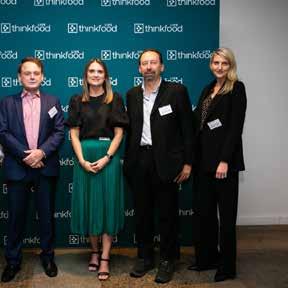



SOCIAL SPOTLIGHT
CYBER SECURITY
The Cybercrime as a Service (CaaS) ecosystem offers functions to malicious actors who can then outsource the skills they lack
Industry Update Issue 130 Feb/Mar 2023 | 17 industryupdate.com.au
Cyber security for manufacturers’ legacy OT
 by Christine Powis
by Christine Powis
Cyber security firm LogiTech is partnering with Aria Cybersecurity in the US to set up a local 24/7 security operations team in Adelaide to support Australian clients using Aria products - including a new release designed to protect older, legacy systems on which manufacturers’ operational technology often relies.
Logi-Tech’s Managing Director Peter Moore has worked for the Australian Defence Department (ADF) and his Australian cyber security customers include critical infrastructure, energy and state and federal government agencies, as well as the ADF and companies aligned with it.
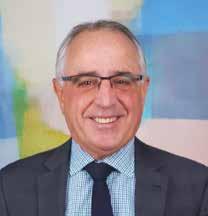
data in March when the new AZT PROTECT for older OT environments will also be available.
The Adelaide SOC will be trained by Aria’s US team and initially rely on the experience of Aria’s US SOC for interpreting data about any unusual behaviour which could flag a cyber threat.
Aria’s ADR offers automated threat detection, isolation and containment within seconds, thanks to its data engine’s use of artificial intelligence (AI), machine learning and behavioural models developed by Aria.
Logi-Tech has 37 years’ ICT and security experience and already distributes Aria’s Advanced Detection and Response (ADR) system and will distribute and support Aria’s new AZT PROTECT which stops threats to legacy industrial systems.
“Competitor products offer detection and sometimes containment within one to three hours,” said Aria’s Vice President and General Manager, Gary Southwell, who has found manufacturers’ and heavy industries’ attitude to cyber security has changed in the last four to five years.
“Industry attitudes have changed since intrusions by Dark Side,” said Southwell, referring to the notorious network of cyber criminals who, for example, in 2021 paralysed major US fuel distributor Colonial Pipeline, halting half the US east coast’s supply of diesel, petrol and jet fuels.
solve those problems for industry.”
Aria’s ADR can be run remotely from anywhere by one staff member, hence its moniker ‘SOC in a box’. However 80% of Aria clients prefer to use Aria’s SOC team to interpret the data and scope of a threat, contain it and then advise the client on action to be taken.
Moore expects that, within a few months, it will be supporting local clients as the US team does – monitoring and investigating threats, managing alerts and containment then advising the client on immediate action and ways to prevent the problem in future. The client’s IT team
Aria is a division of 68-year-old, publicly listed CSP Inc and originally built radars for US defence agencies. It has since worked with the world’s foremost defence intelligence agencies in the US, the UK, Australia and Canada on special projects.
Moore believes that keeping the data and security operations centre (SOC) in Australia maintains data sovereignty compliance, and keeps businesses and their data safer.
“Setting up Aria’s customers’ data here in Logi-Tech’s Adelaide data centre makes sure data doesn’t go out of the country — this reinforces not only an organisation’s security but also its sovereignty of data and governance — unlike other cyber security platforms where data goes to engines to be analysed in, say, Germany or India.”
Logi-Tech’s data centre will be running and supporting local customers’
“Bigger manufacturers have gotten smarter — they now know what the ramifications are — no one wants to explain in their quarterly report why their revenue dropped suddenly because they didn’t take cybersecurity seriously.”
“If companies’ processes go down, they know it could lose them a million dollars a day — those companies we don’t have to convince,” said Southwell. “They need not just detection but immediate containment to happen within minutes when critical systems may be a target – this is what we built our ADR solution to achieve. We can offer them SLAs which commit to detection, isolation and containment in minutes, not multiple hours or days to stop an attack.”
“Then you’ve got manufacturers with OT environments and old systems that are not constructed to take traditional IT-level products and can’t be updated — so they struggle with security. That’s why we’ve come in with Aria AZT PROTECT to
Aria ADR stops many types of attacks including intrusions, ransomware, insider threats, brute force, distributed-denial-of-service attacks, data exfiltration, malware, compromised credentials, and policy violations. Its detection speed is possible because it takes in data from all connected network packets, devices, event logs – the lot –which goes into an engine that uses AI to detect attacks and machine learning to understand normal versus unusual behaviour. The analytics engine then filters, correlates and identifies actual threat behaviour and its scope.
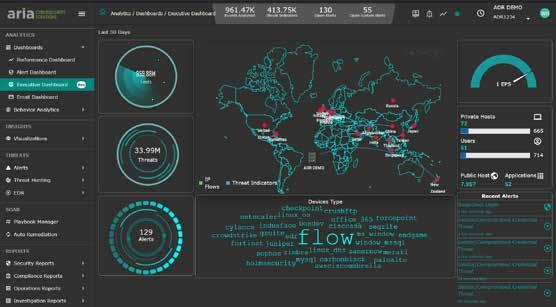
It does not rely on teams of people to weed out false positives. Detecting unusual and actual threat behaviour is key: the product’s designers developed 60 models of threat behaviour and its SOC team is highly experienced in interpreting these.
Many companies get thousands of threats every day; local bank NAB reports 50 million attempted attacks a month. Without AI, machine learning and expertly framed behaviour models, even just a few thousand threats a day would take a team of about 100 experts to filter out false threats from the actual and raise an alarm.
Initially Logi-Tech’s SOC in Adelaide will rely on training and support from Aria’s US SOC when Logi-Tech runs trials with its Australian customers in March.
Peter Moore,
Managing Director
can then take on the project.
“The beauty of Aria compared to the rest is that it deploys so easily, and in a format which enables users to have visibility into the system and work with it if they want to either manage it themselves or simply gain insights,” said Moore.
Southwell says Aria is unlike “other big security guys who say ‘we’ll call you when there’s a problem’ — but then give clients no access or visibility into the system.
“We’re an open book as far as clients go: they can look in and see that we’re ticketing alerts as we’re watching new behaviours and they can ask us about what’s going on.”
CYBER
SECURITY
Gary Southwell, Aria Cybersecurity’s Vice President and General Manager
Logi-Tech’s
“Industry attitudes have changed since intrusions by Dark Side.”
“Logi-Tech will support Aria’s AZT PROTECT to stop threats to legacy industrial systems.”
Logi-Tech logitech.com.au 18 | Industry Update Issue 130 Feb/Mar 2023 industryupdate.com.au
Aria ADR’s top-evel user interface dashboard.


#CeMATAus cemat.com.au Innovation & Industry 4.0, the Future of Intralogistics, Warehousing , Automation, Materials Handling and Supply Chain Management R E G I ST R AT I O N S O P E N N OW Including: 25 – 27 July 2023 The Dome, Sydney Olympic Park
Australian manufacturing trends in 2023: more automation, micro-training and a focus on energy
 By Margie Smithurst
By Margie Smithurst
While Australian manufacturing continues to be affected by the pandemic’s challenges, geo-political factors and clouds of global recession, it faces new trials as well as potential opportunities. With that in mind, what sort of trends can we expect in the sector in 2023?
Industry Update sat down with Ben Kitcher, the Executive Director of Research and Technology at Western Parkland City Authority, who is leading the development of the Advanced Manufacturing Research Facility (AMRF) opening in Western Sydney this year.
Industry Update: First of all, tell us a bit about yourself, and why you’re a good person to talk to regarding manufacturing trends.
Ben Kitcher: I’ve been involved in manufacturing technology since 2006. I was incredibly fortunate to join a very new team working on advanced manufacturing in the UK [the Sheffield Advanced Manufacturing Research Centre]. I didn’t quite realise at the time the opportunities that lay ahead in terms of being able to work on advanced manufacturing technology for high value applications, and the way in which those technologies would take off. So I was in the right place at the right time, able to join a really visionary team of people who had a large impact on the UK manufacturing sector. And today, I’m working to bring some of those insights and understandings on how to apply manufacturing technologies to our project, the AMRF which will be in Bradfield, in Western Sydney.
Automation value
Industry Update: Which brings us to what you see as some of the key trends across Australian manufacturing in 2023.
Ben Kitcher: The first is a continuation of something, but I think we’ll see a greater uptake in terms of automation technologies. And within automation, I include digital technologies - automation back office processes related to manufacturing. Automation goes hand in hand with greater productivity and profitability of the manufacturing business, so that’s fantastic. It also goes hand in hand with increasing the value added per worker per job, and that’s something that both the business and the individual have a keen interest in demonstrating.
The NSW Productivity Commission recently released a report titled Adaptive NSW, in which they highlight a potential “productivity dividend” of $27,400 per household by 2034-35 in today’s dollars. The basis of these benefits are in the adoption of new technology, including automation.
Automation also addresses a longterm deficiency in market availability for skills - it’s a key part in addressing the skills gap. We keep looking for the same skills that we were looking for a decade ago in machinery operators and technicians. And I think the opportunity to look forward and say that automation is key to resolving some of those skills gaps, is one that industry is coming to. Automation technologies are becoming more commoditised and more affordable, and the vendors and suppliers of the automation tools are also understanding
that accessibility is key.
Lowering the barrier to entry for automation technologies is a huge objective of theirs, and therefore greater implementation or at least spotting the opportunity and making inroads into implementing automation technologies will continue to be a big trend of 2023.
Micro-training shift
Ben Kitcher: I also think our training mechanisms are a key point of differentiation. We’ll continue to see the change from credentialism to micro-training, and picking up the vocational skills necessary to implement multiple automation technologies.

It’s about working with vendors of technologies and tertiary education providers to run very short courses that give just enough to implement a technology which is right for you and your business. And that’s how we can respond quickly to the needs of increased automation.
That’s what we’re trying to do with the New Education and Training Model (the NSW government program rolled out in March 2022, also offered in other states and federally). We have a number of micro-credentials up and running through that.
The first cohorts have been through that and the feedback we’ve had from learners and their employers has been outstanding. So they’re really valuable, tangible and actionable skills that they’ve
Western Parkland City Authority’s Ben Kitcher is leading the development of the Advanced Manufacturing Research Facility (AMRF)
learned in a very short amount of time and can take straight back into the business. This isn’t a full degree’s worth of content which may or may not get used, and from personal experience and my engineering degree, that’s exactly what happens - you may or may not use it. Micro-credentialing really seems to address the needs of what industry wants.
MANUFACTURING TRENDS 20 | Industry Update Issue 130 Feb/Mar 2023 industryupdate.com.au
Focus on energy Industry Update: What other trends do you foresee?


Ben Kitcher: The other one that I think is an increasing trend, and one that we’ve not necessarily been consciously moving towards, is energy efficiency and energy diversification. And 2023 will be a year where this really starts to take hold.
I’m sure there are businesses and
necessarily been successful in deepening Australian supply chain participation.
There are many areas of supply chain capability that warrant a greater focus – valve assemblies, lightweight aero structures, and actuators, amongst others. These types of sub-systems and their components are product specific, but widely applicable to various defence products.
We also know that there are very capable manufacturers of these types of components in Australia, and that with support and the right opportunity, these valuable products could be sourced domestically. There is an opportunity to significantly increase Australian content in defence contracts, and to broaden that impact from hotspots of activity where projects are integrated to widespread value creation.
companies who are very conscious of energy and do make big efforts to reduce their use, but on an industry wide basis, I think there’s a very long way to go from an efficiency and energy source diversification point of view.
Australian manufacturing hasn’t had the same pressures that manufacturers elsewhere in the world have had, particularly from an energy price point of view, and in some cases, stability of supply. That’s been a massive, massive factor in places such as Germany and the UK. We should prepare for those types of shocks to come through the system in Australia, and understand that the risk profile that comes with high energy intensity operations will be a trend for 2023.
I think it’s something which will be at least a decade-long focus for the manufacturing industry, and every decision we take henceforth, energy will be a very key consideration. Whereas at the moment, we are still looking at power availability as an absolute limit in what operations we can implement.
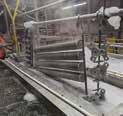
Today, we rarely consider how many units of energy per annum we’re working through, where we’re sourcing those, what the potential price fluctuations could be, and what their security is. I think these factors will become more commonly considered throughout next year and beyond.
Eyeing the defence pie Industry Update: It’s interesting how much Australian manufacturing seems to be positioning itself towards the defence sector. Do you see that as a trend?
Ben Kitcher: Yes, definitely. When you’ve got a confirmed market of $270 billion, plus export potential, it makes perfect sense. And I think we ought to support Australian industry in accessing as much of that as possible.
I’ve looked at the very much project-based focus for securing Australian content into various defence contracts in the past, I can see that it hasn’t
The barrier to making this happen is legacy and the practical aspects of managing an unfamiliar supply chain. Because we don’t have the aggregated and defence-proven capabilities in Australia that you do elsewhere, i.e., you don’t have very large companies managing sub-tiers of supply chains, we must work with many smaller companies representing a large manufacturing industry. So that’s a challenge that we need to address – not by changing the industry, but how the supply chain becomes established and functions.
capable. The level of innovation that is repeatedly released by our labs in photonic devices, transceivers, RF devices, and more recently, quantum is genuinely world class. Organisations such as the Australian Nano Fabrication Facility [ANFF] have been supporting this development for many years. But we don’t yet have a really solid, sensible, or competitive pathway for those technologies to be industrialised, or productionised here in Australia. And we should! They’re critical to our security and highly exportable, so not tied to our domestic market or consumption. So that’s what we’re working on, we can see a long-term plan.
I think the second half of this decade is our opportunity to really see an at-scale presence in the semiconductor industry, but we must start building on the foundations now.
Industry Update: Although we may be about 20 years behind the UK in establishing facilities like the Tonsley ‘Factory of the Future’ in SA, and the AMRF in Bradfield, which you will be running and which will provide technology trialling and testing for Western Sydney businesses, the fact that it’s happening at all is extremely promising, isn’t it?
Ben Kitcher: The main attractor to the AMRF and Western Parkland City project for me was coordination. The fact that governments are really getting involved, not just in the central funding of the centre and leaving someone else to do it, the government is taking this on and doing it.
In the case of the AMRF it’s part of a multibillion-dollar project to build the city of Bradfield, including public transport, city infrastructure, education, with investment attraction, the whole thing. The potential here for Australia to be more successful, in a shorter timeframe than the UK has done, I think is great. And that genuinely is the reason I wanted to join the project.
Certainly, the implementation of digital manufacturing technologies will help. The ability to manage the supply chain more effectively using those technologies is something that over the long term will help integrate more smaller businesses in such high value contracts.
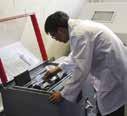
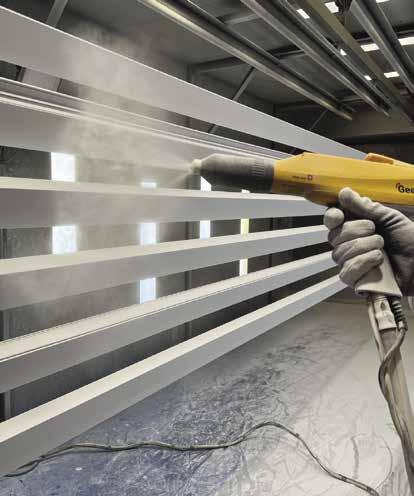
Semiconductor groundwork
Industry Update: With the geo-political shifts in advanced chip manufacturing, there’s now talk of the need for an Australian semiconductor and advanced electronics manufacturing sector. The AMRF intends to focus on this in its second facility, which will come online in 2026, but what do you see in the immediate years ahead?
Ben Kitcher: From an industrial and production point of view, 2023 won’t be when Australia takes a significant share of the global semiconductor industry, but lots of groundwork is being done. Our existing semiconductor industry will continue to manufacture but they’ll be in relatively small volumes, and in terms of the overall makeup of the Australian industry, still small. Our opportunity is looking further down the track. Our laboratories and businesses in Australia are unbelievably
MANUFACTURING TRENDS
“2023 won’t be when Australia takes a significant share of the global semiconductor industry, but lots of groundwork is being done.”
“Every
PROTECT WHAT MATTERS PROTECTIVE COATINGS DESIGNED TO LAST. MAXIMISING PROTECTION & PERFORMANCE [02] 9603 1888 info@deco.net.au deco.net.au/protective-coatings A N ODIS I N G HARD A N O DI S IN G SPE CIA LT Y F IN I S H E S Sustain your components and add longer life and durability to your equipment with DECO’s range of protective coatings. With a wide variety of finishes offering superior corrosion, chemical, abrasion and wear resistance, DECO can help find a solution for your project requirements, and protect your components in the toughest of applications. Contact our team to discuss your project today Industry Update Issue 130 Feb/Mar 2023 | 21 industryupdate.com.au
“Very short courses that give just enough to implement a technology which is right for you and your business.”
decision we take henceforth, energy will be a very key consideration.”
Review: what’s working and what’s not
By John Spender, Director, William Buck
As we dive into a new calendar year, industry leaders are asking themselves “what’s the future of the manufacturing industry? And what position does my business occupy?”
In this four-part series, William Buck Accountants and Advisors share strategies that manufacturing leaders can employ to adopt new ways of thinking and cement their positions in the market.
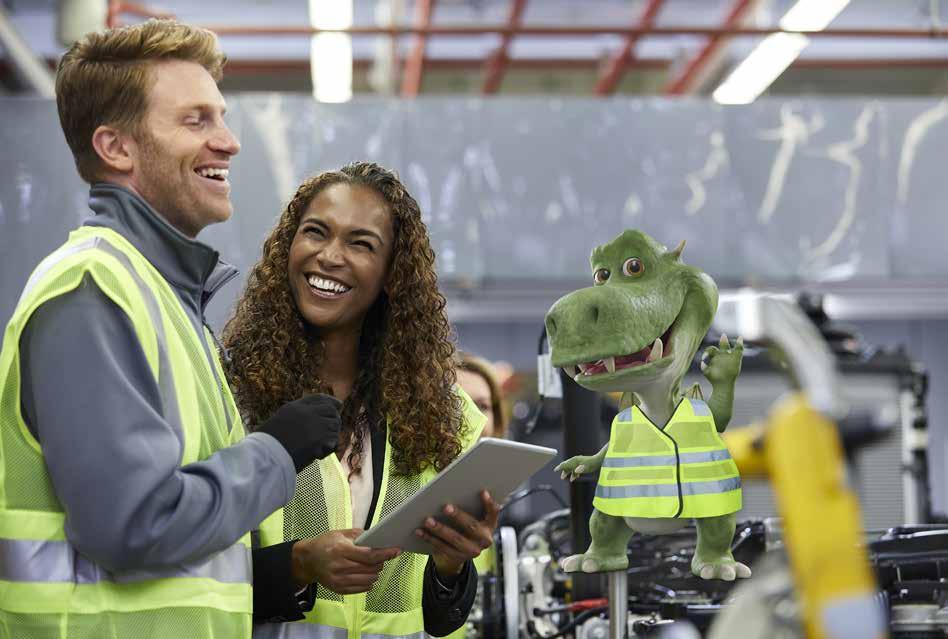


These strategies fall into 4 key areas
• Revive: Immediate actions for restarting
• Review: What’s working and what’s not
• Refocus: Strategy and planning
• Thrive: Growth and opportunities
The new year is the perfect time to undertake an objective review of your operations and procedures. Take this time to identify the areas that are driving value in your business and any key issues that could be impeding your strategic goals. Five key areas to review include:

Review your operating model
Has it changed during the last two years and how will it be impacted as the economy kicks off? Is your organisational structure still appropriate? Are you happy with how your functional areas are organised?
Assess your customers and their buying behaviours
It’s never been more important to understand where your revenue comes from. While you may enjoy a large customer base, the truth is that not all customers are profitable, and in fact some customers may be costing you money. Who are your key customers and what they are buying from you? What is the cost of fulfillment and your rate of return? How do you target your high growth or high profit customers?
Review
your suppliers
If you’re reliant on specific suppliers
and have had challenges during the pandemic in maintaining supply, take the time to diversify. It’s important to be aware of the red flags that could point to your trading partners’ future insolvency.
Get on top of your inventory
Ensure you know your stock levels at any given time and can identify fast or slow-moving stock. It’s also never been more important to have sufficient job costing mechanisms in place and to be aware of what materials are required and when they are needed.
Is your technology working for you?
Change in the technology sector continues to accelerate. Do your current software solutions enable your strategic plans? Are your different systems integrated - for example, does your inventory management integrate with your financial software? Are there areas that you could automate to achieve greater efficiency? Do you need to upskill your workforce to take advantage of new technology?
Look out for the third part in the series
‘Refocus: strategy and planning’ in the next edition of Industry Update.
For a complimentary consultation on your business strategy contact the experts at William Buck at 02 8263 4000 or www.williambuck.com
45,000
27,000
Why not spend:
1hour focusing on your business? The William Buck Hour
2,550
In your lifetime, you will spend: hours handling emails hours in Zoom meetings hours making coffee
STRATEGIC PLANNING IN JUST ONE HOUR
The William Buck Hour is designed to help middle-market businesses assess their current position, realign thinking and maximise their business’s potential. In just one hour, we’ll guide you through a detailed discussion structured around a range of key fundamentals. Following the session, our advisors will conduct an analysis of your business using commercial insights, professional experience and best practice standards to develop a prioritised action plan for your business.
The end result is a fresh perspective and a focused strategy to help you move forward. williambuck.com
BUSINESS, FINANCE & ACCOUNTING
22 | Industry Update Issue 130 Feb/Mar 2023 industryupdate.com.au
William Buck williambuck.com


Ready, Set, Grow Transform your business with the help of our Manufacturing and Wholesale specialists, dedicated to connecting you with solutions that meet the unique needs of your business. If you’re ready to fire up your business, talk to us today. Things you should know: T&Cs, fees, charges and eligibility and credit criteria apply. © St.George – A Division of Westpac Banking Corporation ABN 33 007 457 141 AFSL and Australian credit licence 233714. COM 0348 0223 STG Manufacturing & Wholesale Matthew Kelly Head of Manufacturing & Wholesale 0412 265 197 manufacturingwholesale@stgeorge.com.au stgeorge.com.au/manufacturing
‘Customs’ can boost your business
Many manufacturers might not know that Australian industry saves around $1.8 billion each year in concessions or duty not paid — by companies benefitting from the Tariff Concessions System, administered by Australian Border Force. This is the first in a series of articles by the ABF to help manufacturers understand that ‘customs’ officers can help them improve their businesses’ bottom lines.
Readers will be more than familiar with customs duty imposed on imported goods, the amount determined by the goods’ tariff classification. Importing manufacturers can obtain duty-free entry for goods through Free Trade Agreements and use of duty concession schemes, such as the Tariff Concession System.

The Australian Border Force administers the Tariff Concession System (TCS) to help Australian industry and reduce costs to the general community where the imposition of a tariff serves no Australian local manufacturer, i.e. where no substitutable goods can be produced locally. Businesses large and
small benefit from reducing duty by applying for a new Tariff Concession Order (TCO) to be created or by using an existing TCO.
There are approximately 15,000 TCOs registered as of December 2022. The reason there are so many TCOs is that each order must contain a precise description of the goods covered, and a tariff classification. If a type of goods is not covered, a new TCO can be applied for and if successful, created by the ABF.
When applying for a new TCO to be created, applicants need to make a formal application and provide evidence of reasonable grounds for the order. The ABF receives more than 500 new TCO applications each year from importers for goods from around the world but especially from countries not covered under a Free Trade Agreement.
Machines of all types make up the most
commonly applied for TCOs from ice cream machines to packing and labelling to milling machines, and the ABF is happy to receive a new application for any good that is imported and duty paid.
Whether you are importing a component for a good manufactured here in Australia or a machine to upgrade production capability, or an integrated system, a TCO could be beneficial.
The range of TCOs is extensive, covering everything from wheel nuts or tape or wood chippers to a complete materials handling system, all imported duty free.
TCO applications are reviewed as outlined in a two-stage legislated process. Stage one assesses the validity of the application. Stage two requires the ABF to determine whether a new TCO will be made up to 150 days after acceptance of an application and publishing in the Commonwealth of Australia Tariff
Concessions Gazette.
A TCO decision in stage two is based on the information contained in the application, subsequent submissions from the applicant, any objections from local manufacturers to the proposed TCO, and the results of any additional enquiries made by the ABF.
A weekly Commonwealth of Australia Tariff Concessions Gazette (the Gazette) publishes all new applications for and successful applications of TCOs. Subscribing to the Gazette is free and can be requested by sending an email to tarcon@abf.gov.au
To satisfy reasonable grounds all applications must be submitted on the approved form, be accompanied by clear illustrative descriptive material (IDM), and include comprehensive documentation that the applicant has undertaken enquiries to determine whether local manufacturers exist who can supply substitutable goods. The ABF welcomes new applications and looks forward to helping industry with new TCOs. Visit abf.gov.au for information on Tariff Concession Orders or to view the Gazette online.
BUSINESS, FINANCE & ACCOUNTING
24 | Industry Update Issue 130 Feb/Mar 2023 industryupdate.com.au
“The ABF receives more than 500 new TCO applications each year from importers”
Guilt and emissions-free biscuits from Arnott’s

The Arnott’s Group, energy provider Stanwell Corporation and Premier Annastacia Palaszczuk announced an eight-year, renewable energy agreement between Stanwell and the biscuit maker, under Queensland’s Energy and Jobs Plan.

The agreement will see the 150-yearold Arnott’s Group and its factory in Virginia, Brisbane, become 100% renewable by 2029 — while baking than 40 million kilograms of biscuits each year.
The plan covers the Arnott’s Group 40,000 square metre manufacturing site in Brisbane, which runs eight product lines and three packaging lines, employing more than 600 people.
“This deal will help secure their business, and the jobs of their workers, as we move towards a net zero economy,” the Premier said when she announced the renewable project in February.
The Arnott’s Group Chief Executive Officer, George Zoghbi, said the renewable electricity agreement is the latest in a series of bold renewable projects across Arnott’s Australian sites, that will allow it to accelerate its progress toward its net zero commitments ahead of target.
“We’ve been manufacturing biscuits in Queensland since 1949 and at our Virginia site for more than 30 years,” Mr Zoghbi said.
“This is an exciting partnership that will enable us to transition the way we source electricity for our Virginia site and significantly reduce our environmental impact.”
Stanwell CEO, Michael O’Rourke, said publicly owned Stanwell is proud to support Arnott’s with its sustainability aspirations.
“Stanwell Energy is one of Queensland’s largest commercial and industrial energy retailers with a renewable portfolio of 2,100 MW from projects that are either operational, under construction or under development.
“This extensive pipeline of renewable energy projects means that we can expand our renewable offerings for customers as Stanwell becomes a diversified and renewable energy provider,” he said.
Jobs Plan and our publicly owned energy companies, we can power the world’s economy and create local jobs by decarbonising our industries and exports.”
Energy, Renewables and Hydrogen Minister Mick de Brenni said Queensland’s Energy and Jobs Plan would reduce household and business electricity emissions by 96% by 2040, protecting and growing Queensland manufacturing jobs.
capital markets
• delivering clean, reliable and affordable energy to households and businesses



• giving certainty and better outcomes to our workers and communities
• unlocking opportunities for industry and more investment.

“We know more and more businesses are wanting to decarbonise their operations and offer consumers products made with lower emissions,” the Premier said.
“This eight-year deal for over 68GWh of renewable energy means Arnott’s is avoiding over 44,500 tonnes of CO2-e, the equivalent of taking 15,000 cars off the road.”
Treasurer and Minister for Trade Cameron Dick said Arnott’s now had an advantage in a market where consumers are demanding lower emissions products.
“For Queensland companies to remain competitive and grow, we need to meet that demand with Queenslandmade, low-emission products.
“Through the Queensland Energy and
“While there is ‘no substitute for quality’, there is no substitute for action on climate change,” said de Brenni.
The Queensland Energy and Jobs Plan aims to transform the state’s energy system to deliver clean, reliable and affordable energy to provide clean power and jobs. It sets out actions that will help Queensland meet its 70% renewable energy goal by:
• providing confidence to investors and

De Brenni said the government’s Energy and Jobs Plan means the state will meet and beat its renewable energy targets with 10 times more renewables by 2040 and 100,000 more jobs for locals.
“The long-term deal protects over 600 Queensland jobs right here in Virginia,” he said.
“We know that consumers are demanding action on climate, including on retail offerings, so now Arnott’s products are not only made for locals, by locals, but are the biscuit of choice for people who are emissions- and climate-conscious,” Minister de Brenni said.
INDUSTRY NEWS
Mick de Brenni, Queensland’s Minister for Energy, Renewables and Hydrogen, Public Works and Procurement
Premier Annastacia Palaszczuk, centre, with Arnott’s team and government colleagues
Industry Update Issue 130 Feb/Mar 2023 | 25 industryupdate.com.au
“While there is ‘no substitute for quality’, there is no substitute for action on climate change.”
Former premier on board Incat’s electric ferry revolution
Former Tasmanian premier Peter Gutwein has been appointed strategic advisor to Australian shipbuilder, Incat Tasmania, which is eyeing significant opportunities in the fully electric, zero emissions fast ferry market.
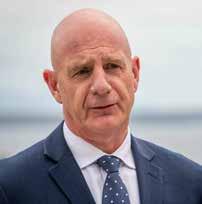
Incat Chairman and founder, Robert Clifford welcomed the appointment of Gutwein, who was also Climate Change Minister, saying, “as we position the company for significant growth, his knowledge and experience will be valuable as we deal with the rapidly expanding low-emission (electric) global market.”
The role will leverage Gutwein’s state and federal connections, and is one of several positions the former premier has taken since stepping down from parliament in early 2022.
Clifford, who has just returned from a
trip to Europe and the Americas, believes Incat can be globally competitive in building zero-emissions fast ferries.
“Incat Tasmania led the way in the development of the world’s first car-carrying high speed, lightweight catamarans in the 1990’s and is set once again to revolutionise the fast ferry market.
“Already we build ships that have lower emissions than our steel competitors, as aluminium is only a third the weight of steel, meaning vessels require less power and consume the lowest possible amount of fuel, already reducing each ship’s carbon footprint.”
With the International Maritime Organisation (IMO) requiring a 30% reduction in CO2 emissions for new builds from 2025, and a 40% reduction in the world fleet’s overall emissions by 2030, Clifford says Incat is well
positioned to meet the market demand for fully electric, zero emission ferries.
“On my recent overseas trip, I met with some of the world’s largest passenger and vehicle ferry companies, many of which are current customers, and the appetite for fully electric lightweight ferries was staggering.
“Over the next decade there will be tens of thousands of vessels that will need to be replaced or refitted and Incat is ideally placed to deliver the world’s first high-speed lightweight ships that are fully electric with zero emissions.
Electric visions
The 148E Fast Utility (pictured) is a proposed design for a light-weight electric fast ferry. 148 metres long and battery operated, it could carry a considerable payload of trucks and cars and still travel at 25 knots (about 46 kph in a car), says Judy Benson, a spokesperson for Incat Tasmania.
Benson says the company has been researching electric ferries for a long time.
“The challenge has always been the balance of weight, speed and range.
As with a car, the heavier the ship, the more fuel you use if you go fast or a long distance.
“Batteries are very heavy, so to propel a ship you either sacrifice payload, speed or distance. But battery technology has improved significantly over the past few years and we think they will get lighter.”
Benson says the ‘Interim Solution’ on the ship livery indicates that while it can be built to be all electric, Incat offers an interim option if a port has insufficient electricity available for an electric ship to be powered on shore.

Therefore, the two red cargo-container sized boxes pictured on the deck are generators that Benson says could be used to recharge the batteries if the ship pulls into a port where there’s insufficient electricity source, but removed when no longer required.
Workforce to triple
Incat, which specialises in vehicular ferries but does have a number of passenger ferries on Sydney harbour, has its shipyards on the Derwent River in Hobart, and is now almost 100 per cent export oriented.

“Incat is already a world leader in building lighter and stronger ships and now we are going to be the world leader in building lighter, stronger, fully electric, zero emission ferries,” says Robert Clifford.
“This will mean a doubling if not tripling of our workforce, back up to more than 1500 jobs here at Prince of Wales Bay, with a similar increase in contractors and other support services for our operation.
“We will need more employees and possibly even another yard once we reach capacity here at the current site. We are also going to need the right strategic advice and support to enable us to grow as quickly as we will need to.”
INDUSTRY NEWS
Former Tasmanian Premier Peter Gutwein. Photo: The Examiner
26 | Industry Update Issue 130 Feb/Mar 2023 industryupdate.com.au
Incat shipbuilding yards, Derwent Park, Hobart




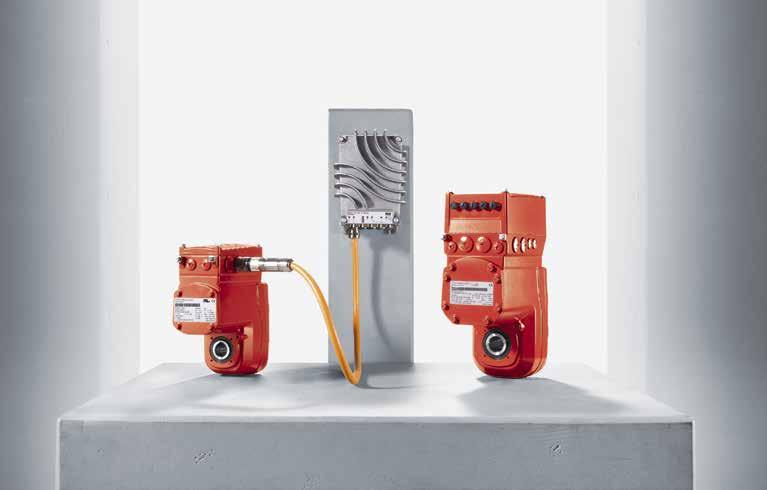
‘Mother machine’ to strengthen sovereign capability
Advanced manufacturer ANCA has received the first round of its $3 million Modern Manufacturing Initiative (MMI) grant, to be spent on a ‘mother machine’ which will enable ANCA to supply critical industries.
The ‘mother machine’ at ANCA’s Bayswater, Victoria, facility, will enable ANCA to accurately and consistently produce many precision parts for the aerospace, automotive, medical device and electronics industries. The MMI is part of the Australian government’s wider $2.5 billion Modern Manufacturing Strategy.
ANCA Chief Executive Officer Martin Ripple said the government’s MMI recognises a healthy manufacturing industry is crucial to Australia’s sovereign capability.
“This will not only position ANCA as one of Australia’s most comprehensive providers of end-to-end manufacturing solutions, but also help increase our overall
global competitiveness, create additional export opportunities and enable further integration of Australian made products into global supply chains.”
ANCA says the facility will also gain about 150 highly skilled Australian jobs within the project period and around 330 jobs after five years..
“ANCA is a proudly owned Australian business with our headquarters in Melbourne and we think it is important to shift the conversations to how advanced and value adding manufacturing can thrive locally.”
The funding coincided with a visit to ANCA’s Bayswater manufacturing facility by Australia’s Assistant Minister for Trade and Manufacturing Tim Ayres.
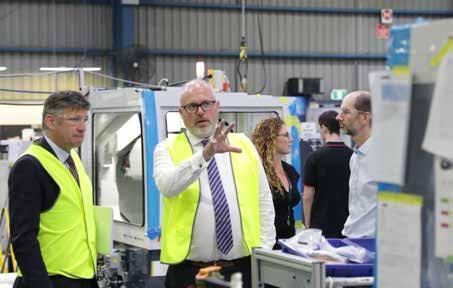
“Over the last decade, Australian exports have slipped down the global value chain as our exports have become less complex,” Assistant Minister Ayres said.
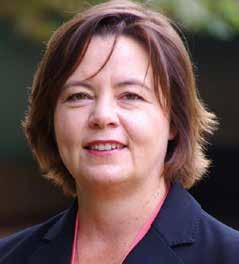
“This grant will enable ANCA to build a designated, precision manufacturing
Polluters to cut emissions or pay
carbon credits - thus creating a financial incentive to reduce emissions.
This reform of the existing so-called “safeguard mechanism” is expected to deliver around 200 million tonnes of abatement by 2030 from the sectors, which contribute to about 28 percent of the country’s emissions.
The government will also provide $600 million from the $1.9 billion Powering the Regions Fund to trade-exposed businesses and regions as compensation for the cost of the change and to help invest in new technologies.
cell and continue enhancing Australia’s sovereign manufacturing capabilities.”
ANCA is an industry innovator which invests 10% of its $300-plus million annual turnover into R&D, ensuring that not only its own operations but those of its customers are future-proofed.
ANCA is a world-leader in advanced manufacturing, founded in Victoria in 1974, it employs more than 1,200 people and exports its products to customers in more than 50 countries.
ANCA is an advanced manufacturing company of CNC grinding machines, automation, motion-control solutions
and sheet metal fabrication. Based in Melbourne since 1974, ANCA designs and manufactures highly complex and accurate machinery that requires lasers, automation and robotics to achieve accuracies in microns. It has offices in the UK, Germany, China, Thailand, India, Japan, Brazil and the USA and a comprehensive worldwide distribution network.
Out now: guide to critical minerals grants
Guidelines for new grants to accelerate development of Australia’s critical minerals sector have been released by the federal government as part of its Critical Minerals Strategy.
The grants will fund early to midstage critical minerals projects towards financing and production, and are expected to create jobs in regional Australia and help achieve net-zero emissions.
investment in regional Australia, the grants program encourages collaboration with Australia’s international partners.”
Demand for low-emissions technologies will skyrocket over the next three decades. This is expected to increase demand for lithium 40-fold, cobalt and graphite 20-fold and rare earth elements seven-fold, among others.
Around 215 of Australia’s biggest industrial emitters will need to cut emissions by an average of 4.9 percent each year until the end of the decade, as part of the Albanese Government’s decarbonisation plan outlined in January.
Energy and Climate Minister Chris Bowen announced the government will cap the price of carbon at $75 a tonne for the large emitters as a “cost containment measure” to provide certainty and prevent prices from spiking.

The announcement is a key plank of Labor’s commitment to reduce greenhouse gas emissions by 43 percent and reach net-zero by 2050. The plan will now face the Greens in the Senate.
Mining, manufacturing, transport, oil and gas, and waste industry emitters must commit to making the reductions by mid-year, or offset them by buying
Carbon credit review
This week, Professor Ian Chubb’s independent review of Australia’s controversial carbon credit system was released, dismissing claims the scheme lacks integrity or isn’t delivering proper cuts in emissions. It also recommended significant changes to how the scheme is managed.
The review rejected allegations by whistleblower academic Prof Andrew Macintosh, who was former head of the emissions reduction assurance committee, and on whose allegations the review was commissioned, arguing there were systemic flaws in the way carbon credits were issued.
Macintosh’s research team found that 70% of the majority of offset methods - avoiding deforestation, planting of native forests and combusting methane from landfills - didn’t offer genuine emissions abatement.
The Critical Minerals Development Program offers up to $50 million in grants from $1 million to $30 million for projects that will strengthen Australia’s sovereign capabilities in critical minerals which are crucial for low-emissions technologies such as electric vehicles, batteries, solar panels, and aerospace and defence applications.
Minister for Resources and Northern Australia Madeleine King said the grants program will help Australia become a trusted global supplier of critical minerals and rare earths which are needed to help lower global emissions.
“The grants will support up to half the eligible expenditure on projects that will strengthen global supply chains and help Australia build capacity to process critical minerals into strategically important technologies such as lithium-ion batteries, rare earth element magnets, semi-conductors, and communications components,” said Minister King.
“As well as supporting jobs and
“The road to net zero runs through Australia’s resources sector,” Minister King said.”
Climate Change and Energy Minister Chris Bowen. Picture by Peter Lorimer
Minister for Resources and Northern Australia Madeleine King
ANCA anca.com INDUSTRY NEWS 28 | Industry Update Issue 130 Feb/Mar 2023 industryupdate.com.au
Left, ANCA Chief Executive Officer Martin Ripple with Australia’s Assistant Minister for Trade and Manufacturing Tim Ayres.
New food expo to invigorate the sector
Identifying shifts in consumer behaviour and getting new products speedily onto shelves was the talk of the room at the launch of the new thinkfood LIVE expo, to be held at Carriageworks in Sydney in October 2023.
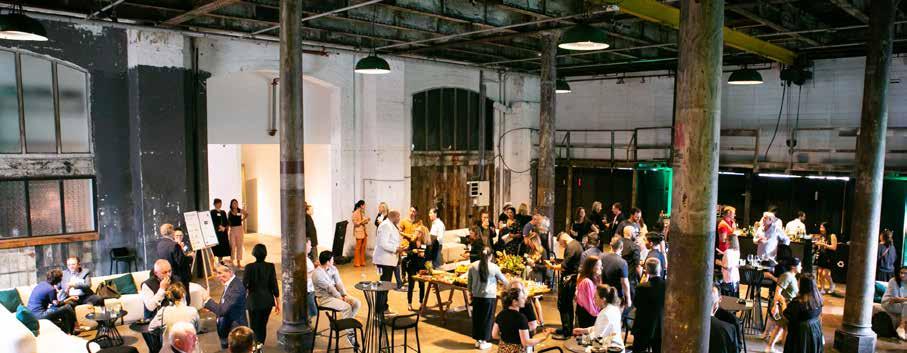
For food and beverage companies, the combination of identifying consumer needs and having manufacturing and retail “ready to go” is the key to successfully producing on-trend, new products, PLAY Innovation’s Becky Mead told the gathering.
More than 60 suppliers, creatives and new product development (NPD)

professionals attended the November launch, many hailing from industry’s leading companies, including Vow, Breville, Goodman Fielder, Woolworths, Arnott’s Biscuits, Mintel and Sunrice.
Food tech startup Vow, for example, is doing inventive work in biotech and cultivated meats and is a standout example of innovation in the food and beverage industry.
With a focus on the pre-manufacturing stage of food and beverage production, the inaugural 2023 thinkfood LIVE expo will connect food professionals
Be part of Australia’s Manufacturing DNA
Moder n Manufacturing Expo 2023
20 – 21 September, Sydney Showground, Sydney Olympic Park


If your business is involved in robotics, AI, factory automation, Industry 4.0, manufacturing software, advanced manufacturing or any other modern technology that is leading the industry into the future, we want to hear from you!

“You need to get your business name out there and The Modern Manufacturing Expo is the best way of doing it… everyone in one location to see and hear what you do, you can’t lose” – APPMA
with suppliers to help them kickstart NPD or reinvigorate existing products.
The expo will focus on ingredients, technology and creative services, said Siobhan Rocks, the Commercial Director of Diversified Communications, which established the event.
“This event concept is unique to Australia so it’s an exciting and innovative opportunity for all to connect. We have developed this forum due to overwhelming demand from businesses eager to connect with the right channels to take their new product development
to the next level,” said Rocks.
“There will be exhibiting experts in all key areas covering everything from consumer insights and packaging, to design agencies and test kitchens.
“There will be a key focus on ingredients and flavour houses who can help emerging and established businesses create the perfect launch pad for their new product or brand.
“We can’t wait to bring manufacturers and suppliers together to collaborate on the next generation of consumer products.”
INDUSTRY NEWS
Showcase your technology and lead the way! Limited exhibitor stands & sponsorship opportunities available.
03 9596 9205 • MM ESA L ES @ IE C G R O U P C O M .A U • WW W M O D E RNM A NU F A C T UR I N GEXPO. C O M Book your spot now
Industry Update Issue 130 Feb/Mar 2023 | 29 industryupdate.com.au
AUSTRALIAN MADE
Green-and-gold kangaroo protected in Asia
Australian exporters now have the added protection — and marketing advantage — of a formally registered green and gold ‘Australian Made’ logo in Singapore, New Zealand and Thailand.
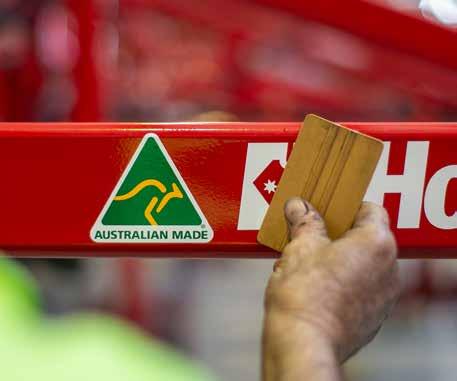
The registration means exporters have an official symbol that establishes their products as genuinely Australian and offers protection under local law.
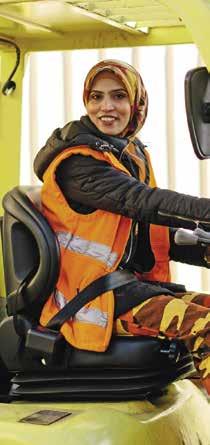
“The iconic green-and-gold kangaroo logo has clearly identified Australian goods in export markets for over 35 years.
“It is a valuable marketing tool and central to the export strategies of Aussies taking their goods abroad. Almost half of all Australian Made licencees use the logo on exported products,” said Australian Made Chief Executive, Ben Lazzaro.
Singapore is ranked as Australia’s sixth biggest export market, with more than $15b worth of exports going there in 2021, according to DFAT. New Zealand is our eighth biggest export market, and Thailand ranks 14th.
“Singapore, New Zealand and Thailand present a huge opportunity
for Aussie makers and growers. The formal logo registration in these regions provides an essential legal framework that exporters can rely upon if the logo is copied or used without proper authority,” said Lazzaro.
Independent intellectual property specialist firm, Wrays, did the work of registering the logo, which covers ten classes (Classes 3, 5, 20, 25, 29-33 and 35) that extend to a wide range of products, including:
• 3 – cleaning products, soaps, toiletries, cosmetics
• 5 – pharmaceuticals, veterinary pharmaceuticals, infant formula
• 20 – furniture
• 25 – clothing and footwear
• 29-33 – food and beverages
• 35 – retail services
The Australian Made, Australian Grown logo is also a registered trademark in China, the European Union, Hong Kong, India, Malaysia, the Philippines, South Korea, Taiwan, the United Arab Emirates, the United Kingdom, the United States of America, Indonesia and Vietnam, where it is known as Australia’s mark of
authenticity.
Recognition of the Australian Made logo is high in export markets.
Horizon Consumer Science research found 87% of international consumers believe products carrying the Australian Made logo are from Australia, 97% have a positive first impression of the logo and 72% become intrigued about a product once they see the logo.
Prominent placement of the Australian Made logo was also found to
be the best way to increase the likelihood of buying Australian.
To find out more about applying to use the Australian Made, Australian Grown logo, please visit australianmade.com.au
Australian Made australianmade.com.au
Anodising: the ultimate finish
Protecting your components is a crucial part of decisions regarding metal fabrication or manufacturing.
When choosing a protective finish, it is important to consider corrosion, abrasion, wear and chemical resistance, depending on how the parts are used.
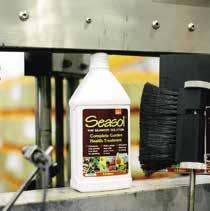

For aluminium components, anodising provides a superior option, as it protects against deterioration, contamination and impact, meaning longer-lasting parts and reduced machine downtime.
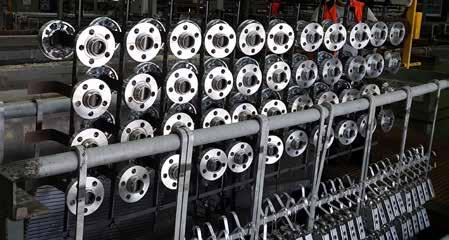
An electrolytic conversion process, anodising creates a tough protective layer on the aluminium surface, protecting the raw aluminium below from oxidising or further corrosion.
With exceptional protective properties, the durable finish is popular among the defence, aerospace and engineering industries, and is also widely used throughout the manufacturing and building sectors.
For hard-wearing applications, hard
APPLY TO USE THE LOGO
YOUR PRODUCTS CERTIFIED AUSSIE?
ARE
30 | Industry Update Issue 130 Feb/Mar 2023 industryupdate.com.au
anodising is a solution for manufacturers –it’s a denser, harder and thicker aluminium oxide coating that can withstand extreme levels of abrasion and weather attack.
Hard anodising is ideal for fast-moving machinery, heavy-use applications or components exposed to harsh environmental conditions.
While a number of hard anodising options exist, Australian anodiser DECO Australia is one of the few that boasts a ‘Zero Degree’ hard anodising process called DecoUltra® for premium durability.
Meeting standards
Some industries require high levels of compliance and expect anodised components to meet the requirements of various international standards.

MIL SPEC is a common specification required for parts used by the defence industry, ensuring it meets international military standards, with MIL-A-8625F being the MIL SPEC standard for anodising.

Other quality standards for anodising are often specified, including AS 1231 and

















AAMA 611 for architectural anodising.
Anodised finishes must undergo rigorous testing to ensure they meet these standards, including a variety of finish performance tests which assess the integrity, durability and resistance of the aluminium oxide coating and its ability to protect the metal in different circumstances.
Surface finishing experts DECO Australia have released a new educational white paper: The Ultimate Finish: A Comprehensive Guide to Anodising and its Benefits.
The in-depth guide outlines the anodising process, the types of anodising available, customisation options, the importance of compliance and testing, and how anodising can enhance and add longevity to industrial machinery and fabricated components for improved industrial operations.
Off the shelf or customised by MFB
MFB Products prides itself on a comprehensive Australiandesigned and manufactured accessories range to complement MFB enclosure cabinets and highlight power, air and cable management and shelving.
MFB standard (passive) range of PDUs (vertically or horizontally mounted) are available in 10-amp, 15-amp, 20-amp and 32-amp wiring configs with Australian outlets, IEC C13 or IEC C19 outlets. Plugs include Australian, IEC or captive (screw lock) fitted to a 2.5m lead by default.
IP Networked (active) range of PDUs (vertical or horizontal format) are available in 230V single phase or three phase. Outlets same as per passive with optional locked IEC outlets. Options include ability to view power, temperature and humidity levels via a web browser, receive SNMP-based alarms when exceeding defined thresholds, total amp draw and more. MFB’s range of PDUs comply to AS/NZS 3000:2018
As standard MFB offers roof-mounted fan trays, door fan units (Class B&C) and 19” rack-mounted fan trays, each drawing heat out of the cabinet and directing to atmosphere. Optional accessories include thermostats for regulating fan cycle according to ambient temperature, and/or optional speed controller for speed management of fans which reduces airflow and noise.
MFB’s wide range of cable management systems includes 19” rack-mount wire management trays, cable-retaining hoop panels, round, square or rectangle lacing rings, and full-length vertical cable ducts. Finally, MFB vertical cable trays act as a wire management system,


utilising tool-less mounting — so no cage nuts or screws are required.
Shelving is available in both a static (fixed) format, or a telescopic format for regular, easier access. Standard fixed shelves are load-rated to 50kgs, alternatively MFB heavy-duty shelves are rated to 200kgs – with equipment evenly distributed. For telescopic shelves and drawers, the Accuride slide system is used for smooth action under heavy loads. For lightweight equipment, we offer front-mounting cantilever shelves
The MFB team can put its 50 years’ experience to customise options the standard product isn’t quite right.
AUSTRALIAN MADE
A proud Australian manufacturer of diverse bespoke metal products for 68 years. E X TE N S IO N T O R S IO N CO M PR E S S IO N Get in touch today… T +61 7 3271 350 0 E s ales@mar shalliance com au W mar shalliance.com.au Deco Anodising Guide deco.net.au/anodising-101
MFB Products mfb.com.au
Industry Update Issue 130 Feb/Mar 2023 | 31 industryupdate.com.au
Evolution of finishes continues at Deco
DECO Australia has been creatively applying and improving surface finishes to meet industry needs since 2004. After creating timber-look finishes for architectural aluminium building products, DECO expanded to meet industry needs with finishes for defence, aerospace, engineering and manufacturing industries. Industry Update spoke to its General Manager, Richard Hamber.
How did DECO Australia come to offer protective finishes to the industrial sector?

Our expansion in 2018 was a result of purchasing a new manufacturing site that was already supplying protective coatings to the industrial sector. The synergy with our existing business, opportunity for growth and the ability to offer a wider range of finishes to our customers was key.
Our team has a wealth of experience across numerous finishing technologies and a proven track record of implementing quality systems to achieve optimal output, including ISO 9001, NATAaccredited testing and QUALICOAT accreditation. Our goal is to help Australian industry source the highest level of protective surface finishing here in their own backyard.
Why are quality protective coatings so beneficial?


Quality protective coatings are crucial in the longevity of any product. Coatings allow the designer to augment a component’s surface for higher performance by adding special properties such as corrosion protection, electrical conductivity, surface hardness, reduced friction and even colour fastness. The
key is specifying the correct coating for the application, then applying it in such a way that it performs to its highest level.
How is DECO’s industrial arm innovative and different ?
DECO sees innovation as an everyday activity and we constantly evolve and improve our systems and processes.
From the beginning, DECO has been introducing sublimation technology to the Australian market as a timber alternative. This continues today with our team developing new products, refining the sustainability of our processes, operating custom-developed finishing lines, developing new treatment systems and working with our partners to ensure seamless operations.
We also have an onsite NATA-accredited testing facility where we conduct rigorous quality assurance and compliance testing to ensure optimal quality.
Where does DECO fit into the future of manufacturing?
DECO is evolving as part of Australia’s essential manufacturing capability. Our quality systems and high-performance outputs are valuable for future development for many sectors including renewable energy, aerospace, battery technology and defence.
Our commitment to innovation, research and development will secure our place in the future to provide the next generation of surface protection to our customers.
AUSTRALIAN MADE
Deco deco.net.au 32 | Industry Update Issue 130 Feb/Mar 2023 industryupdate.com.au
Surging orders prompt upgrade
Faced with the welcome ‘problem’ of surging orders, Packserv Australia is taking a novel approach in expanding its facilities.

After years of neglect, the much-publicised efforts to bring manufacturing back to Australian shores are now going full steam ahead. However, for many companies, a dramatic increase in orders is creating a whole new set of problems, with managers left staring at the ceiling through the wee small hours of the night as they wrangle those problems. If this sounds familiar, take comfort in the thought you are not alone. Since it was founded in 2007, Packserv Australia has established itself as a leading provider of packaging machinery and technical services. With headquarters in Marrickville, NSW, the company manufactures a range of high-quality packaging equipment including machines for volumetric filling, capping and container-handling functions. Packserv is proud to be an Australian manufacturer, certified by the Australian Made Campaign.
Packserv Australia was on a healthy growth path before the COVID pandemic struck, with the introduction of a new range of machinery, but recently that growth has changed beyond all expectations. This has created a headache of the best type for Nathan Wardell, Managing Director at Packserv.
need if we aren’t to find ourselves with this same predicament in 12 months’ time.
“Problem 1: there are no such properties available in the locality, which means we are looking at locations outside of Sydney. Problem 2: our manufacturing team are experts at what they do in a very specialised niche product area – can I realistically ask them to add a three-hour commute to their working day?”
As the saying goes, ‘necessity is the mother of invention’, and the solution to Packserv’s problems is certainly a very novel approach as Wardell explains further.
“We already had a great working relationship with several universities, particularly UTS (University of Technology Sydney). We’re looking at creating a new factory that not only meets our production requirements but houses the very latest manufacturing
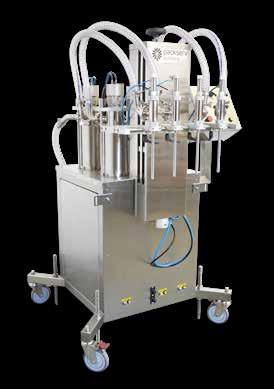
technology and equipment.”
Delivered by Packserv’s engineers and supported by the UTS Centre for Advanced Manufacturing, the new site is expected to create more than 30 new jobs: “We’re looking to create a facility that combines the very latest knowledge, consistently updated, that will meet not only Packserv’s needs, but also be available to businesses from all over Australia, that will enhance the whole community in which it sits, and will attract interest and skills from around the globe.”
As Wardell puts it: “Go hard or go home.”
“We moved to larger premises 18 months ago to address our scaling-up of operations,” he explains. “That move was meant to meet our needs for the next five years. Instead, even after almost doubling our floor space again with the addition of a mezzanine floor, we are still packed in like sardines in a can.”
It’s certainly not a unique problem for manufacturers, so how is Wardell planning to tackle it?
“Well, we are adopting a ‘go hard or go home approach’. We are currently looking at the acquisition of a factory of 3,000sqm, which is what we realistically
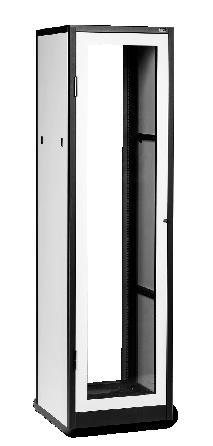
PFM-4C-2L Packserv Manufacturing Four
Packserv packserv.com.au DESIGNERS & MANUFACTURERS OF 19” RACK SYSTEMS mfb.com.au VIC (03) 9801 1044 / sales@mfb.com.au NSW (02) 9749 1922 / sydney@mfb.com.au AUSTRALIAN MADE Industry Update Issue 130 Feb/Mar 2023 | 33 industryupdate.com.au
Head 2 Litre Auto Filler
Could cobots be an answer to Australia’s welder shortage?
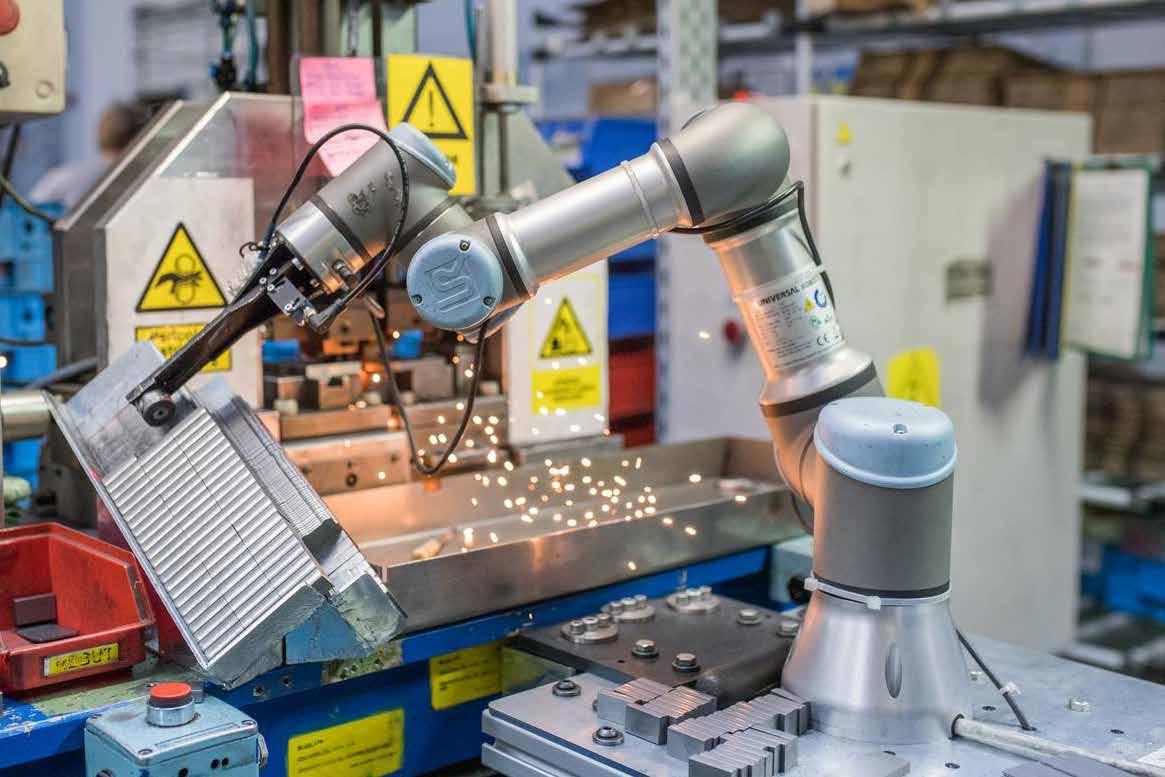 By Margie Smithurst
By Margie Smithurst
With Weld Australia predicting the country will be short 70,000 welders by 2030, robotics companies are hoping to step in to help solve the skills gap.
In particular, with collaborative robots or cobots — small, flexible collaborative robots built to do tasks within a small footprint.
The main beneficiaries would be smallto-medium-sized businesses (SMEs), says Ian Choo, Senior Technical Support Engineer with Universal Robots (UR). Founded in Denmark, UR manufactures collaborative robots, and was set up specifically to find automation solutions for SMEs, says Choo.
While larger industrial robots have been used for high-speed, heavy duty welding for a long time, Choo says their size, safety and programming complexities mean they’re generally inaccessible for SME production facilities.
“A cobot lowers that barrier to entry, potentially lowering the cost of safety devices to reduce machine risk, which
ultimately also reduces the footprint of the machine.”
The smaller size of the cobots also means welders can more easily drive the robot by hand in order to teach them.
Teaching a cobot, which resembles a giant arm, to do a welding task isn’t as difficult as it seems - if you can use a smartphone, you can learn to program a cobot”, says Choo. It’s far easier than learning to weld.
“It is very easy to dismiss the wealth of knowledge required to produce a weld correctly — being able to look at a weld bead and knowing whether to adjust the traversal speed, wire speed, voltage, etc.”
Choo says the process expertise needed is still extremely crucial to the success of robotic welding.”
“Traditionally, the problem is that we
have an experienced robot programmer who has minimal welding experience, and an experienced welder with minimal robot programming experience.
“What UR aims to do is to bridge that gap.”
Choo says the simple programming interface means a welder with no prior experience of working with robots can learn how to program them.
Using a teach pendant, a programming device that resembles a heavier version of an ipad and is attached by cord to the robot controller box, the welder physically moves the cobot to the ‘start’ and ‘end’ weld positions, programming it step by step with basic commands such as ‘move’ or ‘wait’.
This hands-on ‘freedive’ functionality, as it’s known in UR terminology, makes
it extremely intuitive to use as a teaching tool, says Choo, and means the cobot is a very simple automation solution.
“The role the robot plays is essentially the ‘movement’ part of the task, positioning the welding torch at the appropriate angle, moving the torch consistently at the specified speed.”
But what is the collaborative part? Do welders work alongside the cobots?
“In a typical setup,” says Choo, “the welder would be the one programming the robot, setting up the jigs and running the robot until it is able to produce satisfactory results.
“From there the operator would then unload the completed parts and load in new pieces, locking in the jig and re-starting the robot.
“In certain cases it might be set up in a way where the robot performs the simpler parts of the welds (perhaps the more consistently located ones) and leaves the more difficult welds to the person, but both can work in parallel which improves overall output.”
AUTOMATION
34 | Industry Update Issue 130 Feb/Mar 2023 industryupdate.com.au
“If you can use a smart phone, you can learn to program a cobot”
One welder might also be managing multiple robots.
And when there are new parts to weld, the welder then reprograms the cobot.
Companies already using them
Globally, UR has sold over 50,000 cobots, says Choo, and a number of Australian companies already use cobots to weld and perform other tasks such as machine tending, screwdriving, palletising and materials handling.

Choo says cobot welding is the fastest growing sector for the company in terms of sales, driven largely by the welder shortage in Australia at the moment.
UR thinks the solution is particularly suitable for smaller SMEs and workshops that have high mix-low volume production and need more versatile options, as well as a level of independence in using their own personnel to adjust the robots rather than having to call in an engineer from a systems integrator.
“In regards to return on investment,” says Choo, “it obviously varies according to application, and if it’s welding, it also depends on the complexities and requirements for additional hardware/software. But commonly for Australia, our return on investment for customers has been reported to be on average approximately 1.5 years.”
Apprentices needed
Of course, cobots aren’t the only possible solution to the welder shortage — training up more apprentices in the trade is critical.
Leaning into the challenge, TAFEs are pairing up with large corporations to train young workers in the latest technical knowledge and on top-of-the-range machinery.
SMC’s real-time flow meter manifold seals the deal

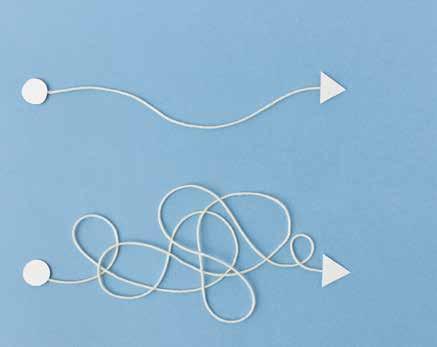
Facteon has spent the past four decades crafting factory automation and proprietary welding solutions and has grown to specialise internationally in factory solutions, smart manufacturing and Industrial IoT technologies (IIoT).
The company’s welding solutions focus on technologies that deliver on weld strength, alignment, and a superior cosmetic finish.
“We are focused on customer confidence,” says Warren Collenette, Facteon’s Senior Design Engineer.
Facteon provides robust welding solutions to some of the world’s largest appliance manufacturers and its welding technology can be used to process aluminum, mild steel, and multiple grades of stainless steel.
“Irrespective of the industry, consistency and repeatability are key,” says Collenette.
Naturally, finding the right automation partner is central to the success of any manufacturer and Collenette says Facteon looks to SMC Corporation Australia New Zealand for many of its unique automation requirements.
“We started working with SMC more than 25 years ago. The initial
relationship was between Fisher and Paykel who, at the time, owned Facteon and SMC.”
“We have a great working relationship with SMC,” saysCollenette. “We are happy with their wide product range and commonly make use of their ISO cylinders. They’re always ahead of the curve, re-engineering and developing new products, and we are satisfied with their sales and after-sales support.”
Two recent export projects saw close collaboration between SMC and Facteon once again.
Continues next page
Fears of welders losing jobs to these sorts of robots aren’t about to play out anytime soon, thinks Choo.
“Welding is a skill that takes years to acquire and master, and it can only be gained by doing rather than reading or watching.
“It is a tougher ask to get a robot programmer to learn welding than a welder to learn robot programming. As with all other robotic automation projects, we still very much rely on the process experts - welders, CNC machinists, production line workers - to tell us how a task needs to be done correctly and we merely teach the robot to do exactly that.
“But in a lot of cases as well, we would much rather teach the process experts how to use the robots and they can teach and adjust the cobot self-sufficiently.”.
In Tamworth and Armidale, for example, where there’s high demand for well-trained welders and metal workers in agriculture, forestry, mining, manufacturing and aviation, the New England TAFEs have teamed up with BOC, the country’s leading gas and welding equipment specialist.
“There’s a huge demand for apprenticeships in the metal and welding sphere.
“On average we used to take on around 24 to 30 students each year for both schools, now it is 50 plus, so the numbers have doubled,” says Tony Walsh, Head Teacher of Engineering at NSW Department of Education and Communities and who oversees all apprentice training programs at Tamworth and Armidale TAFEs.
Universal Robots universal-robots.com www.smcanz.com SMC – more than pneumatics Expertise - Passion - Automation Make 2 02 3 h ass l e fre e wit h qu a li ty p r odu ct s f rom S M C AUTOMATION
Ian Choo, Senior Technical Support Engineer with Universal Robots (UR)
“Fears of welders losing jobs to these sorts of robots aren’t about to play out anytime soon”
Industry Update Issue 130 Feb/Mar 2023 | 35 industryupdate.com.au
SMC’s real-time flow meter manifold seals the deal

“We had the opportunity to discuss several solutions and use one of SMC’s new product lines for projects in the appliance and office furniture industries,” says Collenette.

Seven times the benefit Collenette says that receiving feedback from manifolds have become pertinent to Facteon’s processes.
“We use manifolds for spot-welding machinery which have water circuits running through them at a specified flow rate. The manufacturer stipulates the flow rate and if we don’t adhere to their parameters, things can go wrong, and the customer may no longer be protected by their warranty. This is one of the reasons for feedback manifolds.”
Detailing SMC’s involvement, Collenette says the application required a multi-station, flow meter manifold and flow rates in real time.
“Rather than having many flow meters, each with their own configuration, we wanted one tidy solution.”

Facteon wanted water flow to be controlled across multiple water-cooling circuits within a machine.
This is where the seven-station flow meter manifold (PF3WB07B-W720P04-LTN-M) with IO link capability from SMC comes into play.
Compared to its predecessor the PF2W, this series offers a refreshed design. It also features 40% smaller volume, enabling shorter entry piping with flexibility. The display is rotatable and has a three-colour, distinct display as well as temperature monitoring.
Shyam Suresh, Global Accounts Manager for SMC in New Zealand says the solution has been used in both spot

welding and MIG welding applications.
“The first one we developed was a seven-station unit in 2020 but this year it’s a two-station unit. It’s a modular solution that can be adapted as needed,” says Suresh.
He adds that this customised solution from SMC is pre-configured and comes as a plug-and-play solution from its head office in Japan.
“The customer only needs one part number and it’s configured to their exact specifications. It also features an IO link display for remote monitoring and to demonstrate flow rates.”
Features include individual shut-off valves for safety purposes and optional flow control valves, to adjust the flow rate for each circuit as required.
According to Shyam, the delivery time on these units is quick with turnaround times in six to seven weeks, and some units arriving even sooner.
Project challenges
The manifold needed to be tested within the confines of Facteon’s premises during machinery commissioning.
“We needed to get enough water flow through all the circuits, however, we were struggling with this due to our inadequate water supply in-house. Ultimately, the maximum flow rate through each valve is 12 litres per minute per output, so it shouldn’t be a problem on-site,” says Collenette.
While the team was sure that it would work, based on the initial in-house testing, the solution could only truly be put to the test at the customers’ factories in China and the US.
Speaking of the safety requirements of this application, Collenette adds that they ensure the manifold was positioned away
from any direct line of sparks or danger.
“We could also put covers on them if required, and others were mounted to service towers — some meters away from the applications.”
IIOT on the rise
IO link flow sensors are big draw cards for its customers.
“Where possible, we changed all our equipment to IO link capability due to customer feedback and demand,” says Collenette.
The demand for smart manufacturing and remote monitoring remains top of Facteon’s list.
“Today, customers are asking for a lot more feedback from their processes to ensure tighter quality controls. In
addition, it gives them the option to monitor their processes remotely which is of major benefit when you think about the cost of labour.”
It also helps with routine and preventative maintenance. “In a situation where welding guns are overheating, faults and/or water leaks, customers can instantly shut down the machine and plan ahead.”
The success of this project is underpinned by collaboration and forward-thinking.
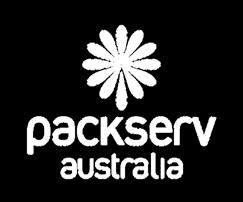
AUTOMATION Packaging Machinery Made Easy www packserv com au 1300 377 512 Filler Cappers Labellers Printers Print & Apply Sealers Conveyors Tables Shrink Sleeve Air Compressors SMC smcanz.com
Continued from previous page 36 | Industry Update Issue 130 Feb/Mar 2023 industryupdate.com.au









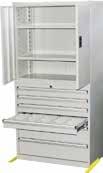

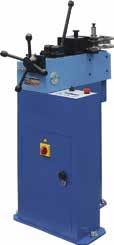

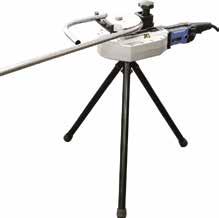
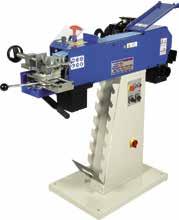


SYDNEY (02) 9890 9111 1/2 Windsor Rd, Northmead BRISBANE (07) 3715 2200 625 Boundary Rd, Coopers Plains MELBOURNE (03) 9212 4422 4 Abbotts Rd, Dandenong PERTH (08) 9373 9999 11 Valentine St, Kewdale SALE EXTENDED TRADING SAT. 25TH OPEN TILL 3PM VALID FROM 12TH TO 31ST MARCH Established 1930 Specifications & Prices are subject to change without notification. All prices exclude GST and valid until 31-03-23 HF-35 MANUAL FEED Ø35mm drill capacity 1.46hp, 240V motor $990 ex GST $1,089 inc GST (D950) HF-50 MANUAL FEED Ø50mm drill capacity 1.46hp, 240V motor $1,090 ex GST $1,199 inc GST (D9508) HF-750 MANUAL FEED Ø75mm drill capacity 2.4hp, 240V motor $1,950 ex GST $2,145 inc GST (D9507) INDUSTRIAL STORAGE CUPBOARD • Storage cabinets made from reinforced sheet metal • Hinged doors & a 3-point key lock design • 150kg shelf load cap. • 75kg drawer cap. Maximum total load capacity of 600kg SC-1800 900 x 450 x 1800mm (L x W x H) $690 ex GST $759 inc GST (T762) NEW RELEASE HEAVY DUTY - SC-2000 1100 x 653 x 2000mm (L x W x H) $900 ex GST $990 inc GST (T763) MAGNETIC BASE DRILLS INDUSTRIAL STORAGE & TOOLING CABINET $300 ex GST $330 inc GST (T774) $890 ex GST $979 inc GST (T775) BSC-900 STORAGE CABINET • 150kg shelf load cap. • 3-point key lock doors • 900 x 450 x 900mm (L x W x H) TC-900 TOOLING CABINET • 75kg cap. per drawer • 4 x 100mmm Drawers • 2 x 200mm Drawers • 900 x 450 x 900mm (L x W x H) T774 T775 STC-COMBI INDUSTRIAL STORAGE & TOOLING CABINET 900 x 450 x 1800mm (LxWxH) TB-70 3.7hp, 415V motor $14,950 ex GST $16,445 inc GST (T607) 3.7hp, 415V motor $6,990 ex GST $7,689 inc GST (T606) PN-2001 PIPE & TUBE NOTCHER - LINISHER • Triple Station: Notcher, De-burring & Flat Sanding • Ø20 - 76mm OD Tube & 1/2” - 2-1/2” NB Pipe Pipe/tube rollers are sold separately BUY AND INSTALL BEFORE JUNE 30TH TO TAKE ADVANTAGE OF THE $150,000 INSTANT ASSETS WRITE-OFFF NOW FOR BUSINESS UP TO $500 MILLION TURNOVER! HFLP-35 MANUAL FEED Ø35mm drill capacity 1.46hp, 240V motor $950 ex GST $1,045 inc GST (D9506) DB-32 ELECTRIC TUBE BENDER • 15.87, 19.05, 22.22, 25.4 & 31.75mm OD round tube formers • 1.7kW / 2.3hp, 240V $2,390 ex GST $2,629 inc GST (T070) OPTIONAL STAND $495 (T603) Suits TB-60 TB-60 INCLUDES STAND PACKAGE DEAL 3.7hp, 415V motor $2,090 ex GST $2,299 inc GST (L849) SAVE $109 inc GST $1,150 ex GST $1,265 inc GST (K033) ELECTRIC PIPE & TUBE BENDERS • Ø51 x 2mm steel tube capacity (TB-60) • Ø51 x 3mm steel tube capacity (TB-70) • Capable of storing 50 programs, 9 bends/program • Included pipe formers: 1/2”, 3/4”, 1”, 1-1/4” NB • 210º maximum bending angle SCAN TO ACCESS ALL SPECIAL PRICES!




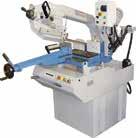








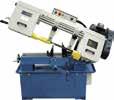


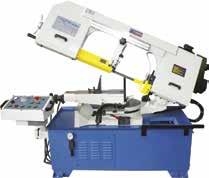
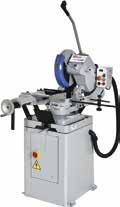


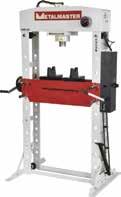
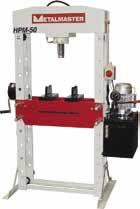













BUY AND INSTALL BEFORE JUNE 30TH TO TAKE ADVANTAGE OF THE $150,000 INSTANT ASSETS WRITE-OFF NOW FOR BUSINESS UP TO $500 MILLION TURNOVER! Specifications & Prices are subject to change without notification. All prices exclude GST and valid until 31-03-23 EB-320DS 310 x 205mm 2 Speed $5,450 ex GST $5,995 inc GST (B067) EB-351DSA SEMI-AUTO 345 x 205mm 2 Speed & Hydraulic vice $9,500 ex GST $10,450 inc GST (B072) EB-280DSV 245 x 180mm 240V - Variable $4,500 ex GST $4,950 inc GST (B063V) ALU-350A Ø350mm Blade 2hp, 415V $3,450 ex GST $3,795 inc GST (S851) SEMI AUTO NON-FERROUS CUTTING SAW • Dual mitre 45º • Compound mitre 45º CS-315C / CS-315D • Automatic retract safety blade guard • Dead man trigger switch • Dual material clamp • Quick action vice • Includes coolant pump system, blade & stand 415V 1.5HP / 25-50RPM $6,500 ex GST $7,150 inc GST (S836) • 100 x 85mm rectangular cap. • 100mm round cap. • Ø315 x 32mm blade • Includes coolant system & stand BS-916A - 240V 350 x 228mm Capacity $4,450 ex GST $4,895 inc GST (B015) DOUBLE COLUMN NC AUTO H-300HA-NC 300 x 300mm (W x H) $30,900 ex GST $33,990 inc GST (B118) DUAL MITRE DUAL MITRE 240V / 415V $5,540 ex GST $6,094 inc GST (S829 / S830) CS-350V • 160 x 90mm rectangular cap. • Includes: blade, coolant system,& stand VARIABLE SPEED 24-120RPM BS-13DS - 415V AUTO SWIVEL HEAD 458 x 235mm (W x H) Rect. Cap. $11,950 ex GST $13,145 inc GST (B030) BUILT IN COOLANT SYSTEM • Robotic welded frame • 155mm ram stroke • 200mm horizontally sliding ram HPM-30 30 TONNE Pneumatic/Hydraulic • 150mm ram stroke • Hand or foot operated pump • 175mm horizontally sliding ram HPF-20 20 TONNE Hydraulic • 200mm ram stroke • Hand / foot operated • Includes pressure gauge & table winch HPF-50 50 TONNE Hydraulic • 200mm ram stroke • Includes pressure gauge & table winch • 1.5kW/2hp, 240V motor HPM-50 50 TONNE Motorised/Hydraulic $1,180 ex GST $1,298 inc GST (P130M) $2,450 ex GST $2,695 inc GST (P152) $3,990 ex GST $4,389 inc GST (P131M) $904.55 ex GST $995 inc GST (P150) HEAVY
PRESSES COLD SAWS BS-7DS - 240V 215 x 178mm Capacity $1,540 ex GST $1,694 inc GST (B006) BS-912 - 240V 305 x 178mm Capacity $2,690 ex GST $2,959 inc GST (B014) BANDSAWS Large Model Available See the Range See the Range VARIABLE BLADE SPEEDS INCLUDES CONVEYOR SYSTEM EB-260V 225 x 180mm 240V - Variable $2,990 ex GST $3,289 inc GST (B062V) 240V 44RPM / 415V 22-44RPM $2,990 ex GST $3,289 inc GST (S827 / S828) 110 x 70mm RECTANGULAR CAP. PRESSES ACCESSORIES UP TO 10% OFF EB-330DSC 295 x 230mm 415V - 2 Speed $5,950 ex GST $6,545 inc GST (B075) MC-315F CE
SAW USE PROMO CODE F202303 for special prices See the Range
DUTY WORKSHOP
COLD
DRILLING MACHINE - INDUSTRIAL
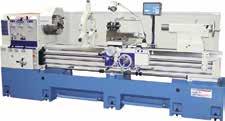
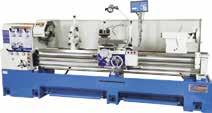

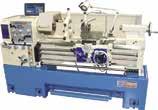











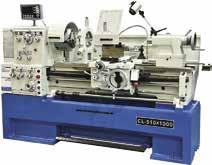
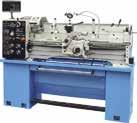
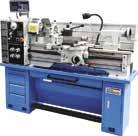
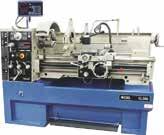


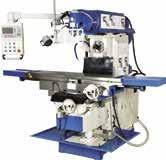



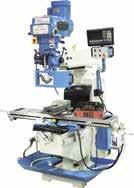










SYDNEY (02) 9890 9111 1/2 Windsor Rd, Northmead BRISBANE (07) 3715 2200 625 Boundary Rd, Coopers Plains MELBOURNE (03) 9212 4422 4 Abbotts Rd, Dandenong PERTH (08) 9373 9999 11 Valentine St, Kewdale 3MT SPINDLE 4MT SPINDLE 4MT SPINDLE 4MT SPINDLE 3MT SPINDLE GHD-55G 50mm Drilling Capacity 3.7hp, 415V motor $9,090 ex GST $9,999 inc GST (D175) • M42 thread tapping cap. • Motorised rise & fall work table • 16 speeds 45-2000rpm • 600 x 600mm work table • Includes coolant system, drill chuck & arbor GHD-30V 31.5mm Drilling Capacity 3hp, 240V motor $4,090 ex GST $4,499 inc GST (D176) GHD-45G 45mm Drilling Capacity 3hp, 415V motor $5,390 ex GST $5,929 inc GST (D174) • M35 thread tapping cap. • 8 speeds 90-1520rpm • 530 x 530mm work table • Includes coolant system, drill chuck & arbor GHD-32 40mm Drilling Capacity 2hp, 415V motor $3,390 ex GST $3,729 inc GST (D177) • Automatic feed & thread tapping • 12 speed (95-3300rpm) • Includes coolant pump system & drill chuck • Electronic variable speed • 50-2850rpm speeds • 426 x 400mm work table • Includes coolant system, drill chuck & arbor DMF-44 31.5mm Drilling Capacity 2hp, 240V motor $3,150 ex GST $3,465 inc GST (D185) PEDESTAL MILL DRILL • Mill head tilts to ±90º • 730 x 210mm table size • 6 speed (95-1650rpm) • Travels: (X) 480mm (Y) 200mm (Z) 850mm
NT40 SPINDLE TAPER • 3-Axis digital readout • NT30 horizontal & vertical spindles • Variable speed 70 - 3500rpm • 1370 x 254mm work table • Tilting head ±45º • Travels: (X) 860mm (Y) 360mm (Z) 425mm BM-40V 3hp, 415V motor $14,950 ex GST $16,445 inc GST (M607D) BM-70VE 3hp, 415V motor $27,500 ex GST $30,250 inc GST (M630D) Made in Taiwan • 3 Axis digital readout • Variable speed, 70-4200rpm • 1500 x 305mm hardened work table • Square slideways Y & Z-Axis • Turcite B coated slide-ways • X & Y-Axis inverter feed motors • Powered Z-Axis elevating motor • Travels: (X) 1050mm (Y) 420mm (Z) 400mm • 3 Axis digital readout • Variable speed, 60-3600rpm • Hardened ballscrew X & Y-Axis • 1470 x 370mm work table • Square slideways X & Z-Axis • Travels: (X) 1120mm (Y) 520mm (Z) 440mm BM-90HV 5hp, 415V motor $44,950 ex GST $49,445 inc GST (M633D) • 3 Axis Sino Digital Readout • 12 steps (60-1800rpm) • 1600 x 360mm table size • Square Y & Z axis slideways hardened & ground • Travels: (X) 1310mm (Y) 300mm (Z) 410mm BM-1600 5.5hp, 415V motor $29,500 ex GST $32,450 inc GST (M638D) Made in Taiwan NEW RELEASE Includes Digital Readout System, Quick Change Toolpost & Electronic Variable Speed With Digital Readout CL-38A Ø410 x 1000mm Capacity Ø52mm Spindle Bore 4.5hp, 415V motor $12,250 ex GST $13,475 inc GST (L191D) AL-356V Ø356 x 1000mm Capacity Ø51mm Spindle Bore 2hp, 240V motor $8,790 ex GST $9,669 inc GST (L565D) CENTRE LATHES CL-510 (415V) Ø356 x 1000mm Capacity Ø51mm Spindle Bore 2hp, 240V motor $17,950 ex GST $19,745 inc GST (L608D) CL-510 (415V) Ø356 x 1000mm Capacity Ø51mm Spindle Bore 2hp, 240V motor $18,950 ex GST $20,845 inc GST (L609D) (L608D) AL-410 Ø400 x 1000mm Capacity Ø52mm Spindle Bore 3.2hp, 415V motor $9,450 ex GST $10,395 inc GST (L569D) MACHINE TOOL ACCESSORIES UP TO 10% OFF Ø560 x 2200mm Capacity Ø105mm Spindle Bore 10hp, 415V motor $36,750 ex GST $40,425 inc GST (L638D) TM-1740G Ø430 x 1000mm Capacity Ø80mm Spindle Bore 7.5hp, 415V motor $23,450 ex GST $25,795 inc GST (L632D) Ø480 x 1500mm Capacity Ø80mm Spindle Bore 7.5hp, 415V motor $26,950 ex GST $29,645 inc GST (L634D) TM-2680G Ø660 x 2000mm Capacity Ø120mm Spindle Bore 15hp, 415V motor $42,950 ex GST $47,245 inc GST (L639D) USE PROMO CODE F202303 for special prices See the Range See the Range See the Range MILLING






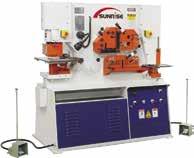
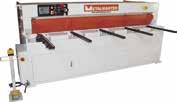
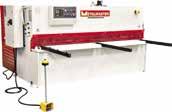





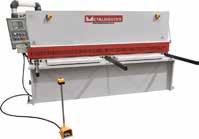
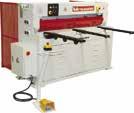





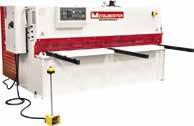
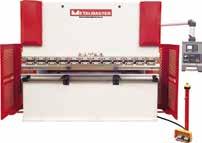
Specifications & Prices are subject to change without notification. All prices exclude GST and valid until 31-03-23 BUY AND INSTALL BEFORE JUNE 30TH TO TAKE ADVANTAGE OF THE $150,000 INSTANT ASSETS WRITE-OFF NOW FOR BUSINESS UP TO $500 MILLION TURNOVER! P173 Made in Taiwan • Easy to learn programmable Omron CP controller • Omron NC touch screen control features 50 programs, each program has up to 10 steps and bend counter • Automatic, manual and jog modes • ±0.1mm cylinder stroke repeatability & accuracy • 310mm high x 80mm vee bending die • Adjustable pressure dial with gauge • Includes 1000mm manual backgauge IW-60B, IW-60H, IW-60S • Five work stations - punching, notching, shearing plate, angle & bar • Punch and shear table fitted with guides and stops • Power inching for easy job set up Made in Turkey Made in Turkey GUILLOTINE • Manual Backgauge • Includes Rapid Blade Adjustment MG-440 MECHANICAL 1300 x 4mm 5hp, 415V brake motor $9,750 ex GST $10,725 inc GST (S924A) PB-820A 2440 x 2mm $6,850 ex GST $7,535 inc GST (S264) PB-830T 2500 x 4mm $18,250 ex GST $20,075 inc GST (S584T) HG-2504C 2500 x 4mm 5.5hp, 415V $17,950 ex GST $19,745 inc GST (S9335) HG-2504C 2500 x 4mm 5.5hp, 415V $17,950 ex GST $19,745 inc GST (S9335) HG-3206E 3200 x 6mm 10hp, 415V $25,950 ex GST $28,545 inc GST (S9401) HG-840B 2500 x 4mm 7.5hp, 415V $16,950 ex GST $18,645 inc GST (S927) HYDRAULIC SWING BEAM GUILLOTINE - PREMIUM • Estun E21S Control & Hardened Ballscrew Backgauge HYDRAULIC NC GUILLOTINE • 1-Axis Ezy-Set NC-89 Controlled Backgauge • Includes Rapid Blade Adjustment MANUAL PANBRAKES • Extended fingers for deeper boxes • Safety top beam support lever • Includes back gauge & digital angle gauge $46,350 ex GST $50,985 inc GST $1,650 INC GST SAVE K056A (S900 + S9335) RRP PB-416D - MANUAL PANBRAKE • Robust steel-fabricated construction • Foot clamping, allowing material to be positioned & clamped at the same time MB1250 - MAGNETIC PANBRAKE • 1300 x 1.6mm mild steel capacity • 240V electromagnetic clamping system • Includes: 25, 37.5, 52.5, 70, 140, 280, 585 & 1300mm clamp bars HYDRAULIC NC PANBRAKE • 2500mm x 4mm bending capacity • Ezy-Touch NC touch colour screen control • 1000mm manual backgauge • 5.5kW / 7.5hp, 415 motor NEW RELEASE IW-60B - 60 TONNE 7.5hp, 415V $17,500 ex GST $19,250 inc GST (P172) IW-60H - 60 TONNE 7.5hp, 415V $13,990 ex GST $15,389 inc GST (P173) IW-60S - 60 TONNE 7.5hp, 415V $19,850 ex GST $21,835 inc GST (P174) HBM-75 - 75 TONNE 7.5hp, 415V $31,250 ex GST $34,375 inc GST (P159) INCLUDES 6 SETS OF PUNCHES & DIES NC MODEL ALSO AVAILABLE HYDRAULIC
HYDRAULIC
BENDERS PK-35F 50 x 50 x 5mm 240V $5,950 ex GST $6,545 inc GST (S745) HPK-65 60 x 60 x 6mm 415V $17,950 ex GST $19,745 inc GST (S754) HPK-80NC 80 x 80 x 8mm 415V $25,450 ex GST $27,995 inc GST (S756C) HPK-50 50 x 50 x 6mm 415V $11,950 ex GST $13,145 inc GST (S750) See the Range SECTION & PIPE ROLLING MACHINES PANBRAKES $2,890 ex GST $3,179 inc GST (S260) $4,540 ex GST $4,994 inc GST (S542) HYDRAULIC SWING BEAM GUILLOTINE • Estun E21S Control & Hardened Ballscrew Backgauge • Blade gap adjusting dial 65mm throat depth PACKAGE DEAL PB-70E 70T x 2500mm 10hp, 415V $23,450 ex GST $25,795 inc GST (S900) PB-70E HYDRAULIC NC PRESSBRAKE • Estun NC-E21 2-Axis programmable control • 520mm leadscrew backgauge system • Please note: Safety guarding not included INCLUDES SAFETY GUARDING SYSTEM USE PROMO CODE F202303 for special prices See the Range NC HARDENED BALLSCREW BACKGAUGE SYSTEM
PUNCH & SHEARS
NC HORIZONTAL


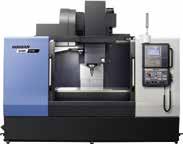

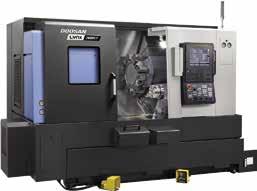

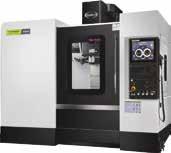



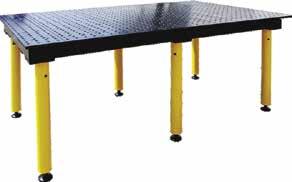

SYDNEY (02) 9890 9111 1/2 Windsor Rd, Northmead BRISBANE (07) 3715 2200 625 Boundary Rd, Coopers Plains MELBOURNE (03) 9212 4422 4 Abbotts Rd, Dandenong PERTH (08) 9373 9999 11 Valentine St, Kewdale See the Range CNC MACHINES Lynx 2100/2600 Series Turning Centres DBC Horizontal CNC Boring Machines Sword Dual Column Series Dual Column Machining Centres TABLES All tables, except BuildPro® MAX, have 40mm slots between plates. OPTIONAL PLASMA CUTTING TRAY AVAILABLE $208.18 ex GST $229 inc GST (W07757) VIEW ACCESSORIES ONLINE MAX RANGE WELDING TABLES 2000 x 1250 x 900 2550 x 1250 x 900 Standard or Nitrided Table Top Finish - 16mm thick steel plate reversible tabletop - Nitrided black oxide protective finish for wear, rust and weld spatter resistance - Accurately position parts in CNC precision bored 16mm diameter holes in 50 x 50mm spacing pattern THE RHINO CART MOBILE FIXTURING STATION IS A TURNKEY SYSTEM FOR FIXTURING AND CLAMPING IN WELDING & FABRICATION. Clamp and fixture at any point on the reversible, flat, nitrided (heat treated) 1200 x 750mm tabletop for accuracy in all of your setups 700KG LOAD CAP. TDQ612075-K1 $2,990 ex GST $3,289 inc GST (W07705) MOBILE FIXTURING STATION Priced from $4,940 ex GST $5,434 inc GST (W07722A) USE PROMO CODE F202303 for special prices

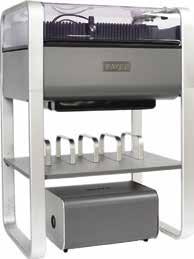
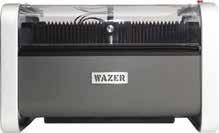










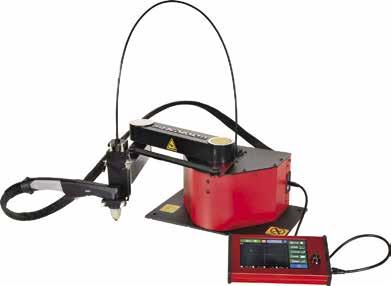
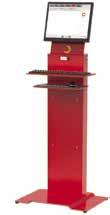








SYDNEY (02) 9890 9111 1/2 Windsor Rd, Northmead BRISBANE (07) 3715 2200 625 Boundary Rd, Coopers Plains MELBOURNE (03) 9212 4422 4 Abbotts Rd, Dandenong PERTH (08) 9373 9999 11 Valentine St, Kewdale BUY AND INSTALL BEFORE JUNE 30TH TO TAKE ADVANTAGE OF THE $150,000 INSTANT ASSETS WRITE-OFF NOW FOR BUSINESS UP TO $500 MILLION TURNOVER! WATERJET standup. $16,250 ex GST $17,875 inc GST (W08720S) ** BONUS BUNDLE INCLUDES** 1 x Cut bed 3 pack 1 x Nozzle assembly WAZER is the first desktop water jet that cuts any hard or soft material with digital precision. The high velocity jet uses a combination of high pressure water and abrasive particles to cut through the work piece. With WAZER, we’re bringing this advanced technology to any size workshop. Now cut anything with digital precision using high-pressure water the world’s first desktop waterjet desktop. $14,650 ex GST $16,115 inc GST (W08720) watch NOW TILES COPPER ALUMINIUM GLASS STEEL with optional plasma torch NEW RELEASE • Fits in any shop and easily portable to job sites • Glove friendly touch screen interface, easy to use and intuitive user interface • Quick change holders to move from trace to cut mode • With simple trace technology, no external software or cad skills are required • For advanced users ArcDroid™ is Fusion 360 compatible CNC PLASMA ROBOT CNC PLASMA
Save Time With Automation Operator Control Height Sensing Heavy Duty Gantry Heavy Duty Welded Base Optional Engraving Tool 1250 x 1250mm, 2500 x 1250mm, 3000 x 1500mm, 4000 x 2000mm Four Machine Sizes Multiple plasma power sources If you can draw it, download it, trace it or imagine it, you can cut it. Any table is a plasma table with ArcDroid™. Precision encoders and high resolution drives mean ArcDroid™ accurately reproduces your design with fast, accurate & repeatable parts from your plasma. Simple Trace Point to point or free hand, trace your template and ArcDroid™ creates a cut file instantly. Simply use the ArcDroid™ arm to follow the contours of your template and high accuracy encoders map your every move. Now all your cardboard cut outs are functional cut files! Cut envelope of 660mm x 380mm Priced from $34,900 ex GST $38,390 inc GST (P9010) $3,990 ex GST $4,389 inc GST (P8990) USE PROMO CODE F202303 for special prices
CUT TING
Industry-led research transforms manufacturers
by Margie Smithurst
If the government needs more evidence that industry-led research produces profitable, transformative outcomes for manufacturers, they could read the report by consultants ACIL Allen into the Innovative Manufacturing Cooperative Research Centre’s (IMCRC) collaborations.
Over its seven-year lifetime, which concluded this year, the independent research centre collaborated on 71 projects with 78 industry partners, 13 universities and the CSIRO.
Unlike industry growth centres, CRCs focus on early-stage R&D rather than commercialisation.
Examples highlighted in the ACIL Allen report, released in November 2022, include:
When Boral needed a solution to expand its Lower Carbon Concrete (LCC) range to include more cementitious materials (SCMs) that reduce emissions but keep strength and durability, the company drew on its existing relationship with UTS.
In 2020, an IMCRC funded project began at the UTS Boral Centre for Sustainable Building at UTS Tech Lab, and led to the development of a 70 per cent SCM concrete product that is now ready to go to market.
In the biotech sector, the IMCRC funded a collaboration between Codex Research and Sydney University to develop a bioreactor that can mimic a living human tissue system in order to grow cells in a more lifelike environment than the flat plastic dishes used in laboratories.
That bioreactor, while initially optimised for the development of tissue

engineered vascular grafts, will be used as a base technology for different applications, allowing Codex Research to access clinical, regenerative medicine, and medical science research markets.

In analysing the economic, social and environmental benefits that have been generated by IMCRC for industry and research partners since it launched in 2016, ACIL Allen found considerable evidence of success..

It determined that by strategically investing $35 million of Commonwealth and other funding, the IMCRC helped generate estimated financial benefits of almost $4.2 billion for industry by 2030,
• The creation of 224 collaborations and new partnerships between researchers and businesses, including internationally
• 22 new businesses or business models
• Planned industry investment of $2 billion in future R&D
• 181 cases of industry trialling and adopting new technology including machine learning/artificial intel-
efficiencies
• 45 postgraduate completions
• A reduction in greenhouse gas emissions totalling more than 3,300,000 tonnes CO2
ACIL Allen noted that other significant and perhaps unintended benefits of the IMCRC were in the role it played in catalysing broader investment in ongoing innovation.
For example, the IMCRC helped bring about the establishment of an Australian R&D lab in Queensland for American medical technologies giant, Stryker.
It also played a role in the set up of the Advanced Robotics for Manufacturing (ARM) Hub with Urban Art Projects (UAP) and QUT in Brisbane, and the establishment of the BAE Systems and Flinders University ‘Line Zero Factory of the Future’ in the Tonsley district in Adelaide.
Although the IMCRC’s funding term finished in January this year, Science and Technology Director at ACIL Allen, Dr John Soederbaum, said there’s evidence the IMCRC’s approach has “encouraged strong and sustained industry and research collaboration” for the project participants.
including $3.7bn in additional revenue.
Other benefits included:
• The creation of over 6,000 ongoing full-time equivalent (FTE) jobs
ligence, robotics and automation, advanced materials, sensors and data analytics, virtual or augmented reality, and additive manufacturing/3D printing to advance capabilities and gain
The report’s findings should hopefully encourage more Australian manufacturers down the path of industry-led collaboration on projects at R&D stage.
Codex and Sydney Uni created a bioreactor that mimics a living human tissue system in order to grow cells
INDUSTRY NEWS
IMCRC’s team
Industry Update Issue 130 Feb/Mar 2023 | 43 industryupdate.com.au
New compressors unveiled
At the Kaishan conference held in late 2022 in Alabama USA, a number of new products were unveiled for release throughout 2023.
Renowned for high quality rotary screw and compact scroll compressors and their world-class range of high pressure vacuum and gas products, Kaishan continue to develop and manufacture high tech, quality engineered machinery at plants stationed around the world. The conference showcased the following products for worldwide release.
Oil-free compressors

Developed and manufactured in the USA, this exciting new range of oil free rotary screw compressors will be available in early 2023 through Kaishan Compressors Australia. These high quality machines offer outstanding performance for companies that must have class zero air. Industries such as food, electronics, pharmaceuticals, petrochemical, automotive, aerospace, packaging etc. can now utilise these high performance, high efficiency compressors to meet stringent manufacturing and handling demands.
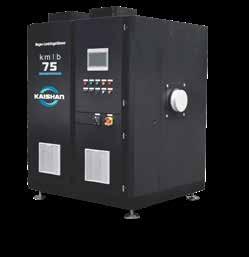
Other products released included a new range of oil free centrifugal compressors ranging from 40 to 800m³/min (110kW to 5000kW) and with pressures up to 20 bar.g. Machines are offered with worldwide certification which makes them suitable for use in virtually every country including Australia. These compressors are ideal for process applications including gas separation, petrochemical, and applications where high-volume air is required.
Reciprocating compressors

Kaishan has ALSO released a new range of high pressure, oil free, water-cooled reciprocating compressors specifically for PET plastic applications. The range is
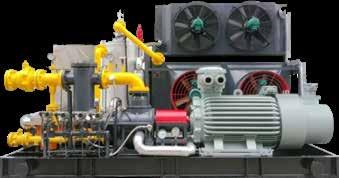



based on the proven LMF V-type design with models ranging from 5m³/min to 53.3m³/min and with pressures up to 40bar.g.
Rotary screw gas compressors for natural gas vapour recovery, gas field gathering and refrigerant applications ranging in capacities up to 193m³/min and with pressures up to 40bar.g and with compliance to API619 are now part of the range available for the Australian market.
Variable pitch, dry screw, vacuum pumps: these advanced machines offer energy saving benefits that are unmatched by any other vacuum technology. They respond to changing demand whilst holding a steady state vacuum at the lowest possible energy input. The ideal machine for any company with a centralised vacuum system wanting to reduce their power cost.
This is an exciting time to look at the future technological advances available to our Australian market,” said Kaishan National Sales Manager Mr Scott Tamlyn.

“The wider choice of world class machinery for compressed air and gas generation plus higher efficiency and output in vacuum engineering means specialised manufacturing and process industries can now access more efficient, energy saving systems that ideally suit their applications. We look forward to introducing these new innovations to our Australian and New Zealand clients”.
reduce operating costs by supplying new machinery, equipment, service and repairs from a strong background of technical experience including robotics, engineering and integration to the plastic industry.
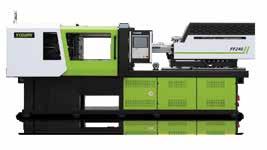
Our Partners

Temperature Control Units Robotic Automation & Ancillary Equipment Material Conveying Dosing & Drying Systems Lubricants & Systems Blow Moulding Machines Pneumatic & Electric Automation Injection Moulding Machines 60 – 3200 Tonnes Robot and Automation 02 9674 6511 pbe-roboplas.com.au Conveyor Systems 25 YEARS INDUSTRY EXPERIENCE
Kaishan kaishan.com.au MACHINERY
44 | Industry Update Issue 130 Feb/Mar 2023 industryupdate.com.au
Get space back with BAC
With congested supply chains in recent years showing that ‘stock on the shelf is worth five on back-order’, businesses are once again experiencing a bursting-at-the-seams feeling — not felt since the supply-chain boom in the last decade.
• They keep your parts cleaner and make it easier to keep them in their proper order
• They are strong and will last for decades in most situations
• They make picking faster, reduce the number of errors in picking and can hold very heavy loads
The first claim, that they compress stock when compared with storing the same stock on shelves, is perhaps what industry needs most right now for their inventories of small-to-medium parts.
If your business is being forced to hold greater stock-levels than before, you run the risk of outgrowing current storage.
When bursting at the seams, you also run the risk of parts getting damaged, mixed-up (with all that results from that), lost or stolen.
BAC Systems, the Australian manufacturer of high-density storage, has a remedy for this and their holistic approach could cure a few other gripes along the way.
BAC is famous for its award-winning range of drawer storage cabinets because they achieve the following:
• They compress your stock compared to storing the same parts on shelves
BAC Systems believe that in these situations, BAC drawer storage cabinets, with adjustable partitions and dividers within the drawers, can help you make best use of your storage volume. This way, you recover usage of more of your available storage volume.

BAC Drawers are quite easy to configure. Simply select the drawer heights and then decide the size of the internal partitioning.
If you don’t quite get it right the first time, it only takes a few seconds to adjust — BAC drawers have a very user-friendly way of adjusting to a changing inventory. This simple system does away with all the dead space of shelving — invariably there’ll be unused space on the shelves above or behind your parts. With drawers, choose your height and set the location size to the exact fit your parts require.
CONVEYOR ROLLERS AND COMPONENTS
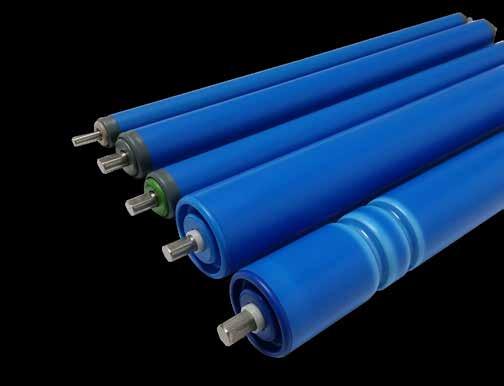
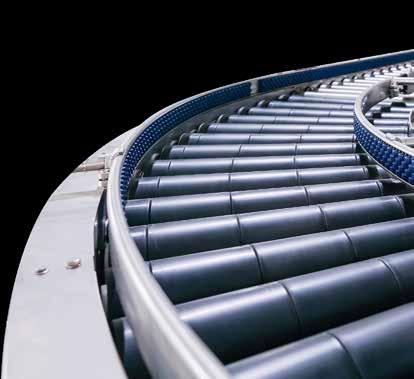
German Components, Assembled in Australia
To ease the upgrade to efficient storage, BAC’s experienced consultants visit customer sites to tailor the ideal system.
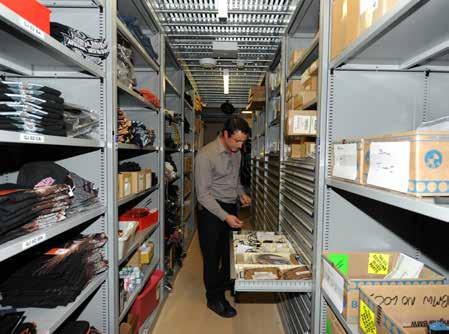
BEARINGS WHEELS DRIVES




Comprehensive Roller Range - Many size and material combinations. Polymer and Metal Versions assembled here in Australia. (Static & Driven) Component Range unmatched from any other Australian supplier High Quality & Reliable Performance – Backed by supplier. No comparable European products Available as sub-assemblies on the local market.
Competitive Pricing on all Parts and Rollers Design Assistance & Product Support – For the designer and conveyor manufacturer. Supporting the needs of the maintenance engineer.
mrtaustralia.com.au
MATERIALS HANDLING
bacsystems.com.au Industry Update Issue 130 Feb/Mar 2023 | 45 industryupdate.com.au
BAC Systems
Adept handling of materials enables growth
Introducing automation into any industry has often been a daunting task, says Paul Johnson, Director of Adept Conveyors, because people still resist change and technology despite evidence overwhelming benefits.
“Over the years, Adept Conveyors has been met with some illogical push-back from middle management and operations supervisory personnel who would insist ‘we don’t need that’, or ‘we are handling everything the way it has always been done so no need to change,’ and other similar comments,” says Johnson.
with Adept the possible introduction of a small amount of conveyor automation and check-weighing of their orders. They had a small warehouse and were busily picking and processing orders to trolleys which staff were pushing throughout the warehouse, ending at the dispatch doorway for consolidation.
That relatively small investment of $68,000 was so beneficial that it set that client on a growth trajectory which has culminated in a vast warehouse and order fulfilment operation. After that first investment, there followed 20
Technologies set about convincing the market that the conveyor system had to be the key part of the operation – and not treated as an afterthought that simply joined up point A with point B.
“The conveyor system is the truly dynamic heart of the warehouse, yet it was frequently the last part to be specified,” says Johnson.
“To us, it was hard to fathom why anyone would undervalue the most important part of the operation.”
“With some of our competitors focused on selling steel warehouse storage products rather than selling a complete solution, it was perhaps understandable that the conveyor became an afterthought for manufacturers,” says Johnson, “rather than as the lifeblood of warehouses, factories, freight, and courier depots.”
All German components
One thing that has not changed for Adept Conveyors is its focus on high-quality European components and Johnson regards one move in this area as crucial to Adept’s ongoing success.
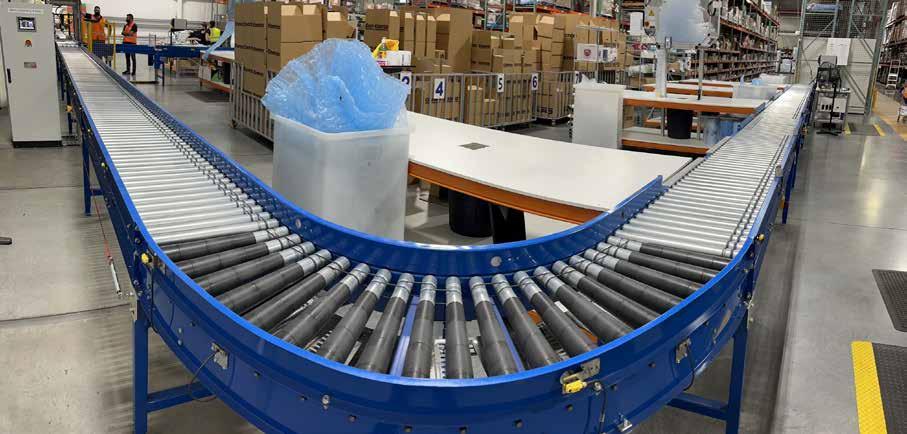
Back in 1999 Adept bought a share in the German-based company operation Marx-Rollentechnik GmbH, its component supplier. A share in the German business not only locked in Adept’s supply of high-quality omponents for its design and assembly operation in Sydney, it also provided the opportunity to sell these components on the Australian market to other conveyor companies and systems integrators.
been a strong competitive edge for Adept.
The next step was to set up Adept’s sister company MRT Australia in 2004 which has successfully carved out its own market niche.
MRT Australia now supplies those conveyor components to manufacturers and systems integrators in the Australian market, together with the necessary applications and support expertise. It holds $1m worth of components in stock for Adept and the Australian market.
An advantage for Adept and its customers is the depth of experience and expertise its team has accumulated — most staff have been in the business for decades.
Customised systems
Thanks to its full in-house design facilities and its ability to build and evaluate its systems in its own Australian factory, Adept can give each customer a tailored system, or a product designed to manage their specific needs — without compromise.
“Our clients often come to us with unique challenges,” says Johnson.
“I’d say 75% of the business we do is bespoke. It’s important to give the customer what they want, and we can do that because we’ve got the products and the stock.”
Adept’s mission is to give manufacturers Australian-built systems using world’s best technology plus the advantage of local expertise and support.
Yet the Adept team also recalls numerous occasions when they revisit a customer’s premises just a few months after implementation of some conveyor-based automation and have received comments such as: ‘how did we cope before?’ and ‘you can’t take this away’.
“And, after installing conveyor systems for 25 years, Adept has never heard anyone say they were disappointed,” says Johnson. One customer in 2013 was discussing
consecutive add-on automation projects designed by Adept plus many millions of dollars’ investment in conveyor-based and, more recently, robot automation.
Among the interesting things about that business’s growth is continued employment: those original staff members who were pushing the trolleys were not lost along the way because their roles grew and advanced along with the business.
Founded in 1999, Adept Conveyor
Adept’s robust range of conveyors exclusively uses components from its partner, Marx-Rollentechnik GmbH. This insistence on using European technology in its Australian-designed and assembled conveyor systems has differentiated Adept from other Australianbased conveyor suppliers.
At a time when Australia increasingly looks to Asia for much of its manufacturing and materials handling equipment, it has
As Johnson says, “Every system leaving our Sydney factory will continue to be built using the most appropriate and up-to-date conveyor technology and control functions. And, yes — only ever with quality European parts — never anything less.”

MATERIALS HANDLING
Adept Conveyors adeptconveyor.com.au 46 | Industry Update Issue 130 Feb/Mar 2023 industryupdate.com.au
MAVERick Equipment have supplied thousands of innovative & reliable Handling & Lifting solutions from quality suppliers in Australia, Japan & Europe. We specialise in:



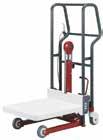


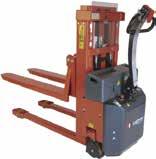


• Roll & Reel Handling
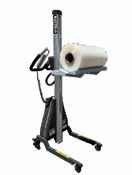
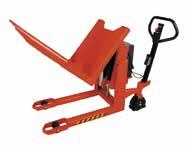
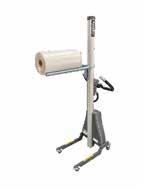
Food Packaging / Printing
• Stainless Steel Units

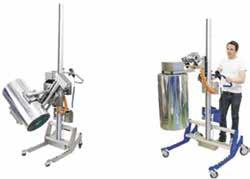
Food & Pharmaceutical
• Custom-Build Units
Suit your specific application

Show us & explain your requirements. We can offer & illustrate various options to suit.

WAREHOUSE & SHOWROOM 33 Stanley Tce, Surrey Hills VIC 3127 maverickequipment.com.au 03 9836 4500 look@maverickequipment.com.au NEED A QUALITY, RELIABLE & DURABLE LIFT? CONTACT MAVERICK EQUIPMENT – SERVICING INDUSTRY FOR 40 YEARS
Greig Maver, founder of MAVERick
Industry maverick battles with retirement
 By Margie Smithurst
By Margie Smithurst
He’s one of the more memorable characters in the materials handling industry, with his distinctive grin and colourful turn of phrase.
But after more than 40 years at the helm of MAVERick Equipment, the specialised handling and lifting business he established in Melbourne in 1980, Greig Maver has handed over the reins and the business.


Long-standing colleague Rohan Plaw took over as owner and managing director in July 2021.
But Maver, now a grandfather, hasn’t gone anywhere.
“I tried to retire but I couldn’t do it. I was so engrossed in this business for so
long, I fell into a deep hole. For decades I knew who I was and where I fit in the world. And there’s only so much golf & quality time you can handle!” he told Industry Update
With a core team including Plaw, Sally Wilcox as admin, and Sean Higgs, sales and warehouse manager, Maver still comes in a couple of days a week.
The success of the business, says Maver, has been keeping the company small and flexible.
“In the 1991 downturn, things dried up but we kept going. Same with the ‘87 crash. We adapted the business.”
“We’ve never followed the great god of growth - we’ve adapted.”
Starting out, MAVERick was heavily involved in Australia’s automotive and manufacturing industries and their component suppliers, and also in printing
MATERIALS HANDLING
Greig Maver in 1989
“The success of the business has been keeping the company small and flexible.”
48 | Industry Update Issue 130 Feb/Mar 2023 industryupdate.com.au
New owner Rohan Plaw (left) with Greig Maver
and packaging, which have since gone offshore or become redundant.
Their core business is now food processing, packaging and pharmaceuticals, and in a highly specialised form.

Maver says MAVERick has a long lasting relationship with many of Australia’s largest companies and household names: DonKRC, Nestle, Mondelez (Cadbury), CSL Behring, Reserve Bank, Note Printing Australia, Aristocrat, Amcor, Robert Bosch, Australia Post, Kenworth, Fonterra, Saputo and Bega.
“Many of these have 100 and more pieces of our equipment,” says Maver.
But even the bigger companies, which can justify the use of robots or automatic guided vehicles (AGVs) to handle and pack large quantities, still turn to MAVERick.
“They always have these small problems. For example, loading the rolls of film into food processing or pharmaceutical packing lines - you can’t have people lifting
20 kg rolls to shoulder height to put on the production line,” says Maver.

cheaper Chinese equipment.
“That equipment hasn’t lasted, and neither have the companies,” says Maver.
Rohan Plaw, who’s been with the company for 28 years, says most of those customers then return.
“They try the Chinese stuff, it fails, and then come back to MAVERick equipment because we’re known for quality.”
The vast bulk of their business is repeat and owner recommendation, says Maver,
and suppliers have also been loyal, some with 20-30 year partnerships.
“We’re the Australian agents for Danish company Logitrans, Swedish companies EdmoLift and Pronomic, and Bishamon from Japan.”
So what plans does new owner Plaw have for the company’s future?
“Not a great deal of change ahead, no plans to grow too much - it ticks along fine, we’re working well and have been for 40
“And they call us because they know we’ll fix the problem or put them in the right direction.”
According to Maver, the company has been able to continuously turn a profit over its four decade lifetime, despite customers temporarily shifting to use
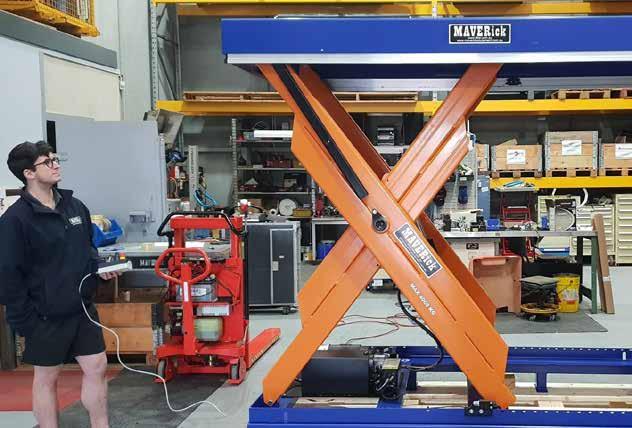
years. If it ain’t broke, don’t fix it,” he says.
Maver’s pretty happy with that state of affairs.
“It’s never been about the money. I
could have sold it to a big company but what’s the point of spending 40 years building it up, when they’d gut it and destroy it in a year because they don’t see us having enough volume.”
And as for having him around for the next while, his staff are already adapting.
“We might have to wheel him into the retirement home,” says Sally Wilcox in the background, to much laughter.
MATERIALS HANDLING
maverickequipment.com.au
MAVERick
“There’s only so much golf & quality time you can handle!”
MAVERick core team (L-R) Rohan Plaw, Greig Maver, Sally Wilcox, Sean Higgs
USG Boral TS-4000
“They call us because they know we’ll fix the problem or put them in the right direction.”
Industry Update Issue 130 Feb/Mar 2023 | 49 industryupdate.com.au
Alsco LT1001TE Loading into bin
Australian manufacturers should aim for global reach
By Tate McFarlane, Engineering Director of Bomac Engineering
Gone are the dumb, dirty and dangerous manufacturing jobs; advanced manufacturing is making way for the clean, clever and critical jobs for the future. Australia now finds itself in the interesting position where the nation’s manufacturing sector has the opportunity to establish itself as a pillar of the Australian and even world economy. Prosperous nations, influential in regional and world politics — namely China, the USA and Germany – are manufacturing juggernauts, but there is room for other significant manufacturing economies.
Many nay-sayers will argue Australia is simply too small, or that we need to focus on high-end niche products because mass products can’t be cheaply made here. But if a small country such as England was once considered ‘the workshop of the world’ and Staedtler pencils are still made in Germany despite high labour costs, then it’s possible for Australia to be a bigger player in the manufacturing world.
Australian manufacturing is now well positioned to meet changing global needs and it is imperative the industry focuses on sectors with strong growth prospects. Sectors such as clean energy, food and medical technology will lead us to a healthy, wealthy and wise future. People will always want food, and populations are growing. By focusing
on sustainable food technologies, such as low-impact, precision agriculture, clean-energy food production, food waste production and alternative protein sources, Australia could become an even bigger exporter of food and agricultural products.
sector in Australia. It’s good that Australia has the chance to reduce its carbon footprint with abundant solar, wind and possibly water resources, yet the real benefit lies in Australia being able to generate cheap, clean power.
Manufacturing clean energy will enable Australia to build on its natural advantages and develop battery storage, green hydrogen production and other emerging technologies to create an affordable and reliable energy source and possibly export this power to other countries in south-east Asia.
Combine cheap power with a skilled labour force, efficient logistics, easily accessed raw materials and favourable government policies — then Australia would have the building blocks to grow manufacturing and the right ingredients to make companies competitive on a global scale, and to secure the country’s future prosperity.
tax-funded military contracts, we can build a manufacturing industry that is self-sufficient and in demand from local
Medical technology is another area where Australia could lead. The world’s ageing populations mean there’s growing demand for medical services and treatments. Advances in medical technology such as artificial intelligence, biotechnology, advanced diagnostics and treatments, all lead to significant.
Finally the clean energy sector also offers opportunities as the world moves to a low-carbon economy — and this is fundamental to a strong manufacturing
Steel plate to cutting table

The question is, what’s the best way to get large steel plates quickly and efficiently onto a plasma, laser or flame cutting table?
Some companies are still using labour-intensive and even unsafe slings and chains to manipulate plates or sheets onto cutting tables.
A far more effective and time-saving way is to use permanent-electro magnetic lifting systems from Mag-Tecnomagnete, supplied by Serpent & Dove - Applied Magnetics in Australia and Asia-Pacific.
One user who recently sought a quotation for a second system said, “the first
one we installed has paid for itself in just a few months!”
With systems to both load whole sheets and unload cut sheets, these permanent-electro lifters use power only for a few seconds during the activate and deactivate phases.
They require no weighty and expensive battery back-up.
Serpent
Australian manufacturing could create new jobs, improve quality of life and increase exports — all while contributing to a more sustainable and prosperous future.
Now is the time for the government to support local manufacturers when the world is on the edge of a new age. The Stone Age did not end because we ran out of stones but because we found better, smarter ways to live.
It’s possible that, unlike US manufacturing which relies so heavily on
and global markets.
Bomac Engineering has helped Australian manufacturers lift and move products safely and effectively since 1984. Bomac created Altrac, a standard product that could be adapted to suit applications. Altrac cranes and heightsafety systems have been used across Australia and increasingly worldwide.
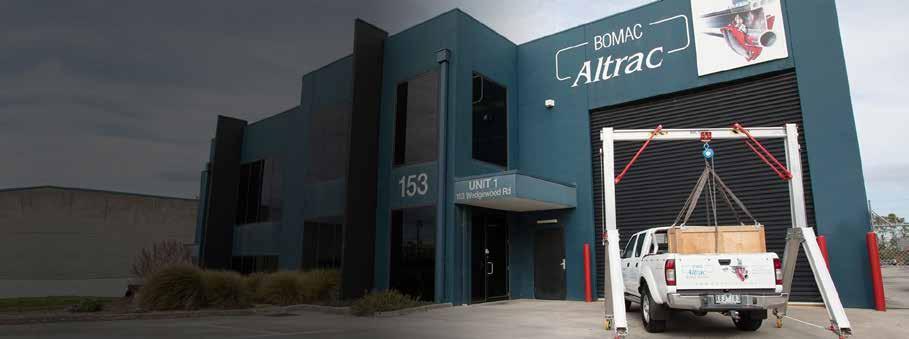
MATERIALS HANDLING
“Sectors such as clean energy, food and medical technology will lead us to a healthy, wealthy and wise future.”
“The Stone Age did not end because we ran out of stones but because we found better, smarter ways to live.”
Bomac Altrac bomac.com.au
& Dove Applied Magnetics serpent-dove.com.au
50 | Industry Update Issue 130 Feb/Mar 2023 industryupdate.com.au
PUMA leaps with AutoStore Router
Router software from robot technology company AutoStore is the brains behind a 10% increase in capacity at sportswear giant PUMA’s US distribution centre.
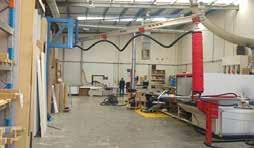
PUMA was already using an automated storage and retrieval system (ASRS) in its Indiana-based distribution centre. The implementation of Router software yielded significant benefits.
The ASRS at PUMA’s distribution centre incorporates a fleet of AutoStore Black Line Robots – all programmed and managed by the Router software platform. With these solutions, the centre has achieved a 10% increase in capacity and a 25% increase in hourly bin deliveries.
In the fast-paced world of material handling and logistics, warehouse owners are increasingly under pressure to achieve faster picks, higher throughput and improved inventory rotation. A longstanding AutoStore customer,

“The Router platform has been demonstrated to boost performance by up to 40%,” says Jason Wu, Business Development Manager at AutoStore Australia and New Zealand. “In micro-fulfillment centres, for example, where warehouse space is limited and warehouse owners want to get the most out of their ASRS solutions, the Router software proves an excellent solution. It maximises all of the benefits of the ASRS system: space efficiency, flexibility, scalability and speed.”

Router makes use of proprietary algorithms that recalculate every route for every robot on the user’s grid, every
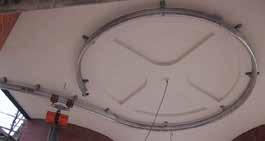

second. It is designed to identify the most optimal route to the target destination, maximising performance even on high-density grids.
“An added benefit is that the robots travel shorter distances and make fewer turns, meaning that they require less maintenance over time,” says Wu.
The new Router software can handle twice the number of robots within the same space footprint.
“This enables the user to accelerate the picking and fulfilment process, even in a system with higher robot density and where space is limited,” says Wu. “It’s been shown to boost throughput by four times.”

This software earned AutoStore a nomination for the Material Handling Product News (MHPN) and MaterialHandling247.com 2020 Product of the Year Readers’ Choice Award.

“In the local market, where our customers are seeking out solutions that help them maximise the efficiency and productivity of their ASRS systems, Router is adding significant value by increasing capacity and efficacy,” says Wu. AutoStore autostoresystem.com

MATERIALS HANDLING
Jason Wu, Business Development Manager at AutoStore Australia and New Zealand
Industry Update Issue 130 Feb/Mar 2023 | 51 industryupdate.com.au
AutoStore BlackLine Robot on Grid
Let data drive efficiency
Inadequate data management is one of the main warehousing challenges.
To help businesses collect and act on data-led insights, automated storage and retrieval system AutoStore has launched Unify AnalyticsTM, a cloud-based service and data platform.
Unify Analytics enables AutoStore users to easily identify causes of operational challenges.
“In a competitive market where efficiency, lean operations and error-free productivity are key, Unify Analytics offers customers significant benefits,” said Jason Wu, Business Development Manager for AutoStore Australia and New Zealand.
“Users will enjoy enhanced predictive maintenance, improved use of warehouse space and retrieval, as well as less waste and redundancy.”
AutoStore is a robot technology company which is pioneering cube storage automation — the most dense product and inventory storage. The company’s focus is to marry software and hardware with human abilities to benefit warehousing and businesses.
Unify Analytics is available in two versions: a web application where
businesses can view real-time statistics and analytics, and an application programming interface (API) that enables seamless integration with any external third-party applications.
Andreas Munch, Product Manager at AutoStore, believes businesses can reap multiple benefits by combining automated storage and retrieval, and data-led insights.
“This data analysis tool will allow businesses to be more proactive and respond rapidly to real-time challenges,” said Munch.
The metrics
Unify Analytics consists of several performance analysis dashboards that provide graphical presentations of operational information. Examples of available data are uptime and number of stops within the system, waiting time per bin, average distance per robot, and the number of tasks a customer has prepared in the system each hour. It also shows if the software and firmware have been updated.
“Data is only effective if we measure the right metrics,” Munch said.
“We currently include a selected list of
key metrics which we will develop with our users and add new features to the software gradually.”
AutoStore developers plan to include an alert function. End-users will get a notification via email or SMS when set conditions are triggered, allowing businesses to respond quickly to operational challenges to proactively minimise downtime and resolve issues more quickly.
A single data platform
The AutoStore System continuously generates vast amounts of information, organised onto a single platform that’s highly protected for security
requirements.
“The new analytics tool secures access to real-time and logged data and is only accessible to designated end-users and distribution partners. We automatically deploy software updates when available without any downtime,” says Munch.
Unify Analytics is intuitive and easy to use and does not require any training or extensive technical skills to implement.
adeptconveyor.com.au
sales@adeptconveyor.com.au
(02) 9771 4655
The Australian manufacturer uniquely servicing the Australian market
Presenting a flexible approach to design and manufacturing for most automation and conveyor needs.

Will only build using our exclusive product range sourced solely out of Europe and never short of supply with the largest local stock holding of any conveyor supplier ensures that our delivery times will be shorter.
As we are joint owners of our product suppliers and enjoy the most favourable and exclusive pricing for all quality hardware. We never have to wait in line and are never restrained by overseas interests before our own.
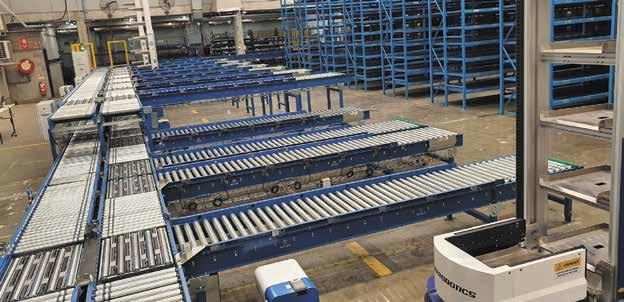
MATERIALS
HANDLING
We specialise in design capabilities including: • Warehouse order processing & fulfilment systems. • Freight & courier handling systems. • Sanitary Food production & processing conveyors. • Core sampling roller racks for the mining industry. • Custom unique conveyor-based designs.
AUSTRALIAN MANUFACTURER EUROPEAN COMPONENTS DECADES OF EXPERIENCE
AutoStore autostoresystem.com 52 | Industry Update Issue 130 Feb/Mar 2023 industryupdate.com.au
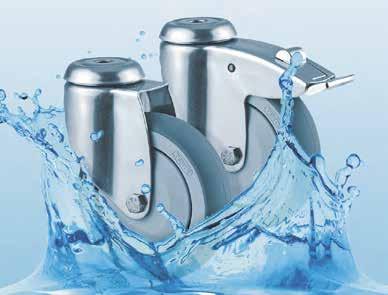

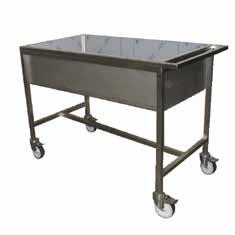
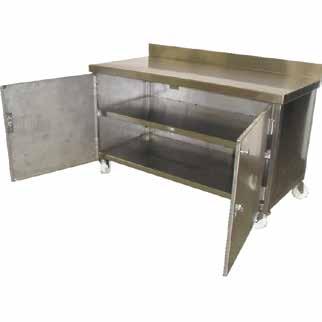



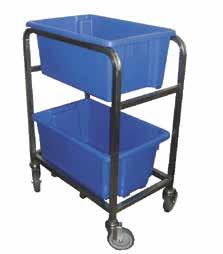
TENTE STAINLESS STEEL CASTORS BETTER MOBILITY IN PREMIUM QUALITY CUSTOM INDUSTRIAL STRENGTH EQUIPMENT – FITTED WITH QUALITY TENTE CASTORS 1300 836 831 | tente.com.au AGILA STAINLESS STEEL SERIES ALPHA SERIES Institutional Series for Loads up to 100kg Industrial Series for Loads up to 500kg Tente can also Design and Build Trolleys, Workbenches & Storage Equipment – all fitted with Quality Tente Stainless Steel Castors. Contact Tente for Custom Stainless Steel Equipment & Stainless Steel Castors TENTE CUSTOM STAINLESS STEEL FABRICATION
Australian company Eilbeck
Cranes has flourished in the face of fierce competition from other multinational companies and its cranes are sought in many diverse industries around the world.
The company specialises in overhead cranes, electric wire rope hoists, jib cranes

winches to various sectors within the Australian market. Each crane it produces is engineered to individual needs. The company’s efficient, flexible approach means it can deliver customised overhead cranes at competitive prices.
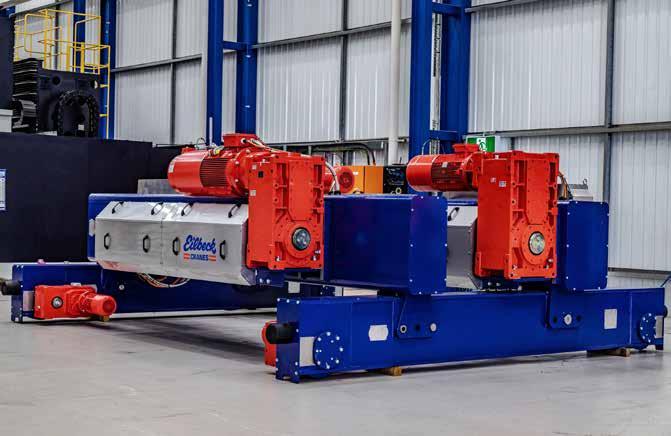
The origins of the business go back to the Swan River in Perth, where it started
Director Tom Eilbeck started in the family business as a welder in the company’s workshop in 1975.
“Now, in the fifth generation of our family business, Eilbeck has evolved into a crane business employing more than 325 staff .”
Eilbeck continues to evolve. It has nine factories and eight service centres operating at full steam in Sydney, Melbourne, Perth and Brisbane, and recently bought a new building in Ingleburn, New South Wales.
“Our new factory floor spans 2600 m2 and we are building another facility in Moss Vale which spans 5000m2 on a 11000 m2 site.”

“Our truly national footprint means that we are within close proximity to every major infrastructure upgrade in Australia.”
Booming business
Strategic locations no doubt helped the company double its sales since last year.
“Infrastructure development has been a high priority of the government for some time but supply chain issues with China meant that more companies were looking locally for cranes. In fact, 2020 was our best financial year and 2022 is set to become the most profitable year in our company’s history to date.”
Eilbeck says the signs are clear, “the Australian economy is growing.”
“The steel industry is expanding — we are involved in a billion-dollar furnace relining project in Wollongong, supplying three slab cranes (65 tons x 36 meters) that are fully automated. New windfarms are going up and the steel industry is upscaling at an incredible pace.”
In addition, Eilbeck sold 25 new cranes for government projects in the NSW region. “Money is being spent across the board. We are in the process of employing more electrical engineers, boilermakers, and welders to keep up with demand.”
Robust gearboxes
Eilbeck has been involved in tunnelling since 1996, including most major tunnelling projects in and around Sydney, Melbourne and Brisbane.
Eilbeck’s tunnelling cranes were provided for projects such as the M6.
The Sydney Metro West has four tunnels from Sydney CBD to the new Sydney airport and cranes for three of the four tunnels under contract with Eilbeck. The T48 tunnel between St Mary’s and the airport has three cranes which all featuring Bonfiglioli products.
The relationship between Bonfiglioli and Eilbeck dates back 25 years.
“ We developed our own heavy-duty high speed mucking hoist for tunnelling work and invested a considerable amount of money in this development. It is purpose built and needs to be 100% reliable. We chose the HDP series from Bonfiglioli for the hoist,”
“The products are built to work for three years but in those three years, they do what a normal crane would do in 10 years. Bonfiglioli’s robust gearboxes are built to withstand this demanding application – they work tirelessly without fail.”
Harry Singh, Sales Manager for Bonfiglioli NSW believes there is always room to improve and grow.
“HDP 100, 110 to 120 sizes all play a key role in Eilbeck’s special crane designs,” says Singh. “However, gearboxes like the HDP160 provide output torque capacity of up to 147kNm and can easily accommodate a larger motor size of between 132kW to 500kW — depending on the crane size and speed, while they are working flat out.”
Singh says high demand means Bonfiglioli puts a lot of focus on administration and customer service through pipeline management for key OE customers like Eilbeck.
“Bonfiglioli works ahead on solid opportunities with Eilbeck who require a quick turnaround on designs and technical clarifications when it comes to tenders/ordering. Having product on hand for new orders and spares is crucial to the company’s uptime demands.”
Eilbeck’s cranes run six days per week. “We are charged penalty performance rates if this isn’t the case,” says Eilbeck. “So we rely on hardworking, robust components. The cranes are serviced every fortnight on a Sunday so you can imagine there’s no downtime on these sites.”
The standard hoist is designed around Bonfiglioli’s HDP series.


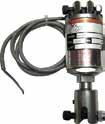
“Price and service come standard but what we really need is a company that can work at our pace,” says Eilbeck.
Singh says Bonfiglioli is proud of not just selling to Eilbeck but being part of the collaboration that’s building Australian infrastructure.
“When I’m driving on the M4, M5, the North Connex or West Connex, to name just a few, I feel a strong sense of pride knowing that we work in partnership with a fully owned, Australian company to make these projects a reality.”
MATERIALS HANDLING
Liftco Industrial Supplies Pty Ltd sales@liftco.com.au www.liftco.com.au ( 0 2 ) 9 8 2 9 4 411 REDUCE MAINTENANCE COSTS ON OVERHEAD CRANES LOAD LIMITERS ROPE AND CHAIN CRANES AND HOISTS • Helps reduce the risk of accidents • Protects against overloading of Crane and supporting structures • Quick and easy installation and available for all capacity cranes • Available preset or easily calibrated on site • Helps reduce maintenance costs • Minimizes down time • Automatic reset by reducing the load CONDUCTOR BAR • Available in steel & copper • Quickly and easily installed • Supports required only every 1.5m • Also available in a compact cluster range SIDE PULL PREVENTERS / ROPE GUIDE PROTECTOR vents side pulling and tects rope guides and drums most multi-fall cranes & hoist Prevent dragging of loads Helps reduce down time Building infrastructure with Bonfiglioli and Eilbeck Eilbeck Cranes powered by Bonfiglioli motors Bonfiglioli bonfiglioli.com 54 | Industry Update Issue 130 Feb/Mar 2023 industryupdate.com.au
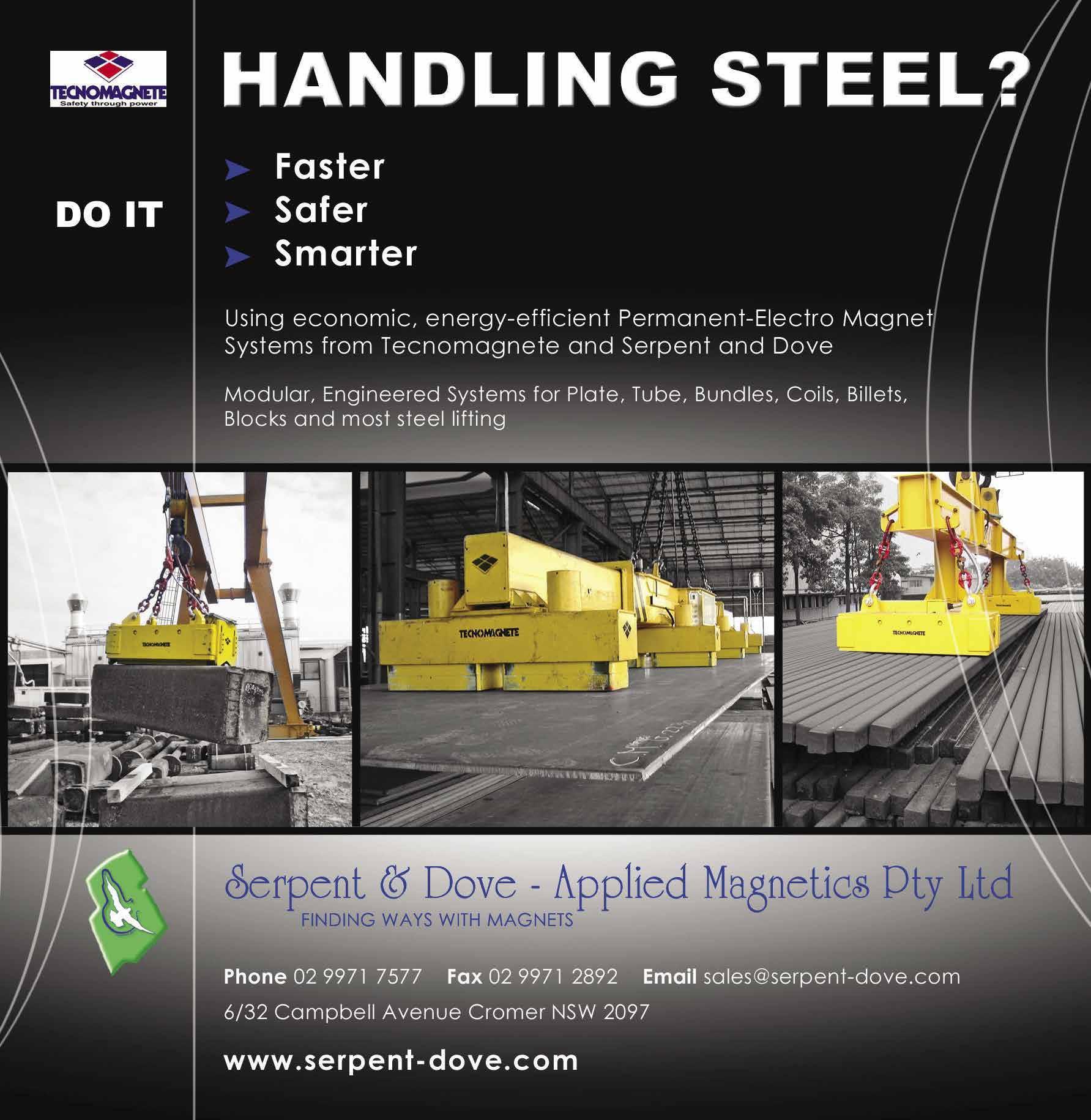

industry update ad.indd 1 30/08/2011 5:25:30 PM Phone: 02 9971 7577 Email: sales@serpent-dove.com.au
Marsh Mellow springs cut hazards and waste
Vibration occurs in all rotating or reciprocating machinery, and sometimes it’s intentional. It’s also caused by imbalances in rotors, bearings, springs, and gears as vibration migrates to surrounding structures and wear-prone components. If vibration is not controlled within its intended limits – and where metal springs may bottom out, settle, crack, or break occur — the consequences of unintended actuation and isolation patterns can include:
• Energy waste due to kinetic energy of unwanted vibration
• Bottoming out under overload and surge, sending a large amount of stress to all of components
• Bearing failures, metal spring cracking and collapse, metal structure cracking – potentially leading to unexpected plant shutdowns

• Operator fatigue and noise nuisance (a factor in workers’ comp issues)
A simple, robust, and effective means of solving vibration and isolation problems is Marsh Mellow® springs — fabric-reinforced, solid rubber isolators for quiet isolation of vibration and general shock absorption.
The cylindrical springs, developed by Firestone, are used worldwide as an alternative to metal coil springs for applications in building, construction, computer, electrical and electronic equipment isolation, including with motors, gearboxes, compressors, conveyors, materials handling machinery and shock absorbers.
“Marsh Mellows give consistent performance regardless of changing loads, while offering high lateral stability and compact size,” says James Maslin, Technical Product Manager, for Marsh Mellows’ Australian distributor, Air Springs Supply.
“And they can more compactly and inexpensively replace metal springs in many applications,” says Maslin.
“Naturally different types of springs have different performance characteristics suited to particular tasks. These should always be discussed with suppliers who have wide experience in the particular area of application being considered,” he says.
Marsh Mellow springs are constructed of a solid rubber core with a hollow centre and several plies of fabric-reinforced rubber as an outer


cover. The plies provide the springs with stability as well as a consistent cylindrical shape, says Maslin, whose Air Springs Supply experience spans several hundred applications of both solid Marsh Mellow and hollow, bellows-type, Airmount® air springs throughout Australia.
Tolerant of overload
“Marsh Mellow springs are quiet in operation, unlike steel springs which readily transmit high frequency structural noise and often suffer from coil chatter. A failing coil spring may crack, causing fragments of the coil to damage equipment, resulting in expensive downtime. This problem is eliminated with Marsh
Mellow springs, which are tolerant of overload and, if they ever do fail, do not fail catastrophically.”
“The quiet performance of Marsh Mellows – and the fact that they resist water and grit – means they are ideal for applications where high levels of workplace safety and hygiene are essential. Such applications can range from manufacturing metals and minerals plants through to primary processing, timber and paper, food, and beverage.”
MATERIALS HANDLING
56 | Industry Update Issue 130 Feb/Mar 2023 industryupdate.com.au
Air Springs Supply Pty Ltd airsprings.com.au
Getting mineral logistics moving come rain or shine
With its expertise in specialised engineering plastics, Cut To Size Plastics is helping the minerals sector overcome logistics bottlenecks caused by heavy rains across Australasia and Asia.
Amid surging coal prices and strong demand for high-value minerals, record rainfalls across Australia and the surrounding region are posing major challenges to materials handling, production and profits. While urban centres such as Sydney attracted headlines in 2022 with their highest rainfall ever recorded, the problem has been equally dire in major Eastern coal areas and mines and ports in the West and North. New Zealand, South-East Asia and India have also been inundated.
“All this moisture and long-term rain makes coal sticky, heavier and harder to handle for the mines, as well as for the organisations transporting it and the ports and power stations where it arrives,” says Laurie Green, Managing Director of Cut To Size Plastics. “Ceaseless rain also causes major disruptions – even Force Majeure events –at iron ore and other mineral mines.”
Cut To Size fabricates bespoke chute, bin, truck, rail and shiploader linings from Wearex UHMWPE, a low-friction ultra-high molecular weight polyethylene. These linings facilitate product flow and prevent blockages, averting OH&S risks and downtime.
“When using wet or hard-to-handle coal, for example, the use of high molecular weight polyethylene plastic chute liners has become a number-one method to improve the flowability of coal chutes,” says Green. “The same benefits apply to harder mineral ores, where clogging, production hang-ups, and loading and unloading issues can cause costly production interruptions and OH&S issues. This climate change issue is not likely to go away anytime soon, and highflow liners are one way of effecting major improvements promptly.”
Working with miners, transport operators, ports and stockpilers, Cut To Size custom-engineers tough plastics formulated specifically for the mining industry and the challenges it faces. For the toughest wear-prevention, the new plastics are based on the globally proven Wearex. As a member of the UHMWPE family, Wearex has the highest abrasion
Chewing up springs?
resistance of any thermoplastic polymer.
When used as a wearliner, UHMWPE will not cake or stick to metal, and offers excellent noise abatement in material-handling applications. It is the highest-quality polyethylene (PE) available, engineered and custom-formulated for a range of tough applications such as handling coal, minerals and aggregates. With a molecular weight range around ten times that of high molecular weight (HMW) resins, UHMWPE resins are strong enough to withstand abrasion and impact better than lower-level products.
“It is certainly not one size fits all,” says Green. “The process of engineering plastic selection and formulation is a scientifically demanding business in which we rely on our own expertise supported by some of the world’s leading suppliers of product.”
One big problem is the variability of throughput: “Good operators can account for specific moisture content or rock content coming down the line or going on the trucks, but the material
UHMPWE and other tough engineering plastics are used to line bin and transport trays

coming through may not be consistent. One lot will be wetter than the next; the next lot will have more rock; and so on. They have to address the problem holistically, and this sometimes involves lining chute systems and truck trays with materials that give high slip performance right across the spectrum.”
Noise, corrosion, cracking, breakage, vibration, shock, abrasion, bottoming out… springs too stiff or mushy under hanging loads… high maintenance and lost production...

Do these vib amiliar? Then meet the oblem solver Marsh Mell

These unique solid rubber ors wide or quiet isolation of machiner y vibration and for shock rption in applications including food and beverage, metal manufacturing and mining and energy
Vibration Isolation Design Manual for Marsh Mellow ings details how and where to use compact, cylindrical Marsh Mellow springs for machiner y such as compressors, vibrating screens, bin hoppers, blowers and motors, cranes, hammers, bumpers and conveyor stops.

MATERIALS
HANDLING
www airsprings com au Air Springs Supply Pty Ltd ● (02) 8877 5500 ● sales@airsprings com au Unit 18/38-46 South Street, Rydalmere, NSW 2116
To Size Plastics cuttosize.com.au Industry Update Issue 130 Feb/Mar 2023 | 57 industryupdate.com.au
Cut
SA leads the way in testing and trialling of Industry 4.0
by Margie Smithurst
A HoloLens trial at Line Zero, Tonsley
Germany has its Fraunhofer Institutes, the UK its Catalyst centres, but until recently, Australian manufacturing hasn’t had anything resembling these powerful and enduring collaborative initiatives.
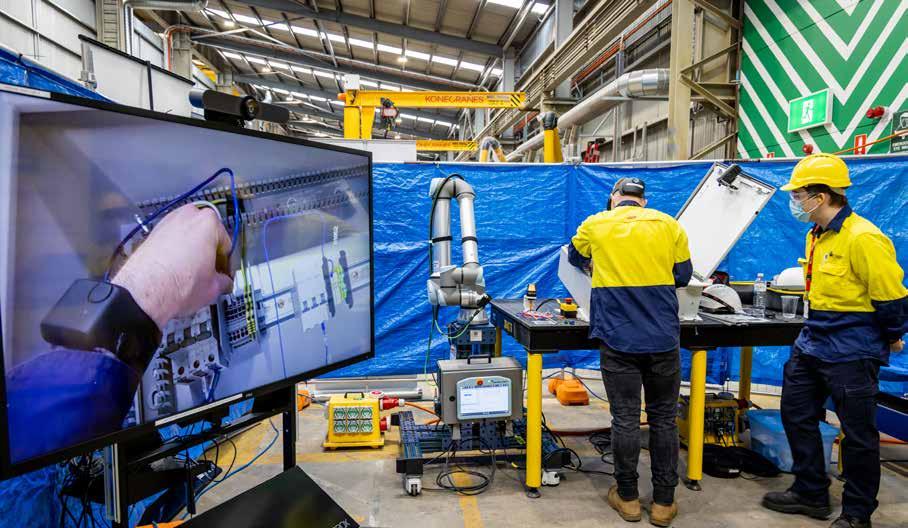
South Australia’s Line Zero Factory of the Future, established in 2020 in the Tonsley Innovation District of Adelaide, mirrors the purpose of the German and UK centres, which is to help industry build and accelerate its advanced manu-

(AITI), and Pro-Vice Chancellor of Research Impact at Flinders University – the driving forces behind the Factory of the Future concept.
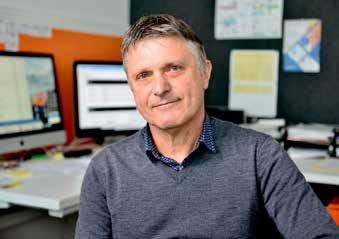
The catalyst was the $34 billion Hunter Class Future Frigate program, a shipbuilding bonanza that drew defence giant BAE Systems to the state.
“We were looking for a space to prototype a new way of collaborating with industry. Historically, a lot of collaboration happens in traditional laboratory environments within universities, and is largely undertaken by researchers for industry. But what we were wanting to do is actually embed industry in the research projects themselves.
“And of course, there’s nothing like a massive project to enable something like that to occur,” says Spoehr.
first… pop-up factory of the future environment… where we’ve been running all sorts of tests and trials of different kinds of technologies and processes for potential application in the shipyard at Osborne in the north of Adelaide.”
But the term ‘pop-up’ only applies to the projects, as this site is expected to be an enduring one, with at least four years’ worth of investment from industry,
New facility planned
It also laid the foundations for securing more government funding to build a new Factory of the Future facility, next to the existing one.
facturing and digital maturity.
“We reckon we’re building the foundation for Australia’s first industrial-scale, advanced manufacturing facility for testing, trialling and training,” says Professor John Spoehr, wearing the two hats of director of the Australian Industrial Transformation Institute
Using the old Mitsubishi car manufacturing plant, a 1000 square metre sawtooth shed that fittingly resembles a shipyard and is the size needed for large scale potential industrial applications outside the lab, Flinders Uni and the AITI established an incubation space for BAE to work alongside researchers, calling it ‘Line Zero’.
“We think it is probably Australia’s
government and universities.
That level of permanence is something that’s been missing from Australia’s innovation ecosystem, says Spoehr.
“In Australia, we tend to rely on things like Cooperative Research Centres and more of a project driven approach to building skills and capabilities, and a lot of that dissipates when the CRC comes to an end.
“The way of overcoming that is to establish these kinds of intermediary institutions in innovation districts like Tonsley, where they’re most likely to be successful. But also, very importantly, with anchor prime companies involved in them, like BAE.”
FOCUS ON SOUTH AUSTRALIA
Spoehr says the success of the Line Zero site for both researchers and the BAE workforce, saw BAE shift its research and technology office to the Tonsley district.
Professor John Spoehr, director of the Australian Industrial Transformation Institute (AITI), and Pro-Vice Chancellor of Research Impact at Flinders University
L-R Australian Industrial Transformation Institute staff Dr Sara Howard, Ryan Jang, Kosta Manning with Spot the dog at Line Zero.
58 | Industry Update Issue 130 Feb/Mar 2023 industryupdate.com.au
“Australia’s first industrial-scale, advanced manufacturing facility for testing, trialling and training”
“We’re going to keep the Line Zero site fully operational over the next few years, and who knows, it may well be an enduring feature of what we do here. But we will have a purpose-built building on site here with multiple industry partners, including BAE and its supply chain… a 3000 square metre, bespoke facility for testing and trialling technologies, and also for education and training in support of that within companies.”
Not just defence applications
When the federal government announced $10 million in October 2022 for the expanded facilities, it noted that more than 200 South Australian small to medium-sized businesses would benefit from building their technological capabilities and getting a foothold in critical supply chains.
to the processing of algae and kelp for nutraceuticals and cosmetics.
The state’s considerable mining and energy sectors are also in their sights.
“We’re keen to support the development of the supply chain around [South Australia’s] emerging hydrogen industry, which over the next 10 -15 years could well be a very rapidly growing renewables sector alongside the very substantial PV sector that we have here in South Australia.
Importantly, use of the facilities won’t be just for defence purposes – it will spill over into other sectors such as construction.
“The construction sector has a lot in common with shipbuilding,” says Spoehr.
“They aspire to use advanced manufacturing technologies, digital processes and digital twins to bring construction methods into the 21st century, particularly through off-site and modular construction…
“Applying advanced manufacturing processes in factory facilities to build houses and commercial buildings and then take them on site and assemble
“There’s also an enormous appetite within mining to apply robotics, automation, augmented reality, virtual reality technologies and so we’re exploring how we might work with a number of mining companies.”
On-site technology training
Alongside the businesses that’ll use the facility, Flinders University offers a foundational ‘Diploma of Digital Technologies’.
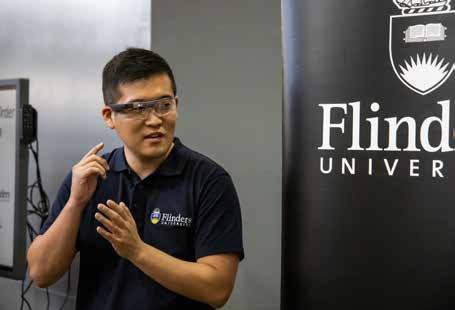
“One of the biggest barriers to the successful uptake of advanced manufacturing technologies and processes is skills
went through were from shipbuilding and then off the back of that program, we’ve had a tranche of school teachers coming through. For them it’s in-service training and development in terms of the STEM agenda within schools and [is about] building the teaching workforce to be able to support the modernisation of Australian manufacturing.
“A big challenge for us as a university is keeping pace with the demand for digital skills and capabilities.”
Another challenge, Spoehr suggests, is to get similar facilities off the ground around the country.
“We hope that this might be a source of inspiration for other evolving industrial districts in Australia, like Fisherman’s Bend [in Melbourne] and Aerotropolis [in Western Sydney].
“So, lots of lessons in it for Australian policymakers I think.”
Industry Update Queensland Manufacturing feature
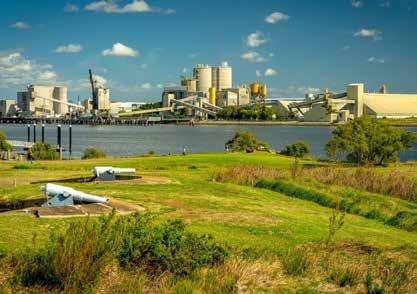

them is part of the vision here.”
The facility is also working with SA’s marine biotech sector, the so-called ‘blue economy’, in the application of advanced manufacturing technologies
and capabilities at the company level.”
“[The diploma is] basically an introduction to Industry 4.0 and all the key enabling technologies.
“The first tranche of students that
FOCUS ON SOUTH AUSTRALIA
Members of the Flinders University and BAE Systems Australia - Maritime research team at Line Zero, Tonsley
Ryan Jang, Australian Industrial Transformation Institute wearing HoloLens glasses
“The construction sector has a lot in common with shipbuilding”
“One of the biggest barriers to the successful uptake of advanced manufacturing technologies and processes is skills and capabilities at the company level.”
Are you running a business in the manufacturing and industrial industries in Queensland and want to tell the nation? Get involved now to promote your products and services to over 72,000 decision makers. To book an advertisement that is supported by editorial, contact Bookings: Scott Filby scott@industryupdate.com.au Editor: Christine Powis editor@industryupdate.com.au Writer: Margie Smithurst writer@industryupdate.com.au Industry Update Issue 130 Feb/Mar 2023 | 59 industryupdate.com.au
Tailor-made measurement
Since humble beginnings more than 70 years ago as a mechanical scale factory in Adelaide’s industrial innerwest, A&D Australasia has developed and flourished through technological changes to become the accomplished measurement solutions provider it is today.
Whilst products and society have advanced infinitely in that time, A&D Australasia is proud to employ a skilled team at that same Thebarton factory.
With the innovation of digital technology through the 1980s A&D introduced many highly sophisticated weighing machines ranging from laboratory balances that could weigh an ant’s lunch through to heavy vehicle weighbridges that weigh road-trains.
A&D’s core competency, weighing, was rounded out by devices associated with moisture analysis, viscosity measurement, and general process control — all Japanese made by parent company A&D Company of Tokyo Japan.
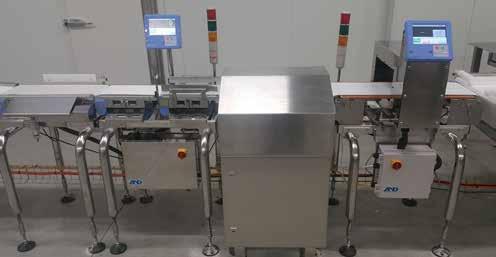
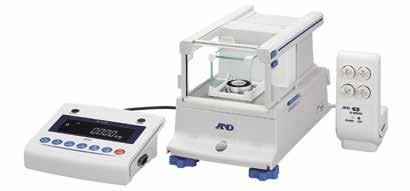
New business and consumer trends brought new demands in product awareness and safety: in response, A&D further grew its range of products.
Product inspection
While never straying far from its core roots of measurement, A&D has further expanded with the establishment of a product inspection business unit. The product inspection portfolio includes in-motion, conveyor-based checkweighing, metal detection equipment and a most recent addition of X-Ray devices.

Contamination crisis
A&D’s metal detection equipment assumed national notoriety during the ‘strawberry contamination crisis’ of 2018, where the
strawberry industry would have been brought to a total standstill without the timely intervention of the A&D AD4971 metal detector which played a pivotal role in allowing the industry to regain its position, and customer confidence, in a very short time.
With the advent of these new measurement disciplines came a new customer attitude of wanting to embrace the new technology but of not wanting to disrupt the physical make-up or layout of their production facility in order to implement it into their business.
Customisation
A&D Australasia recognised this market phenomenon very early and invested heavily in highly skilled mechanical, electrical, process control and X-ray engineers in order to provide customers with a bespoke, highly customised solution to meet their needs.
No longer is the customer required to adjust the height of this or remove a section of that, today’s solution needs to fit in with the existing
factory configuration to provide a truly effortless experience.
This process of consultation and then customisation is critical to the A&D ethos and drives our desire to provide our customers with a tailor-made solution for their respective needs.
The Covid years provided a very clear illustration of the benefits of control and automation where human resources may not be available or equally well allocated to a different, more critical, aspect of the business.
What was desirable in the pre-Covid years became absolutely essential during those times where people were hard to find, but the demands of supply contracts became even more stringent.
Compliance is key
The product inspection range has been critical to food producers, who now must provide evidence of compliance with food safety standards before their product will be accepted by large food distribution outlets.
This compliance cannot be left to chance and the use of sophisticated detection equipment will remove the possibility of human error and potential issues further down the supply chain.
Not only is compliance a key consideration for today’s business operator but also maximisation of raw material yield.
Many producers are now looking to pack their produce using the average quantity system (AQS) process and A&D inspection equipment will work hand in glove with an AQS set-up, as our units feature specific software to ensure accurate compliance and reporting.
As a proud member of the Australian Packaging & Process Machinery Association (APPMA), A&D Australasia has formed new, highly valuable, relationships with packaging and materials handling businesses that have raised the skills and understanding of A&D’s engineering team of bulk handling, storage and transportation of a highly varied selection of individual products and materials.
This materials handling knowledge, when combined with the existing measurement expertise of A&D engineers, and the extensive market understanding of our sales consultants, ensures a truly unique, totally fit-for-purpose, product outcome.
This ability to design, engineer and produce bespoke equipment solutions has placed A&D Australasia at the forefront of the measurement and product inspection markets.
From the humble and honest beginnings as a mechanical scale business through to today’s sophisticated inspection, control and automation enterprise, the principles and core competencies have remained constant, and have established A&D Australasia as a true measurement force in the Australian business landscape for close to 80 years.
FOCUS ON SOUTH AUSTRALIA A&D andaustralasia.com.au
BA Microbalance - micro-weighing accuracy to 1,000,000th of 1 gram or an ant’s lunch
Bespoke Measurement System - checkweighing and metal
60 | Industry Update Issue 130 Feb/Mar 2023 industryupdate.com.au
Customised Solution - X-Ray & Checkweighing with Dual Reject on Portable Plinth
detector
combination with dual side reject




Providing smart, automated solutions for Australian manufacturers. 1800 242 434 www.andaustralasia.com.au Disco ve r P re cisio n Weighing Inspection Compliance
Adelaide to host renewable future

Adelaide will host the 2024 International Renewable Energy Conference (IREC) on 7-11 April 2024 — the first to be held in Oceania.
The Paris-based convenor, the Renewable Energy Policy Network for the 21st Century (REN21), is headquartered in Paris and South Australia is its only sub-national member. Hosting this event bolsters South Australia’s role in Australia’s transformation to a clean energy leader.
The conference is expected to draw about 3,500 global leaders from government, industry, science and NGOs to share the latest in renewable energy and their plans for a clean energy future. It will also strengthen international trade partnerships.
South Australian Minister for Energy and Mining Tom Koutsantonis said the opportunity to host the event in Adelaide further strengthens the state’s green credentials.
“The conference will showcase South Australia’s renewable energy agenda, including our planned hydrogen hub on the Upper Spencer Gulf.”
“The Malinauskas Labor Government has worked hard to re-energise the state’s tourism sector, through major events, sport and significant conferences such as this,” Minister Koutsantonis said.
A key part of the Adelaide conference, dubbed AUSIREC 2024, will be to consult with and involve Australia’s First Nations peoples in deploying clean
SA to build with local materials
The South Australian government has mandated that public housing will be built with products made in South Australia whenever possible.
The reform puts into action the Malinauskas’ government’s election promise to point government procurement to locally made products so that taxpayers’ money helps boost manufacturers and materials processors such as timber, and send a positive ripple effect through businesses and the community.
“If we can change the buying habits of government departments away from interstate and overseas suppliers to local South Australian businesses, it’s a huge boost to the local economy,” said SA Treasurer, Stephen Mullighan.
Importantly, the government has also made a $177 million commitment to build 400 new affordable homes and refurbish a further 350, to help people
in need. The South Australian Housing Authority is set to release tenders for 103 homes to be built by 90% local labour.
“I know every contract counts and can make a big difference,” said Andrea Michaels, Minister for Small and Family Business.
“I’m proud our government is giving hard-working South Australians a competitive edge and ensuring the economic benefits stay right here in SA,” she said.
Core building products including bricks, timber frames, concrete, reinforcing steel, steel frames, windows, security doors and steel for roofing, fencing and rainwater tanks, will be locally made. The government estimates these account for 58% of home construction.

The SA government is targeting an increase of $425 million per year in work awarded to SA businesses.
energy projects, strengthening the government’s commitment to ensure they are included and benefit from the transition to renewables.
Minister for Climate Change and Energy Chris Bowen said IREC 2024 was a fantastic opportunity to showcase the best Australia and Oceania have to offer in renewable energy.
“The future of energy in Australia and the world is renewable, and sharing the latest knowledge with international partners and experts will help make that vision a reality,” Minister Bowen said.
Adelaide’s successful bid for the 2024 event was supported by Tourism Australia’s Business Events Bid Fund Program.
REN21 Executive Director Rana
Adib said that, in building the renewable energy future, “it is imperative to include stakeholders from across society to shape new rules”.
“We welcome the joint leadership of the Commonwealth of Australia, South Australia and the Clean Energy Council in accelerating this transition. We look forward to co-hosting the next IREC with Australia to anchor the global policy multi-stakeholder dialogue process in this needed transition.”
IREC has been held biennially since 2004, with previous conferences held in Seoul, South Korea; Washington DC, US; Beijing, China; and this year in Madrid, Spain.
Adelaide CBD. Photo credit Adelaide Aerial, Adelaide Park Lands
FOCUS ON SOUTH AUSTRALIA Industry Update Issue 130 Feb/Mar 2023 | 63 industryupdate.com.au
it’s humbling to have access to the highest quality German-made product.”
“[Tente] have taken it upon themselves to ensure that they allow us to grow.”
“It’s exciting when you can be involved with these projects from the early days of design, ensuring the customer has the best information for the best possible outcome,” says Damien Lane, business development at Tente.
“At Tente, we understand that the best innovations started somewhere. I con-
NZ startup making life easier for patients and carers
Twenty years ago, the chief surgeon of a hospital in Christchurch New Zealand approached an engineering lecturer at The University of Canterbury and put a challenge to him: “Our orderlies and nurses are still getting hurt transferring people — can you do something about that?”
The Mechanical Engineering Department’s Professor Emeritus Keith Alexander, the inventor of the Springfree Trampoline, took up the problem.
For the next two decades he used student researchers to come up with ideas as to how best to move someone from chair to chair — as frequently done in homes and hospitals for elderly people or people with a disability.
Five years ago, he and investors set up HT Systems and lodged a patent for his idea — the Kera sit2sit patient lifter, a new way of transferring people designed around the natural movement of the body which makes transfers quick and safe.
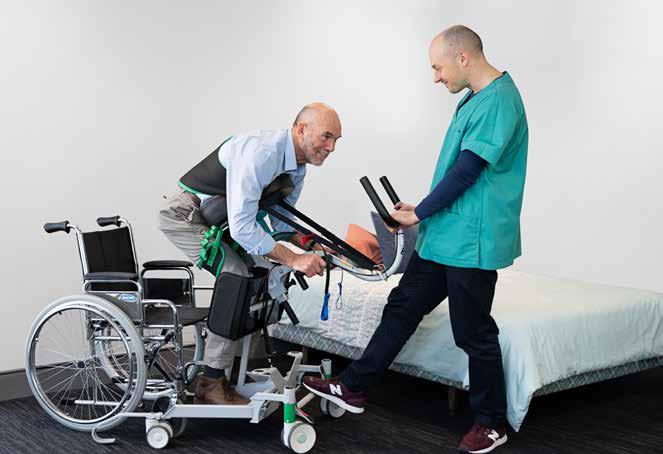
Mechanical engineer and Chief Technical Officer at HT Systems, Alex O’Keefe, is the one who turned the Kera (a play on the Kiwi pronunciation of ‘carer’) into a commercial reality, re-designing it from the ground up.
“The special part of the Kera sit2sit is that it’s a really clever way of holding on to a person comfortably, gently and safely, allowing a caregiver, which is often their partner or loved one, to be able to manually lift them up out of a wheelchair, wheel them over and place them on the bed, without needing the help of two caregivers to do that process.”
According to New Zealand’s Accident Compensation Corporation, around four health care workers a day suffer back injuries.
O’Keefe’s interest in this field is also personal - his sister has spina bifida and spends her life in a wheelchair, so he says he knows what it’s like to be a ‘transfer device’ and to move someone around.
By Margie Smithurst
as technical adviser, had a breakthrough in 2022 when leading health care equipment provider Aidacare approached them to sell the Kera in the Australian market.
O’Keefe says they’re aiming to send batches of 20 per month into Australia in 2023.
sider HT System’s Kera sit2sit perfectly aligns with Tente’s values of ‘better mobility, better life’.”
Crowd-funding the future
Response to the Kera device has been overwhelmingly positive, with carer testimonials saying it’s making their lives much easier.
O’Keefe says HT Systems is now looking for investors among the general community.
“People who this directly affects can be part of this journey … they can invest and buy small numbers of shares and
“The innovation of our device was that we made it relatively effortless for caregivers to lift a person out of their wheelchair. But we had to ensure that it was equally effortless to move them around, often on carpet or over changes in flooring.”
Turning to Tente
O’Keefe says they turned to Tente Australia to ensure the Kera had the right castor wheels.
“For the person being transported on one of these devices, a smooth ride is imperative to their feeling of safety, to their feeling of care. So large, smooth, high quality castors like Tente’s provide the best experience for someone who’s often in a vulnerable situation.”
The company, which only has three employees, including CEO Richard Shepherd, and with Professor Alexander
“We’re not a huge factory. We’re a couple of Kiwi inventors putting equipment together here so that it can be used by the people who need it in Australia.”
Given the size of the orders at this stage of the company’s growth, O’Keefe says Tente has been very understanding and supportive.
“In a batch of 20 units we’ve got 80 wheels, and that would pale in comparison to some of the business that they do but we still receive the same support and the same care from the reps at Tente that you can imagine a larger manufacturer gets.
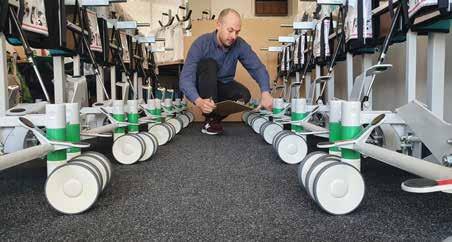
“As the smallest minnow in the pond,
be part of what will hopefully be a big change.”
“You know, you start your life as an engineer and [then] you’re in someone’s house and they’re telling you how much you’ve changed their life,” said O’Keefe.
“It’s a really amazing experience. It just shows you where you think you start in your career and where you end up.”
WORKPLACE HEALTH & SAFETY
Tente Australia tente.com.au
HT Systems founder Keith Alexander (L) and CTO Alex O’Keefe demonstrating the Kera sit2sit hoist
Alex O’Keefe with the Kera sit2sits, which use Tente castors
“The innovation of our device was that we made it relatively effortless for caregivers to lift a person out of their wheelchair.”
64 | Industry Update Issue 130 Feb/Mar 2023 industryupdate.com.au
“As the smallest minnow in the pond, it’s humbling to have access to the highest quality German-made product.”
material
StepBumper
The StepBumper offers unprecedented heavy-duty low-level protection that prevents injuries and damage in vehicle charging areas, goods holding areas and pedestrian walkways. The dangers in these areas of the workplace can lead to pedestrian injuries, damaged infrastructure and costly downtime.

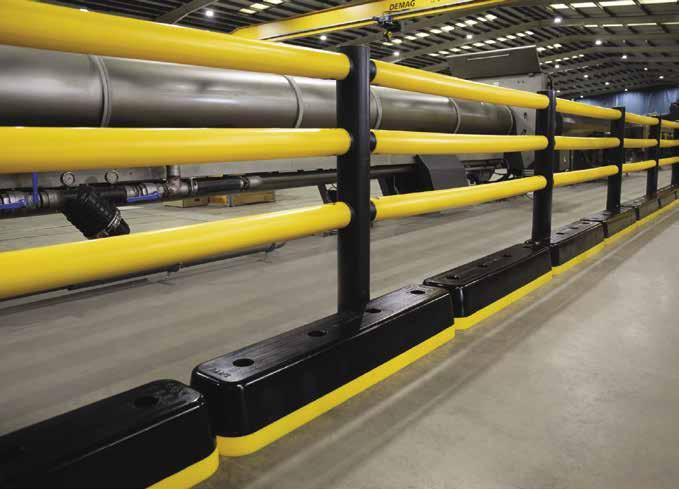
Tested to the global benchmark in barrier sa
fety
Code of Practice for Workplace Safety Barriers
Monoplex is a new material innovation that is revolutionising impact protection in industrial workplaces worldwide. Precision-engineered and produced in the UK using state-of-the-art materials and manufacturing technology. Monoplex safety products offer levels of versatility, durability, and performance across multiple impacts.
To schedule a free site survey or virtual consultation please contact: A-Safe Australasia PTY Ltd | www.asafe.com | 02 9625 8927
Forklifts no match for polymer safety barriers
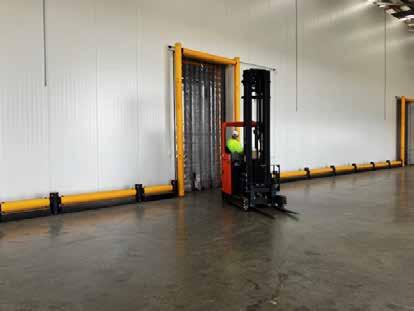 By Margie Smithurst
By Margie Smithurst
When frozen food and dry goods distributor Sydney Freezers moved to a new 10,000 square metre warehouse at Bankstown Airport in January 2022, they didn’t want to continue using the steel barriers they’d installed at their old site.
“We realised that the forklift was always winning against the metal,” said Ali Fardous, sales manager of the company, which was set up by his father Mohammed Fardous 12 years ago.

Fardous turned to the internet, where he found A-Safe’s polymer safety barrier products.
“I came across this plastic version from A-Safe, and I’ve done a bit of research on it, and I saw that it’s much better ...
“Because if a forklift does hit it, it actually pushes the forklift back. So it’s like an elastic kind of rebound.”
energy away from the impact point, with a strength and flexibility provided by the innermost layer.
“Yes, you can damage the plastic,” said Fardous, “but the outcome of the damage is less. Metal will damage more.”
Sydney Freezers needed the barriers to protect the walls and doorways of its gigantic internal freezer, a 2500 square metre space within its main warehouse, and one of the biggest freezers in NSW.
to clean and it looks good. I’ve had no issue with it since we’ve been here.”
Designed with an outer layer that is self-colouring, a cleaner wipes down the barriers once a month.
A-Safe’s distinctive yellow barriers and bollards use a unique three-layered advanced polymer material, invented and manufactured in the UK. The product differs from steel in that it absorbs any impact, dispersing the
“Basically it’s for forklifts coming in and out,” said warehouse manager Tareck Charara, pointing at the large entry and exits, “And we’ve got pallets coming up against this wall as well, so we don’t want the walls getting damaged.”
The barriers run along the base of the freezer’s walls, both inside and out, and up around the top of the doorways.
“We don’t want a forklift that’s got its mast up to hit the top of the [freezer wall] panelling, it’d rip the whole thing down basically.”
Inside the huge cool rooms, the company installed different, freezer grade A-Safe barriers.
Black with blue trimmings, they are temperature resistant to minus 30 degrees.
“Otherwise they start to crack,” said Charara, who oversaw the installation of the barriers by A-Safe technicians, who came out to the site.
The company also put A-Safe bollards at the ends of its outer warehouse shelving, to protect fire hydrants from being hit by moving vehicles.
“It’s a superior product,” said Charara of A-Safe’s polymer alternative to steel barriers.
“It’s sturdy and holds up well, it’s easy
They are also corrosion resistant.
“We’ve got pallets constantly hitting them every day as the guys unload the trucks,” said Charara.
“It’s very easy to maintain, very easy to get repaired as well.”
Because the whole system is modular, when there is damage, which on the day Industry Update visited could be seen at the base of one barrier around a doorway, only the dented section needs to be replaced, not the whole structure.

“We would just ring up A-Safe and they’d come and swap it over … Instead of changing the whole frame, it’s just one piece we’re changing,” said Ali Fardous.
Sydney Freezers used A-Safe’s temperature resistant barriers for the inside of its freezer warehouse
“I’d recommend it to everyone. All my friends in this industry, when they ask me about barriers, I tell them to go with A-Safe. Yeah, it was the best thing we ever did.”
A-Safe
asafe.com/en-au
WORKPLACE HEALTH & SAFETY
Sydney Freezers, Tareck Charara, warehouse manager and Ali Fardous (R), sales manager
Sydney Freezer uses A-Safe barriers to prevent damage from forklifts going in and out of its freezer doors
“Because if a forklift does hit it, it actually pushes the forklift back”
66 | Industry Update Issue 130 Feb/Mar 2023 industryupdate.com.au
“It’s a superior product ... It’s sturdy and holds up well, it’s easy to clean and it looks good.”
Laws make 2023 WHS Expo a must-visit
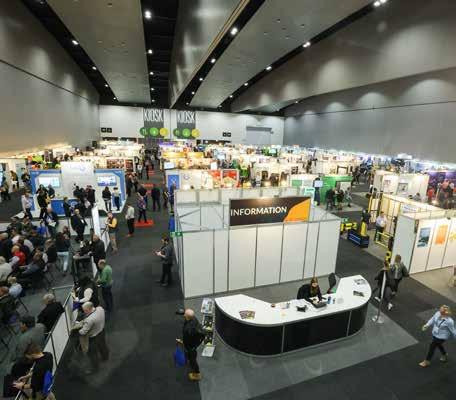
Late last year, the federal government filed the Work Health and Safety Amendment Bill, demonstrating its firm commitment to the prevention of injury and illness in the workplace.
The new Bill provides for the implementation of recommended amendments to national work health and safety laws. With the aim of keeping Occupational Health and Safety (OHS) managers abreast of the latest requirements and regulations, the Workplace Health and Safety Show will be taking place at the Brisbane Convention Centre from 31 May to 1 June 2023.
As one of the country’s largest business hubs, Brisbane is home to a number of key sectors from mining, oil & gas, construction and tourism – which all prioritise worker safety and wellbeing.
“The Workplace Health and Safety Show will bring them up to speed on everything from the latest in safety technology, health & wellbeing, height safety, materials handling, protective equipment, industrial cleaning & hygiene, as well as psychological safety in the workplace – all under one roof,” explains Sam Palermo, Exhibition Director.
Interactive platform
The Workplace Health and Safety Show presents current workplace health and safety research, information, technology and innovations.

“Over 100 safety organisations and industry experts will be exhibiting their solutions and services. Show attendees will also benefit from the exciting line-up of industry expert speakers who will share their expertise in the Knowledge Centre and Spotlight Stage,” adds Palermo.
“Entry to the exhibition and seminars is free, making it easy for OHS Managers to attend”.

Get involved
The IEC team has confirmed that limited exhibitor and speaker slots are still available, providing specialists and industry experts with an opportunity to engage with visitors and present their solutions.
“If the success of the 2022 Melbourne and Sydney events are an indication, this year’s Brisbane show is expected to be a strong event for the industry, and is set to become a popular event on the Brisbane calendar,” notes Palermo.


The Workplace Health and Safety
Show will also take place in Sydney, from 20 to 21 September. Further information is available on the Show website, www.whsshow.com.au or email: whssales@iecgroup.com.au
WORKPLACE HEALTH & SAFETY Limited exhibitor stands & speaking opportunities available. 31 May – 1 June 2023 - Brisbane Convention and Exhibition Centre 20 – 21 September 2023 - Sydney Showground, Sydney Olympic Park • Australasia’s only dedicated Workplace Health & Safety exhibition • Engage with over 2000 OHS professionals, across industry sectors over two days • Build networks and gather new leads at this well attended leading industry event 03 9596 9205 • W H SSA L ES @ IE C G R O U P C O M .A U • W H SS H O W C O M .A U Exhibit
industr y leaders Workplace Health & Safet y Show 2023 Book your spot now
with the
Industry Update Issue 130 Feb/Mar 2023 | 67 industryupdate.com.au
Workplace Health & Safety Show whsshow.com.au
WORKPLACE HEALTH & SAFETY
“Not a big deterrent”: apprentice’s mother calls for tougher laws
By Margie Smithurst
In April 2019, almost 18 tonnes of scaffolding collapsed on teenaged apprentice Christopher Cassaniti at a Macquarie Park building site in Sydney.
Directly under it, and trapped by the rubble and debris, Cassaniti survived for 20 minutes before he died. He had celebrated his 18th birthday just days before. Another worker, Khaled Wehbe, suffered serious injuries.
In July 2022, the company responsible for supplying, erecting and maintaining the scaffolding, Synergy Scaffolding Services pleaded guilty to a Category 1 offence under the NSW Work Health and Safety act.
In 2022, a Gympie businessman was the first person in Australia to be jailed under the laws. He was sentenced to 5 years’ jail (suspended after 18 months prison time) after being found guilty of industrial manslaughter when the overloaded forklift he was driving - unlicensed - tipped and crushed his friend, who’d been helping him out as a favour.
SafeWork NSW says workplace deaths can be prosecuted under the state’s Work Health and Safety Act, and in certain circumstances might be prosecuted under the Crimes Act.
Patrizia Cassaniti says Christopher’s death wasn’t considered a Crime Act case.
Cassaniti, who says she’s spoken to numerous
Prevent tragedy by learning at WHS Expo
by Marie Kinsella, CEO International Exhibition & Conference Group

In November 2022, a judge fined the company $2 million over the “catastrophic” collapse, after a reduction of 10 per cent for the guilty plea. The maximum penalty for the offence is $3 million.
The judge said the company knew the scaffolding was “grossly overloaded” and was aware of a history of unauthorised removal of building ties and alterations to the scaffolding.
It followed a $900,000 fine for the construction company Ganellen (GM Residential) in December 2020, reduced from $1.2 million after a guilty plea.
politicians on both sides of state parliament, says she can’t see why the state hasn’t yet adopted the stricter industrial manslaughter laws.
“I don’t understand why the people of NSW are valued less than any other state.
We have the most deaths in the workplace in NSWyes, we have more people in the state - and yet our laws are the weakest of them all.”
“I’ve always said I’ll never get justice through the judicial system for my son.”
A mother’s mission
Patrizia Cassaniti’s life is now filled with speaking engagements at workplaces, where she keeps Christopher’s memory alive by educating workers about site safety and new laws.
Touched By Christopher, the charity organisation she set up with her husband Robert, raises money for other NSW families who’ve lost someone to workplace accidents.

“Most of the time it’s the breadwinner who is killed, leaving behind families with mortgages and rent. Compensation doesn’t come through for a while - it can take eight months to three years. A lot of things can happen in between.”
“[The families] get 3 months worth of groceries, and outstanding bills to $1500.”
Ensuring the highest standards of worker safety in manufacturing seems like an obvious consideration — but sadly this is not always the case.
A recent study released by Safe Work Australia found that 23% of all workplace fatalities recorded in 2022 were caused by being hit by a moving or falling object and that 7% of fatalities recorded were the result of being trapped by moving machinery.
Both of these scenarios are realistic risks on the factory floor – with machinery operators and drivers contributing to the largest number of fatalities and third-highest number of injuries of all occupations monitored by the agency.
The long-running Workplace Health and Safety Show is making its debut in Brisbane in May this year, while the original WHS Show will take place in Sydney in September.
We are all too aware that many of these ‘worst-case scenarios’ are preventable and often the result of inadequate workplace safety guidelines and protocols.
These are some of the reasons I personally feel so motivated to expand the reach of this expo to new states and why I am excited to be showcasing in Queensland for the first time.
The fines have highlighted how low the penalties are for such offences in NSW compared with other states.
Patrizia Cassaniti, Christopher’s mother, doesn’t believe they’re enough of a deterrent.
“It’s what they [construction companies] spend in a day,” she told Industry Update
“If you kill someone in a car, it’s manslaughter, no questions asked. It’s ridiculous that when it comes to killing a worker, there is no jail time. It should act as a deterrent for others .. but when there are no consequences in place, and the laws are really weak, there’s no deterrent.”
NSW laws weaker
In NSW, unlike in most other states (except Tasmania and SA) there is no industrial manslaughter offence. Although an industrial manslaughter bill was introduced in 2021, it hasn’t yet passed state parliament.
In states and territories where the offence exists, it comes with steep fines and considerable jail time.
In Victoria, individuals can be jailed for up to 25 years, and organisations fined $16.5 million. In Qld and WA, it’s 20 years jail and $10 million in fines. The Northern Territory takes the offence so seriously individuals can go to jail for life.
Now in its third year, Cassaniti says she would like to see it go national and also include three months worth of mortgage or rent payments.
“The people who I’ve managed to get a hold of are very grateful. It’s a big chunk and a relief. In those first three months, it’s a black cloud you’re trying to come out of and you can’t, it’s too much.”
The Touched By Christopher foundation held its first gala fundraising dinner in March 2022, attended by more than 550 people, she says, something she is hoping to continue as an annual event.
“It’s still a work in progress. It’s about getting the awareness out there - getting our name out there.
“[Christopher] touched many people, he was very caring and he had time for everyone.
“This is what I’m doing for him to continue his legacy, and hopefully do good for other people and save lives in his honour.”
Following the WH&S Amendment Bill, there are now harsher penalties for those found guilty of negligence so OH&S managers need to get up to speed with the latest safety standards.
Luckily, the free Workplace Health and Safety (WHS) Show is designed as a ‘one-stop-shop’ for safety professionals to meet new suppliers, update knowledge, join discussions, and forge connections — to help develop best practice in their own workplaces.
The program includes live demonstrations, seminars and round-table discussion and the opportunity to meet with change-makers from across Australia.
Attendees will come face-to-face with cutting-edge and targeted work and safety solutions and stay updated on the latest products, resources and policies.
With all this on offer, safety professionals have nothing to lose and so much to gain by attending the WHS Show and keeping health and safety top of the agenda in 2023!
Workplace Health & Safety Show whsshow.com.au
Christopher Cassaniti with his parents Patrizia & Robert
Touched by Christopher touchedbychristopher.org.au
“It’s ridiculous that when it comes to killing a worker, there is no jail time.”
68 | Industry Update Issue 130 Feb/Mar 2023 industryupdate.com.au
“I don’t understand why the people of NSW are valued less than any other state.”
Support for women in electronics & engineering, but problems persist

Everyone is united in their views supporting women in the electronics/ engineering industry.
That’s one of the positive results from the second annual Global Women in Engineering survey published by electronics distributor element14.
The survey shows inequality needs to be addressed, revealing that women around the world remain under-represented in the industry and continue to experience various forms of sexism and discrimination.
Element14 and its online community of engineers launched the survey mid-2022 to shed light on women’s experiences in the engineering/electronics industry.
New questions covering discrimination, sexism and equality were added as these critical issues were noted as key areas in the 2021 survey analysis.
“The results of this year’s Global Women in Engineering survey were a strong indicator that the positive trends for achieving the equal treatment of all genders are continuing,” said Dianne Kibbey, Global Head of Community and Social Media for element14.
“Differences in opinion were expressed on the challenges women face in our industry, which could help employers to understand what is working well for women in the workplace and what could be improved.”
Key insights
Insights from the Global Women in Engineering Survey included:
• More than two thirds of respondents (70%) said they would intervene when seeing discrimination. However, the seniority of the person exhibiting discriminating behaviour was cited as the biggest obstacle to intervention. A small percentage said they would not intervene because discrimination or sexism is part of their company’s culture.
• Women expressed the belief that they were perceived to be less technically capable than men, but this view was
not supported by male respondents.
• Men cited that women “missing out on career development opportunities” was an issue.
• It is evident that sexism and discrimination are still occurring but the situation is improving. One quarter of survey respondents said they have never experienced sexism in the electronics/engineering industry.
advocates. More than three-quarters of women felt mentorship helped them in their careers.
Success stories
The survey uncovered many anecdotal success stories of women who are already achieving great things in the electronics/engineering, including:
• “I was in a role where I was the only female and a top performer, yet I was paid 20% lower than the lowest-paid male on the team.”
• Other discrimination challenges cited some women as obstructing other women in their career progression, although the barrier was not as great as that presented by men. Self-promotion by women was highlighted as a key issue in this year’s survey, both in reference to being discriminated against for not positively communicating their achievements versus the perception of being ‘aggressive’ when doing so.
• Genders think similarly about how to address work/life balance, however pay is one area where there is a significant difference in opinion. Only 12% of men compared to more than 40% of female respondents said they had seen pay differentials.
• All genders shared similar views about the enforcement of policies. However, there was a combined decrease in enthusiasm for inclusion and diversity initiatives from 40% in 2021 to about 25% in 2022.
• More than half the survey respondents said providing mentorship and development opportunities to women was important. Mentors are seen as key to ensuring recognition by being
• One woman cited the achievement of securing a 233% increase in new business from a client. She commented: “I took on Google as a customer when I was in Inside Sales. Through hard work, high-level collaboration and intense focus on value-added services … we grew their account from less than $30,000 to $1 million over several years. Visiting their campus and connecting with those engineers in person during this timeframe was one of the most rewarding experiences I’ve had.”
• Another woman commented: “Twentyseven years in engineering. I’m proud of that.”
There was an overwhelming response from all genders encouraging women to be more confident, trust in their abilities and take on the challenge of working in engineering.
Some of the top drivers leading women to enjoy a career in engineering included the ability to work on diverse projects (25%), opportunities for getting a preview of what’s coming next in technology and seeing that come to life (16%), and career development (10%). The option for women to have flexibility and work/life balance (21%) was much higher than in the 2021 results.
More to be done
The 2022 survey matched trends revealed in the 2021 survey — highlighting the positive steps forward — but there is more to be done to eliminate sexism and ensure fairness for all.
Some examples of sexism and discrimination shared in the survey included:
• “I was told by management before my first big conference to ensure I shop in the women’s department for clothing for the event and to ensure I dressed more feminine.”
• “I have been told to ‘dress sexy’ when pitching presentations for new business to executive directors.”
• “Being told by a mentor/professor on my course that being female I would not make it in engineering as I would have to be a lot better than the men.”
• “Director-level opportunities being passed directly to a male colleague without the role being advertised.”
Element14’s eight-week global survey was open to all genders working in the electronics/engineering industry and launched on International Women in Engineering Day (June 23). Most survey respondents (75%) were from Europe and North America, with further submissions received from Asia Pacific, Central and South America, China, Middle East and Africa.
element14
au.element14.com
“I have been told to ‘dress sexy’ when pitching presentations”
“I was … a top performer, yet was paid 20% lower than the lowest paid male”
WOMEN IN MANUFACTURING Industry Update Issue 130 Feb/Mar 2023 | 69 industryupdate.com.au
Women around the world remain under-represented in the electronics industry and still experience sexism and discrimination … yet there are some positive trends emerging.

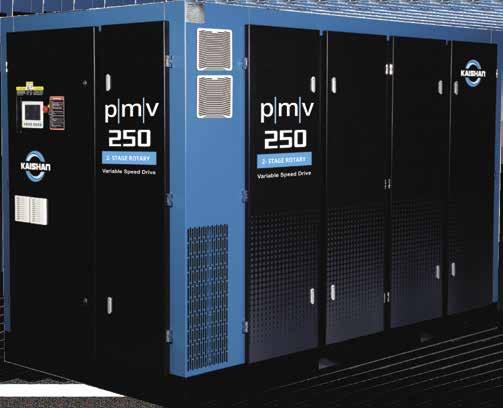












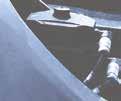
CSIRO sees into our solar future
It’s vital that Australia develop its own fully integrated domestic solar supply chain to maintain energy security and fulfil its potential as a superpower in solar PV energy generation and export. So says the Australian Silicon Action Plan, a plan commissioned by the CSIRO from PwC Australia, and which relies on collaboration by all stakeholders.
The Australian Silicon Action Plan has been welcomed by Industry and Science Minister Ed Husic who noted potential alignment between the CSIRO’s plan and government priorities for its National Reconstruction Fund.
The Plan spells out the actions Australia must take to support a fully local supply chain for silicon and its use in solar cells. Such a supply chain is critical to independent energy security and supports economic growth and jobs across Australia’s regions and cities.
“Energy independence should be a top priority for Australia,” said CSIRO Senior Principal Research Scientist Dr Chris Vernon.
“The Australian Silicon Action Plan suggests a pathway for the creation of an industry that has potential to provide employment and reskilling opportunities, the delivery of significant economic benefits that come from adding value to Australia’s mineral endowment, development of new industries in regional Australia with the world’s best
ESG standards — all while improving Australia’s energy security and independence.
But Dr Vernon warned that achieving CSIRO’s vision demanded a high level of collaboration between all stakeholders, from miners and refiners to state and federal governments, to R&D providers, to the manufacturing industry.
The plan finds that Australia’s reliance on overseas supply chains threatens what could be our leading role in global energy transition.
“Australia already has the highest per capita deployment of rooftop solar in the world, and there are several mega-projects in the solar development pipeline. But one of the greatest risks to Australia’s solar ambitions and energy future is our reliance on overseas supply chains for solar cell technology,” Dr Vernon said.
“The increasing pace of the energy transition and ever-increasing international demand for solar PV, combined with an ever-present focus on ESG issues, highlights the fragility of our current supply chains, and makes the pursuit of energy independence all the more important.”
The Australian Government has identified silicon as a critical mineral because of current risks to its supply chain and its importance to new economy technologies such as solar cells,

semiconductors (chips), optical fibres, aluminium alloys, and its potential use in energy storage batteries.
Silicon is abundant in Australia as quartz but the process of smelting quartz to silicon, then to high-purity silicon needs much work here. Increasing production of silicon in Australia is seen as the first step for Australia to develop its own capability and capacity in what should be an integrated silicon-to-solar cell supply chain.
Demand for solar power and current supply chain dynamics means Australia must grasp the opportunity now.
Between 2021 and 2050, solar PV’s contribution to the energy mix in Australia is expected to increase from 12% to approximately 50%. Estimates by the International Renewable Energy Agency show annual global solar power generation capacity must increase more than five-fold by 2030, and fourteen-fold by 2050 if the world is to stay on track for net-zero targets.
To keep pace with these solar capacity forecasts, annual global production of silicon and its purified form — polysilicon — will have to materially increase.
Despite our growing reliance on solar generation, supply chain dynamics risk Australia’s energy security. Geopolitical tensions, natural disasters, climate change, energy market issues and COVID-19 have highlighted the fragility
Nokia mobiles in the muster
Managed by the Australian Mobile Telecommunications Association (AMTA), MobileMuster is an industry-led, accredited electronic product stewardship scheme funded by members including handset manufacturers, network carriers and other electronic hardware manufacturers.
Andrew Cope, Managing Director, Nokia Australia and New Zealand, believes ‘circularity of products’ is a key focus for Nokia.
“We are always looking for ways we can enable the refurbishment and recycling of end-of-life products when removed from customers’ networks. We are delighted to
be part of MobileMuster’s expansion in Australia, making our job supporting our customers in their sustainability goals so much easier.”
Last July MobileMuster extended the range of products it collects and recycles to include three mobile telecommunications e-waste product streams: network connectivity, smart home technology, and wearables and peripherals. By expanding its scope, MobileMuster continues to demonstrate how industry can work together to address growing volumes of e-waste and deliver measurable social and environmental benefits.
“Product stewardship plays a
significant role in a circular economy, where end-of-life products are sustainably collected and recycled to close the loop on the materials we consume,” said Spyro Kalos, Head of MobileMuster.
“It is because of the support of manufacturers and distributors that MobileMuster has had longstanding success, and it is pleasing to see more brands come on board to fund the expanded program. We welcome and congratulate Nokia for its proactive contribution to sustainability.”
“We are delighted to welcome Nokia to MobileMuster as the program expands to capture a broader range of end-of-life mobile telecommunications devices,”
of our current supply chains.
Around 70% of silicon is produced in China, while China also dominates the production of polysilicon. The conversion of polysilicon to solar cells is even more concentrated, with China accounting for between 75% and 97% of these stages of production.
According to CSIRO’s plan, Australia can develop a fully integrated silicon-to-solar cell supply chain, from quartz mining through to manufacturing, end-of-life processes, and recycling to support and de-risk the overall solar supply chain. The plan outlines action across three horizons:
Horizon one: immediately, first steps to developing an integrated supply chain. These include identifying potential locations for new smelting facilities, integrating renewable power into smelting processes, and researching funding into next-generation processes and technologies.
Horizon two: actions to expand Australia’s supply chain activity, such as developing more complex supply chain steps of manufacturing components for solar cells
Horizon three: actions that will lead to an integrated, low-carbon and circular solar cell supply chain in Australia, such as supporting polysilicon production and focusing R&D efforts on developing and scaling emerging and future technologies.
The Government has identified $1 billion of the National Reconstruction Fund to help businesses add value to resources.
Minister for Industry and Science Ed Husic said the Australian Silicon Action Plan welcomed the plan.
“As I’ve said previously, if we mine it here, we should make it here,” said Minister Husic.
“The National Reconstruction Fund will help to support new industries and advanced manufacturing in Australia.”
The NRF will invest across seven priority areas of the economy, including value-add in resources. Investments in this priority area will help to expand Australia’s mining science technology, and ensure a greater share of raw materials extracted are processed domestically. Mobile
said Louise Hyland, CEO of AMTA. “While advances in connectivity can have a positive handprint in enabling sustainable outcomes across many industries, we must also acknowledge the corresponding footprint,” added Cope. “ MobileMuster is a tangible way the mobile telecommunications industry can mitigate this footprint and build a sustainable future.”
mobilemuster.com.au
Muster
ENERGY, WASTE & RECYCLING
72 | Industry Update Issue 130 Feb/Mar 2023 industryupdate.com.au
$65m to charge up dispatchable renewables
In a bid to boost renewable energy, energy security and to decarbonise hard-toabate sectors, the Albanese government and the Australian Renewable Energy Agency (ARENA) are investing $65 million in what they say will be a “ground-breaking” solar thermal project.

The grant is going to Vast Solar and its dispatchable solar thermal technology which could bolster power supplies nationwide, with long-duration and cost-effective energy storage.
The large 30MW / 288 MWh utility-scale plant north of Port Augusta in South Australia will create up to 450 regional jobs during construction and 70 ongoing operational roles in long-term manufacturing, plant operations and maintenance.

The project will use sunlight reflected off thousands of mirrors and transfer the concentrated heat via liquid sodium to molten storage tanks. The stored energy will then be used to generate electricity when needed.
This project could lead to larger installations helping to firm Australia’s grid, providing reliable and cheaper energy at scale, as well as creating opportunities to export the technology and generate more jobs.
The government sees the world’s climate emergency as Australia’s jobs opportunity. Minister for Climate Change and Energy Chris Bowen said Vast Solar’s home-grown concentrated solar power technology could be a game changer for Australia and the world.
“It’s great to see an Australian company developing breakthrough technology to create jobs and clean, reliable and affordable power in the regions,” Minister Bowen said.
“Making this technology commercially viable on a larger scale could go a long way to meeting the growing need for dispatchable renewable energy, energy security and longer duration storage.
“Vast Solar is globally recognised as a leader in this technology that will help support our goal of getting the nation’s electricity grid to 82% renewables by 2030.”
This investment follows $19.48 million to Vast Solar as part of the HyGate program to establish a green hydrogen supply chain through the AustraliaGermany Hydrogen Accord.
Vast Solar is considering a domestic pipeline of 200 MW of dual generation and storage facilities, opening opportunities to support heavy emitters’ decarbonisation and create more regional jobs.
Large-scale wind and solar farm investment commitments grew nearly 50 per cent in 2022, the majority of that increase after the May election.
The landmark Capacity Investment Scheme (CIS), agreed with States and Territories since Labor won government, will drive around $10 billion investment in clean, dispatchable, and reliable power.
The new energy under the CIS will be connected with the Government’s Rewiring the Nation plan, to modernise the electricity grid and meet the demands of the rapidly changing market.
Industry Update Issue 130 Feb/Mar 2023 | 73 industryupdate.com.au
Record year for renewables
Australian companies and households have rushed to invest in wind and solar energy to power homes, offices and factories last year, according to new data published by the Clean Energy Regulator in February.
Large-scale wind and solar farm investment commitments grew nearly 50% in 2022 with 4.3 gigawatts (GW) of large-scale renewable energy capacity achieving a final investment decision in the year. For context, 4.3 GW is enough to power over three million homes.
The second half of 2022 also saw a step up in rooftop solar investment by households and businesses, with over 300,000 small-scale rooftop solar systems installed in 2022, contributing an additional 2.8 GW of renewable energy capacity. This is 22% higher than the Regulator’s estimate of 2.3 GW from early 2022.
Minister for Climate Change and Energy Chris Bowen said the scale of investment in renewables is the result of a stable policy environment on climate and energy.
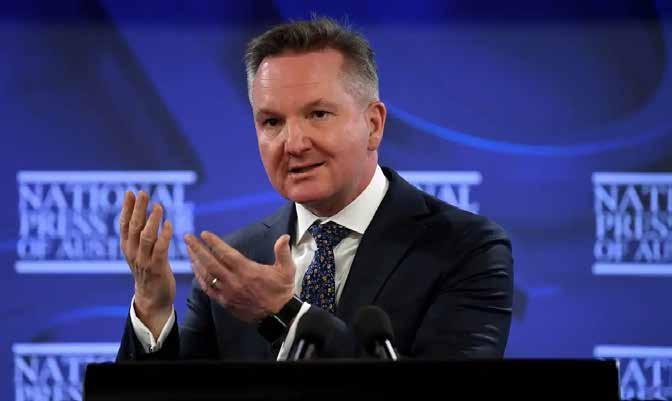
“This investment means new jobs across the country, and will support emissions reduction in the electricity sector and puts us on the way to 82% renewables by 2030,” he said.
Minister Bowen said most of this investment increase came after last year’s election, which proves renewable investors “know that Australia is back open for business in clean energy” and are responding to the government’s strong emissions reduction targets.
As well as clean and cheap, energy also needs to be reliable.
The government maintains that the previous LNP government’s lack of climate and energy policy saw 4GW of dispatchable power leave the grid, and only 1GW come on.
The landmark Capacity Investment
Aerator beats algae
Established a century ago, Craig Mostyn Group is now Western Australia’s largest vertically integrated pork, lamb and beef businesses which run alongside seafood production which includes three abalone farms and sites across Tasmania.
It’s now one of Australia’s most diversified food and agribusiness companies. When a core division, the protein-rendering unit at Talloman, had issues with a wastewater treatment pond, Plant Manager Carlos Mendes went looking for a solution.
The problem
Mendes wanted a reduction in biological oxygen demand, chemical oxygen demand, ammonia and also a solution to a troublesome blue/green algae issue. The EchoStorm venturi aerator from Gorman-Rupp was recommended to Mendes so he contacted Hydro Innovations, the Australian distributor for Gorman-Rupp.
EchoStorm is a static venturi aeration device that is installed on the discharge
side of a Gorman-Rupp self-priming centrifugal pump to introduce dissolved oxygen into liquid being pumped.
The simplicity of the system makes it easy to install, operate and maintain. With no moving parts, the EchoStorm is an extremely reliable device; only routine maintenance of the Gorman-Rupp pump is required.
The U4A60S-B is the most efficient 4” self-priming effluent pump on the market because of its multi-vane impeller and ‘straight-in’ suction design, which keeps power consumption of the system low. It is also capable of passing a 20.6mm solid, and operating on suction lifts up to 6.1 metres.

The pump draws water from the lagoon, pumps it through the EchoStorm unit, drawing in air, mixes it with the water and delivers it back to the lagoon. The unit ‘saturates’ the water with dissolved oxygen, “conditions” it, and breaks down organic matter. This ruptures vacuoles or minute cells and cavities within the blue/green algae and
Scheme (CIS), agreed with states and territories under Labor will drive around $10 billion investment in clean, dispatchable, and reliable power.
In addition, the Australian Renewable Energy Agency’s $176 million investment in eight large scale batteries will help ensure wind and solar generation
can be smoothed and stored for use when it is needed.
The latest investments in clean, cheap and reliable energy will be connected with the Government’s Rewiring the Nation plan, to modernise the electricity grid and meet changing demands.
sinks it ,which then deprives it of the sunlight required for growth.
The technology was new to Talloman so Hydro Innovations was confident enough to offer a money-back guarantee on the promised results.
The results
Mendes tracked the progress of the EchoStorm by measuring the total taxa.
When the unit was installed in March, total taxa measured 217,000. Carlos
stopped measuring when the last reading in May, measured 6,630 — a reduction of 97%. Mendes and the Talloman team are happy with the results.
EchoStorm aerators are available in sizes from two through to six inches. Hydro
hydroinnovations.com.au
ENERGY, WASTE & RECYCLING
Innovations
74 | Industry Update Issue 130 Feb/Mar 2023 industryupdate.com.au
Chris Bowen Photo: SBS
Bulk waste manager embraces recycling
After 20 years in bulk waste management, D&M Waste Management has moved into recycling with a nudge from a ban on exporting plastics and help from a government grant—and a new Genox plant.
The West Australian company has contracts with local government authorities throughout Perth and the state’s north-west for bulk verge waste collection including green waste, general waste and recyclables.
D&M’s move into plastics recycling was fast-tracked by the national export ban on waste HDPE plastics in 2021. The ban coincided with the launch of the federal government’s Recycling Modernisation Fund, through which D&M successfully accessed funding for a significant part of a Genox recycling plant.
“We were extremely grateful for the generous financial support we received from the Department of Water and Environmental Regulation, which allowed us to enter the recycling market quicker than we anticipated,” said General Manager Daniel Taylor.
The Genox brand has been distributed and supported exclusively by Applied Machinery since its entry into the Australian market. Today more than 300 companies in Australia have Genox equipment installed.

Taylor contacted Applied Machinery about the options for building a plant to handle pipe shredding. Once a proposal was received, Taylor and his team looked carefully into other companies’ experiences with the proposed Genox and Polystar.
“We contacted a couple of recycling businesses that were already operating this brand of equipment and the feedback was extremely favourable and gave us the reassurance to proceed with the purchase,” Taylor said.
The recycling plant D&M chose consists of a number of standard Genox modular components including a shredder that is specially designed for

plastic pipes. The J-Series pipe shredder features a multi-rotor design with longlife counter knives that are ideal for shredding different diameter and sized pipes.
After the pipes are shredded and granulated, they go through a sink float tank and then a friction washer, centrifugal dryer and finally into a hopper for melting. The molten plastic is then re-pelletised to produce clean dry pellets.
The waste plastics are sourced from a number of areas including decommissioned HDPE pipes from old bore fields; pipe that was not suitable for re-use along with old bin lids and various plastic offcuts from local industry.
In something of an alignment of the planets and a classic case of vertical integration, the move into recycling coincided with an opportunity to partner with sister company Hydra Storm. The company had recently installed a new plastic pipe extrusion line producing a range of HDPE corrugated pipe for stormwater drainage applications.
The clean, dry recycled HDPE resin that the Polystar plant produces was ideal for feeding into the Hydra Storm pipe extrusion line, with any excess resin being offered to the market at a discounted rate, compared to imported, virgin HDPE resin.
The plant was up and running from 10th August this year; the throughput has gradually increased since that time and the plant is now matching the capacity of the extrusion plant – the ideal scenario.
“With both companies operating from the same facility this entire set-up would have to be one of the best examples of true circular economy processing,” Taylor said.

Taylor’s experience with Applied Machinery was certainly positive.
“The whole process from quotation through to delivery was pretty much seamless. Whilst we handled installation ourselves, we called upon Applied’s after-sales service for help in resolving a
couple of minor issues and we found the service excellent.

“Having local support that we can call upon quickly is very important to us and a key component of our decision to partner with Applied.”
With its successful move into recycling, the future looks bright for D&M. The company has a number of initiatives
in the wings which will no doubt see them establish their place as a key player in the recycling industry.
AMS have been suppliers of instrumentation and calibration equipment to all industries since 1973 representing some of the world’s












ENERGY, WASTE & RECYCLING F l ow M e a suremen t Spec iali st s ww w .am s- ic. c om.a u s ale s @am s- i c . c om.a u IN S T RU M E NT A TI O N & CALIBRATION PTY LTD SP E CI AL IST S
ww w. a ms -i c.com.a u
Applied Machinery appliedmachinery.com.au Industry Update Issue 130 Feb/Mar 2023 | 75 industryupdate.com.au
Genox J-Series Pipe Shredder
DMF’s rapid roll doors
insulated Coldsaver panels and optional column heating to ensure ice doesn’t cause obstructions.
DMF’s Servo control system with encoder positioning means the door can be easily set and programmed.
These doors operate at opening speeds of up to 1.5m/sec and close after an adjustable programmed time, ensuring the environment is well protected against temperature loss, dust, vermin and draft.


With many choices of door blade colour, and a full width interchangeable clear window, DMF can match most corporate or building colours to ensure an aesthetic finish.
The doors come well equipped with safety sensors as standard, and many forms of activation are available to customise the doors to suit the applications, traffic types and flow.
DMF International has been manufacturing and supplying high-speed rapid roll doors for over 30 years throughout Australia, NZ and SE Asia.
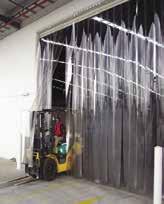
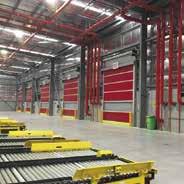
The popular Series RL3000 model is fully manufactured in Sydney, and is custom made to the required doorway sizes in the company’s well equipped factory.
Designed to suit spaces up to 6mH x
6mW, the RL3000 Rapid Roll Door can accommodate a range of applications including warehouses and logistics, food production and processing, pharmaceutical and hospital applications, docks, carparks, production facilities, car washes and mine sites.
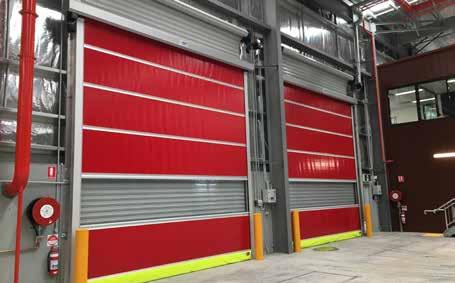

For chiller and freezer applications, DMF also can supply 15mm thick flexible
Some key points to consider when choosing a rapid roll door:

• What are the sizes of the doorways and what is the structural mounting provision? This consideration includes other door types that may be already mounted to the opening, such as roller shutter doors etc.
• What is the type and frequency of the traffic flow using the doorway? This will

DOORS DOORS DOORS
determine the best forms of activation to efficiently operate the rapid door.
• What is the purpose of the high speed door? Is it to control temperature, dust, vermin, draft, security etc?
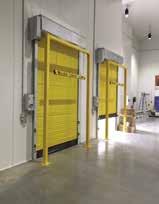
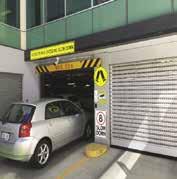
• What are the environmental conditions such as wind, rain, temperature, dust etc?

• What is the required level of safety required? While the doors come with multiple safety sensors as standard, there is also an array of optional extras to further enhance the safety performance of the door to protect users and the door from impact.
DMF can assist with an assessment of the application to determine the best high speed door solution from our extensive range. They have many years of experience and can tailor make a solution, so contact DMF today to see how they can design a solution for your busy doorways.
DOORS
www.dmf.com.au pvc strip doors swingflex doors tra c doors impact doors hygienic doors hospital doors cleanroom doors high speed doors efaflex doors coldsaver doors insulated doors security doors carpark doors foldup doors mining doors hangar doors sales@dmf.com.au Aust wide 1800 281170
DMF International Pty Ltd is a fully Australian owned family business, with over 55 years experience in supplying specialty doors. Our focus is climate control and high speed security door solutions, and flexible PVC door products. With Australia wide service and export to over 10 countries, our experienced approach ensures the best design solution for any application. Call us today for free design assistance . . .
DMF dmf.com.au 76 | Industry Update Issue 130 Feb/Mar 2023 industryupdate.com.au
A lifetime’s experience in doors
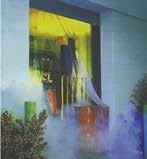

Australian Trellis Door Company has built its reputation in its 40 years’ supplying quality folding and sliding door systems to Australian and international markets.

In recent times its R&D team has successfully developed a comprehensive range of premium, commercial roller shutters which it supplies into Melbourne, Brisbane, Sydney, Adelaide, Perth and Canberra.
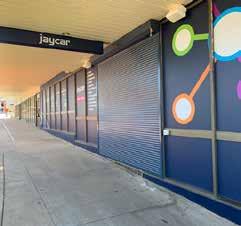
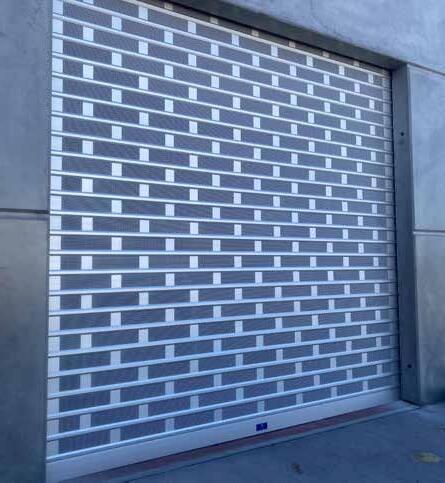

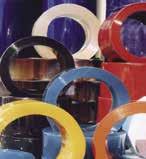
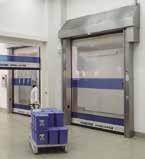
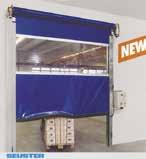
The range includes ‘widespan’ systems for wide apertures, often with heavy-duty electric motors which effortlessly drive these shutters for easy operation and include optional security features such as key-switch operation. Infills options include transparent or solid curtains or even grille link infills and finishes which can be in natural anodised or powder-coated.
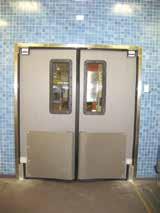

The Australian Trellis Door Co. trellisdoors.com.au
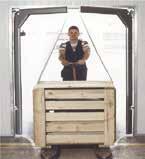
DOORS
Industry Update Issue 130 Feb/Mar 2023 | 77 industryupdate.com.au
“40 years’ supplying quality folding and sliding door systems to Australian and international markets.”
The biggest issue complicating design efforts
by Dave
At global electronics distributor
Digi-Key, we’ve shipped more units over the last two years than any other period in our history. Anybody that’s been in this industry is aware of its cyclical nature consisting of peaks and valleys. However, we are also aware of its legacy for engineers to innovate continuously throughout these cycles.
Last year, joined by one of our key partners, Molex, we conducted a survey aimed at design engineers regarding the challenges that they’re facing. Here are some of the outcomes:
State of the supply chain
According to the survey results, and to no one’s surprise, the number one issue complicating design efforts for engineers is the lack of availability of product due to heightened demand and disrupted supply chains.
production efforts.
Supply chains are complex networks that aren’t always easy to keep up to date on. The disruptions have come from many sources: availability of raw materials and metals, factory shutdowns, logistics bottlenecks and more.
Suppliers and distributors have tried to react by providing additional insight, however, planning has still been difficult, without being able to have total confidence in confirmation dates. Proactive engineers are building as much flexibility into their designs as possible, ensuring that alternate sources are listed on the approved vendor lists.
Websites like Digi-Key’s show cross references, alternate packaging, similar parts and the ability to show reverse product look ups where you can deselect the less critical parameters of your exact part to look for parts that meet your most
information to suppliers for their capacity planning and to better anticipate gaps that may occur in the mismatch of supply and demand.
Customer experience
Customers in Australia and around the globe have let us know they want their products faster, smaller and cheaper. We don’t anticipate those expectations changing in the near future, and we believe Moore’s Law is still alive and well and will continue to deliver on those needs.
The survey found that roughly 65% of engineers said improved design tools are leading to or simplifying their design efforts. The big advancement in this area has been the information sharing between suppliers and distributors and trying to make all the information more ubiquitous.
We understand that if customers are looking for a breadth of products earlier in their search, they tend to start at a distributor. When they want the deepest, richest information, there’s no reservoir like the manufacturer’s. Rather than store much of the supplier information on our website, we provide links back to the supplier directly so you can be assured that you are accessing the latest revision of a datasheet or application note. Additional types of information include 2D or 3D part images, and schematic symbols and footprints. We connect this information directly to various EDA platforms to allow you to continue your design efforts without having to bounce from site to site.
We have rearchitected our search experience as the number of parts we offer has gone from a few hundred thousand to a couple million. We’re incorporating a ‘fuzzy search’ logic and will be introducing a better experience searching for both content and specific part numbers.
customer forecasts. We’re incorporating machine learning to be able to forecast on a part number basis across our wide range of supported products which is much more efficient than past means for trying to predict trends and changing patterns of usage. We are already seeing better forecasting for newly introduced products that incorporate information and patterns from the previous family of products these newly introduced devices are replacing.
In many cases, our customers want a frictionless digital experience; the ability to self-serve 24/7. By continually investing in new tools, we can increase our speed, accuracy and responsiveness by incorporating API calls, which pull the most accurate information in real time, at the time of inquiry. Our strategy is to roll these enhancements out slowly and methodically, so the site maintains its familiarity to the user while continuing to improve the customer experience.
We understand our role to be a bridge between the new technology constantly being introduced by the 2,300 manufacturers we support and the 857,000-plus customers that look to introduce the most competitive and innovative products around the globe.
Beyond 2023
Looking ahead, engineers will continue to need to look for flexibility at the front end of their projects, have alternatives in mind and leverage distributor and supplier partners. We’re here to fuel your innovation and we’re listening to the feedback provided to us by our customers.
We’re in this together, through challenges and opportunities, as you continue to build the machines and devices that propel industries like healthcare, automotive, energy, 5G and IoT into the future.
Consistent with those challenges, it was reported that the top desired skillset was an increased awareness of the supply chain earlier in the design cycle to facilitate the downstream purchasing and
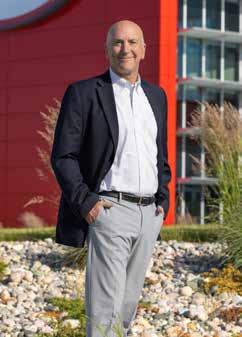


critical parameters.
The final piece to this puzzle from our customers is providing as much visibility into your long-term forecast as possible. We then convey this aggregated
Lastly, we are continuing to invest and enhance our forecasting engine. Except in very unusual times (like the present), most of our forecasting comes from past usage vs. future looking
OPINION
Product Distribution Center expansion (PDCe)
Orders prepared for shipment
Doherty, President, Digi-Key
Digi-Key Electronics digikey.com.au 78 | Industry Update Issue 130 Feb/Mar 2023 industryupdate.com.au
Dave Doherty, President, Digi-Key
Thousands of new cable products now here
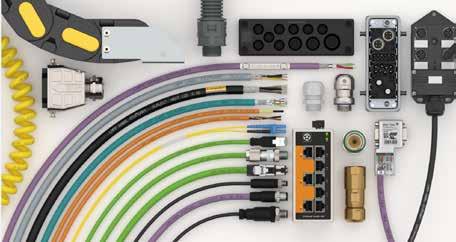


Having surpassed its five-year milestone in Australia, cable and connector manufacturer and distributor LAPP Australia has published its latest catalogue of locally stocked products and expanded supplier partnerships.
LAPP Australia is part of the LAPP Group, a leading global manufacturer of quality German-manufactured cables, connectors and industrial connectivity solutions for a broad range of industrial applications.
Since setting up its Australian subsidiary in 2018, Managing Director Simon Pullinger has built locally stocked lines from 1,500 to 5,000 cables and associated cable accessories — now in the latest annual catalogue. In addition, another 25,000 product lines can be delivered from Germany within two weeks.
“At a time when everyone’s feeling the pinch of supply chain challenges, we’re delighted to be expanding local supply and shortening waiting times to help keep industry moving,” said Pullinger.
“We’ll keep adding more locally stocked items to serve Australian businesses.”
Supplier partnerships


LAPP Australia has formed strategic partnerships to supply products and







services; these include:




• Tosibox® – secure remote access solutions, including the new 200 series to provide a secure endpoint for any type of operational infrastructure
• WAGO – the leading specialist in spring clamp termination technology for interconnection and automation solutions, including new terminal blocks, electronic circuit breakers, and power supplies.
• PCE – CEE form plugs and sockets, including caravan plugs and the ‘midnight black events’ series
• CIMCO® – specialised industrial tools, including large ranges of top quality pliers, cutting tools, crimping tools, shears, tool cases, screw punches and more. “Strategic partnerships with quality suppliers help us deliver complete solutions to customers across Australia, from industrial tools through to cybersecurity solutions – all with fast delivery options nation-wide,” said Pullinger.
New products

The catalogue includes new products designed to meet demanding needs and harsh environments across Australia. These include:
SMC’s ITV vacuum regulators –simple, smart application control
SMC Corporation continues to develop products that meet rising expectations for energy savings, space savings and efficiency.
Answering to the demands of most major sectors, SMC Corporation’s ITV series of electro-pneumatic and electronic vacuum regulators is one such example. These innovative stepless control regulators employ an electric signal to control air/vacuum pressure. The ITV series is ideal for use in a wide range of applications, from food processing and manufacturing to welding.
The regulators feature an IP65-rated enclosure, built-in one-touch fittings, as well as an easy-to-read, integrated LED display. They are compatible with analogue, digital, pre-set inputs, CC-Link, DeviceNet and PROFIBUS DP/RS-232C. The regulators offer high-speed response and great stability, with a sensitivity of 0.2% (full span) or less. Featuring two types of cable connections and brackets, and available in various port sizes and pressure settings, they are easily installed. In addition, it comes equipped with IO-Link technologies, which enables the user to monitor device status and perform pressure control easily.
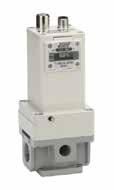
Recognises the importance of energy savings, SMC Corporation has designed the ITV series to deliver energy consumption of 4W or less. SMC Corporation’s local team has noticed a sharp uptick in demand for these regulators, which effectively and accurately maintain output flow in compressed air systems. Their low maintenance requirements and reliable performance enable improved productivity.
• ÖLFLEX® cable range expansions, including EMC cables, halogen free cables, drag chain cables, and the new Solar XLR-E cable approved to the latest solar standards EN50618 and IEC62930

• UNITRONIC® cable range expansions, including flame-retardant data cables with UV-resistant sheath and highly flexible BUS cables with PUR outer sheath for drag chain applications.


• HITRONIC® optical transmission systems expansions, including armoured universal fibre cables with non-metallic strain relief, and SBX industrial spliced boxes.
• SILVYN® protective cable conduit

systems expansions, including liquid-tight conduits with thick PVC jacket and parallel corrugated divisible conduits.
“All LAPP’s products undergo rigorous testing to comply with European, US, UK, and global standards, as well as any applicable Australian standards, so quality and reliability is built into every range,” says Pullinger. LAPP
With a simplified high-density circuit-board design, the ITV series comes in a compact form at just 15mm wide and weigh in at a mere 100 grams.
PRODUCTS
Australia
SMC smcanz.com
lappaustralia.com.au
Industry Update Issue 130 Feb/Mar 2023 | 79 industryupdate.com.au
Low-cost automation from idea to integration
Represented in Australia by Treotham Automation, German motion plastics specialist igus is working with manufacturers and integrators to expand its service and range of cost-effective automation.
Igus’s low-cost automation (LCA) reduces the barriers to adopting automation, offering special assistance to small and medium-sized enterprises (SMEs) in increasing competitiveness. Igus has built a broad network of 55 robotics providers and 40 integrators over the past three years, with more partners constantly being added.
Continuous development and innovation are making robotics increasingly affordable for SMEs, with a growing number of options on the market. Igus’s LCA portfolio includes articulated arm, linear, delta and SCARA robots. Product modularity means single components or complete solutions can be assembled according to the ‘build-or-buy’ principle. With a focus on a low entry-level price and quick payback, igus’s high-performance plastics offer advantages. They are tribologically optimised, durable, lightweight, lubrication- and maintenance-free, and cost-effective to produce.
Igus has built a broad partner network over the past three years. Under its growing LCA partner program, it works with integrators who offer additional expertise, experience with end-customer projects, and joint-project experience.
“We started with seven partners around two years ago, and we now have almost 100,” says Alexander Mühlens, Head of the Low-Cost Automation at igus. “In order to refer interested parties to competent integration partners in their area, we are constantly expanding our network.
“Together, we can offer customers a wide range of automation solutions – focusing on applications with a total
Turck now offering spring arms and measuring wheels
investment volume of less than €45,000 ($70,000). We work with customers to select the ideal integrator for the application to find the best and most cost-effective solution.”
Typical services include integrating control systems into existing machines; setting up and commissioning robots; evaluating safety measures; or if there is simply no capacity, providing the capability of assembling machines on site.
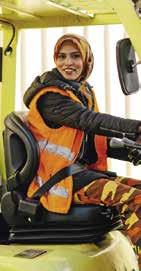
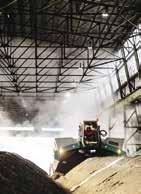
At its headquarters in Cologne, igus has set up a testing area where customers can see LCA live. Many of its integrator partners have also done so. With its LCA roadshow, igus also works with integrator partners to organise events or visit customers directly.
“Nothing is more convincing than being able to experience robot programming or gripper adaptations yourself on site in just 30 minutes,” says Mühlens. “That’s why we have over 30 customer visits a week in Cologne alone.”
Since 2019, users have also had access to igus’s RBTX online marketplace, which brings together users and manufacturers of low-cost robotics. Partners benefit from a new digital sales channel and can expand their customer base and open new markets.

“At RBTX.com, interested parties can find compatible components from a total of 78 partners,” says Mühlens. “
The marketplace has 100 low-cost applications, with parts lists and hardware and software compatibility for price transparency. We are always interested in new partners, so we can ultimately provide interested parties with even more individual solutions for their application.”
Treotham treotham.com.au
Turck has added spring arms and measuring wheels to its encoder portfolio, thus offering another reliable solution for measuring linear moving objects.

The freely combinable spring arms and measuring wheels enable length and speed measurement using conventional encoders, making it possible to monitor the progress or speed of conveyor belts easily.
The three spring arms all address different requirement profiles – from price sensitive/space saving to low maintenance/flexible spring arms, right through to particularly robust spring arms providing high contact pressure.
All spring arm variants were developed for incremental and absolute solid shaft encoders, and are combined with measuring wheels with circumferences from 200 mm to 500 mm.
Different coatings ensure optimum
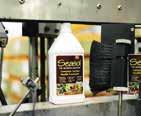
contact stability on metal, glass, textiles or wood. Users can thus put together the ideal system of encoder, spring arm and measuring wheel for their specific application.
The space saving, small RA-SAB-5-20 and -24 spring arms are designed for measurement in small spaces with quietly running machines.
The easy-to-install and compact 15-36 model has an exceptionally wide pretension range and a wide choice of measuring wheels.
Applications that require more contact pressure can use the large 30-36 spring arm.
Turck turck.com.au

PRODUCTS
APPLY TO USE THE LOGO ARE
CERTIFIED AUSSIE?
YOUR PRODUCTS
80 | Industry Update Issue 130 Feb/Mar 2023 industryupdate.com.au
Pressure sensors and transmitters for water treatment industry
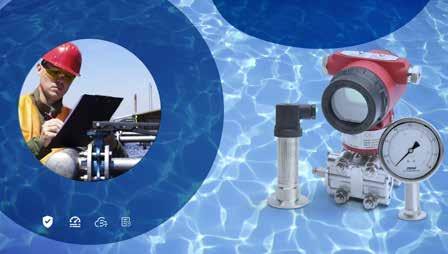

Water treatment plants generally consist of sewage treatment systems, drinking water treatment systems and a constantly pressurised water supply system.
Pressure sensors, transmitters and other instruments are key to making sure these systems run efficiently and safely.
Nowadays, all water treatment plants use multilevel distributed computer measurement and control systems to manage operations.
Automatic control systems (or IoT control systems) normally consist of industrial computers, programmable controllers and automatically controlled instruments.
Data is continually measured and balanced in these systems using instruments based on pre-set values. This is to ensure the optimal performance of machines and equipment.
There are two different types of instruments used in water treatment plants to ensure the safety and efficiency of the operations process.
One type is used for measuring physical data of related elements such as temperature, pressure, liquid level, flow, etc.
Cool and wash with hollow cone nozzles
EXAIR’s new 3/8 NPT HollowStream liquid atomising spray nozzle provides a hollow cone spray pattern for pressurised liquids. Available from Compressed Air Australia, these nozzles are ideal for industrial cooling, cleaning, foam breaking, rinsing and dust suppression.
The tangential flow design is vaneless with wide open internal features to resist clogging so they work well with liquids containing particulate. Their right-angle design is compact and can fit in small areas.
These liquid nozzles produce a uniform distribution of liquid in a ring pattern with medium to large droplets and run at liquid operating pressure up to 17.2 BAR (250 PSI).
With HollowStream nozzles, the liquid is supplied into the body of the nozzle creating a swirling action within a vortex chamber. This vortex produces
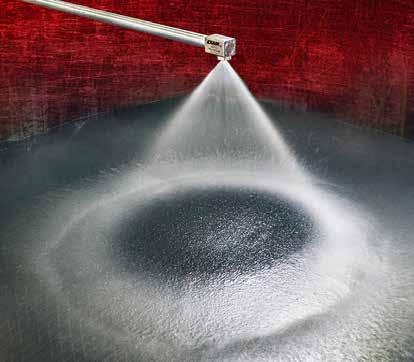
the hollow-cone spray pattern when the precision nozzle breaks the liquid surface tension as it exits the orifice into a controlled spray angle.
The stainless steel construction of HollowStream Cone liquid atomising nozzles adds to their durability and resistance to corrosion.
These HollowStream nozzles are CE-compliant and available in a variety of flow rates. They complement EXAIR’s large line of other 1/8”, 1/4”, 3/8” and 1/2” Atomising Spray Nozzles, which are also available in a variety of liquid patterns and flow rates.
Compressed Air Australia caasafety.com.au
These instruments are mainly sensors and transmitters.
Pressure sensors are commonly used on the top or side of tanks. Changing air pressure in the tank indicates more water has been added. The sensors are also used to gauge the pressure from pipes where water is flowing.
The other type of instrument is used to test, analyse and control water quality.
Reliability and accuracy of the pressure sensors and transmitters is very important, and choosing the most suitable brand and products can be a challenge for decision makers.
ZHYQ products adopt high quality materials and advanced technologies.
The company’s pressure sensors and transmitters are well known as being reliable, and ZHYQ can help managers and decision makers improve productivity with high standard quality products.
ZHYQ zhyqsensor.com.au
PRODUCTS
Industry Update Issue 130 Feb/Mar 2023 | 81 industryupdate.com.au
AMW returns home to Melbourne
Registrations are now open for Australian Manufacturing Week (AMW2023), to be held from 9-12 May 2023 when it returns to the Melbourne Convention and Exhibition Centre (MCEC).
Back on home ground, the 2023 show is slated to be a bigger event than the successful AMW2022 show in Sydney which hosted 6,100 trade visitors and 170-plus exhibitors in 4,500 square metres of
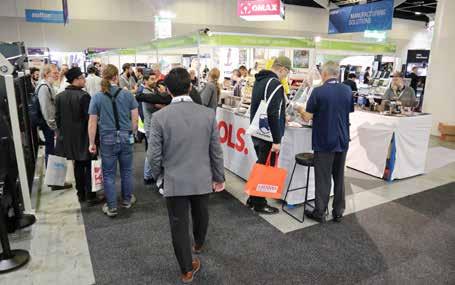
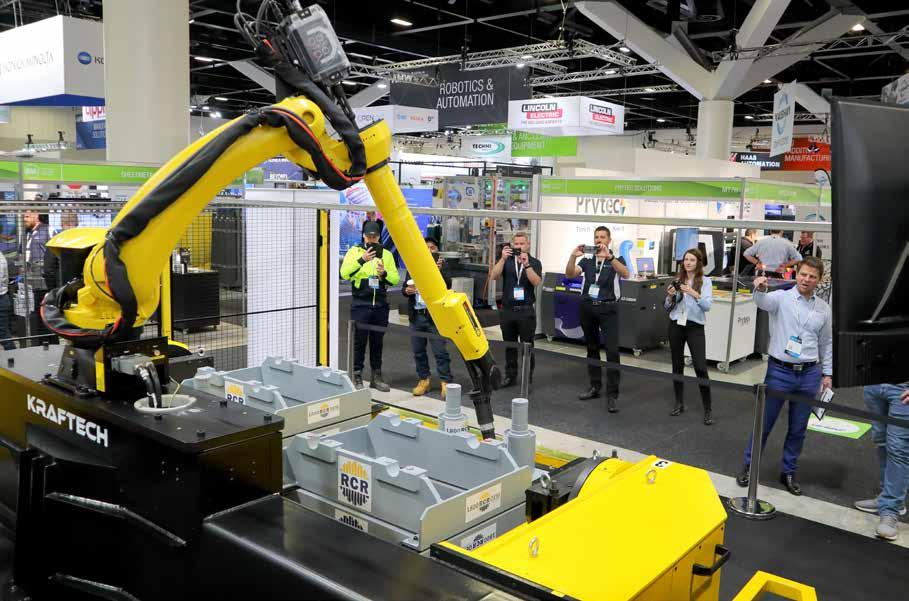
exhibition space over four days. Organised by the Australian Manufacturing Technology Institute Limited (AMTIL), AMW2023 will offer more than 10,000 square metres of exhibition space at the MCEC, with 300 leading industry exhibitors taking stands to show off the latest manufacturing technologies, processes, and support services to an expected crowd of more than 10,000 visitors.
“AMW2022 at ICC Sydney was a great success and we look forward to an even better AMW2023 at the Melbourne Convention Centre in May,” said Frank Yao of Innofocus Photonics Technology. There will be seven ‘zones’ on the show floor at Australian Manufacturing Week, each with their own distinct specialisations. These include:
• Austech Machine Tools, sponsored by ISCAR
• Additive Manufacturing Zone
• Australian Manufacturers Zone, sponsored by Sutton Tools
• Manufacturing Solutions Zone, sponsored by Adobe
• Robotics & Automation Zone
• Weld and Air Solutions Zone, sponsored by AtlasCopco
• Plastic Technology Zone
AMW is the one event that showcases the latest innovations, technologies, and equipment in the advanced manufacturing sector. Visitors and exhibitors can explore new opportunities, and meet and network with industry leaders and
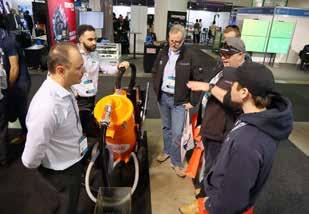
technology experts, all under one roof. Convenor, AMTIL, believes AMW2023 is set to be the biggest manufacturing show in the Southern Hemisphere. Electronex, the electronics design and assembly show, will run at the same venue alongside AMW2023 from 10-11 May. Don’t miss out: register online now at australianmanufacturingweek.com.au
Australian Manufacturing Week australianmanufacturingweek.com.au
EVENTS 82 | Industry Update Issue 130 Feb/Mar 2023 industryupdate.com.au



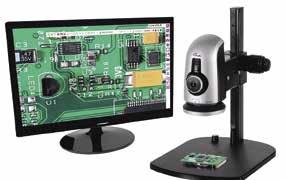



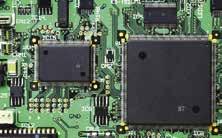
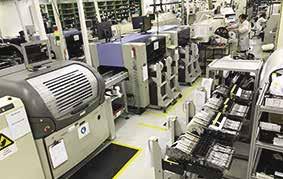
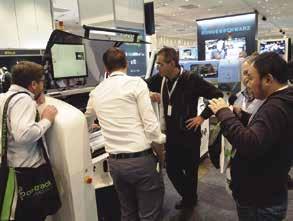
Electronex and AMW together in May
Electronex, the Electronics Design and Assembly Expo, returns to the Melbourne Convention and Exhibition Centre this year from 10 -11 May.
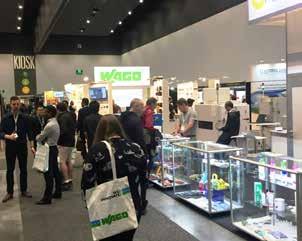
First held in 2010 and alternating between Melbourne and Sydney, Electronex is Australia’s major exhibition for companies using electronics in design, assembly, manufacture and services in Australia.
Technical workshops from international and local experts will be held in the SMCBA Electronics Design and Manufacture Conference.
The Expo is headed for a sell-out because trade visitors will be able to visit both Electronex and Australian Manufacturing Week as the events are being held at the same venue. Running the events together ensures a broad spectrum of latest products, technology and
Upcoming events
2023 AIP Australasian Packaging Conference
March 28-29
Crown Promenade, Melbourne
A two-day educational program on how industries are approaching 2025 National Packaging Targets and beyond. Topics include refusal, reduction, reuse, recycling and circularity, and how to design out waste. aipack.com.au/events
ELECTRONEX
10-11 May
Melbourne Convention and Exhibition Centre
In 2023 this electronics expo and conference returns to Melbourne to be staged alongside Australian Manufacturing Week with visitors now able to see the entire spectrum of manufacturing solutions at the one venue. electronex.com.au
Australian Manufacturing Week (AMW)
9 - 12 May
Melbourne Convention and Exhibition Centre
AMW showcases the latest in advanced manufacturing. Explore new opportunities, meet and network with industry leaders and technology experts, all under one roof.
australianmanufacturingweek.com.au
Workplace Health & Safety Show
31 May - 1 June
Brisbane Convention & Exhibition Centre
Discover interactive, innovative and collaborative solutions at free, two-day events in Brisbane (2023), Sydney (2023). Exhibitors show the latest health and safety products and resources and there are also Knowledge Centre seminars. whsshow.com.au
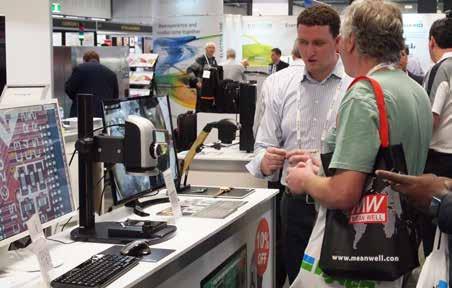
Energy Next 18-19 July

International Convention Centre, Darling Harbour, Sydney
Energy Next is a free industry exhibition on the latest renewable energy and energy management technologies. It includes technical sessions plus the Clean Energy Council’s Solar Masterclass.
energynext.com.au
Foodpro
23 - 26 July
Melbourne Convention and Exhibition Centre
Foodpro’s 12 zones focus on steps in the food manufacturing process: ingredients, food science and technology, processing and plant equipment, packaging and the latest in tracing and provenance.
foodproexh.com
turnkey solutions for the electronics and manufacturing sectors will be showcased.
More than 100 local and international exhibitors will feature a wide of range of electronic components, surface mount and inspection equipment, test and measurement and other ancillary products and services. Many will launch and demonstrate new products and technologies.
Companies can discuss their specific requirements with contract manufacturers that can design and produce turnkey solutions.
Electronex is the ideal event for designers, engineers, managers, and other decision makers who are involved in designing or manufacturing products that include electronics. Register free at electronex.com.au
CeMAT Australia 2023
25-27 July
The Dome Sydney
CeMAT is the opportunity to experience a range of solutions and technology setting the standards and future direction of logistics and warehousing in the Asia Pacific cemat.com.au
Workplace Health and Safety Show
20 - 21 September
Sydney Showground
Sydney Olympic Park
Discover interactive, innovative and collaborative solutions at free, two-day events in Brisbane (2023), Sydney (2023). Exhibitors show the latest health and safety products and resources and there are also Knowledge Centre seminars. Registration is free. whsshow.com.au
Modern Manufacturing Expo
20 - 21 September
Sydney Showground
Sydney Olympic Park
The Modern Manufacturing Expo showcases leading-edge products, equipment, technologies and software to help Australian manufacturers. This year’s theme is ‘Connected, automated and digital transformation’.
modernmanufacturingexpo.com
Thinkfood LIVE
25-26 October
Carriageworks Sydney
Thinkfood LIVE focuses on the pre-manufacturing stage of food and beverage production and the new product development cycle.
thinkfood.com.au
Shaping Change at the 23rd World Congress on Safety and Health at Work
27 - 30 November
International Convention Centre Darling Harbour, Sydney
The triennial World Congress on Safety and Health at Work is an opportunity to connect with global leaders in safety and harm prevention from more than 120 countries. Hosted by SafeWork NSW, the International Labour Organization (ILO), and the The International Social Security Association.
safety2023sydney.com
EVENTS
84 | Industry Update Issue 130 Feb/Mar 2023 industryupdate.com.au
Electronex electronex.com.au
Flow meter for green fuel cell energy
Sophisticated fuel cell technology projects now rely on the precision of the ST80 Thermal Mass Flow Meters with Vortab (VIP) Flow Conditioners for accurate gas flow measurement and clean electric power while reducing or eliminating emissions such as carbon, NOX and SOX that damage the environment.

The advanced thermal mass flow meters from Fluid Components International are coupled with tab-type flow conditioners to help process and plant engineers support green fuel cell energy initiatives producing electricity, hydrogen and water. These projects also help industrial plant owners benefit from California’s Bioenergy Market Adjusting Tariff Program (BioMAT) for reselling excess electricity and to move closer to zero emissions.
In such fuel cell projects, the ST80 Flow Meter and VIP Flow Conditioner are installed for the monitoring of multiple fuel cell process applications:
• Fuel gas primary feed
• Fuel gas pressure relief
• Deoxidiser relief line flow
• Cooling tower vent, anode exhaust gas
• Fresh air blower discharge flow
The VIP flow conditioners are used upstream from the meters when less than ideal pipe straight-run conditions could impact overall measurement accuracy.
Design first
Designed with FCI’s Adaptive Sensor Technology™ (AST™), the ST80 Flow Meter features an innovative, patented hybrid sensor drive. This measuring technique combines, for the first time, both of the industry’s highly proven constant power (CP) and constant temperature (CT) thermal dispersion sensing technologies in the same instrument.
Beyond this breakthrough in measurement drive technology, there is a choice of four different flow sensor element designs to ensure best installed performance, including FCI’s newest wet gas solution.
The Wet Gas MASSter™ sensor developed for the ST80 Series optimises the sensor head design and installation to prevent condensation droplets, moisture or rain from contacting the thermowell and this ensures steady, reliable measurement.
Beyond the ST80 Flow Meter’s versatility, it is suitable for pipe diameters from 25 to 2500 mm and air/gas temperatures up to 454°C.
They feature accuracy of ±1% of reading, ±0.5% of full scale and repeatability of ±0.5% of reading with flow rates as low as 0.07 to 305 NMPS and 100:1 turndown.
Simple to use
For user simplicity and flexibility, this meter’s outputs and user interface choices are extensive and it interfaces with virtually any control system and/or set-up or configuration devices.
Standard outputs include dual,
NAMUR NE43 compliant 4-20 mA analogue outputs, HART (version 7), Modbus 485 and a USB port (for interfacing with configuration freeware). Foundation Fieldbus or PROFIBUS PA or DP can be optionally added.
The optional backlit LCD display provides digital and bar graph readouts of the flow rate and temperature, totalised flow, alarms, diagnostics feedback and even a user defined label/tag field.
The rugged ST80 Flow Meter’s transmitter enclosure is NEMA 4X/IP67rated, is selectable for NPT or metric conduit port threading and is available in both aluminium and stainless steel. In hazardous areas, the transmitter can be remotely located up to 1,000 feet (305 m) apart from the flow element.
The instrument also carries global approvals for use in hazardous areas and a third-party evaluation that
demonstrates compliance to IEC 61508. The Vortab VIP Flow Conditioner neutralises flow profile irregularities caused by elbows, valves, blowers, compressors, and other flow disturbances that commonly occur in piping and duct runs.
The VIP provides a swirl-free, repeatable flow profile that flow meters require for accurate measurement. The VIP is particularly effective with wide-turndown and/or low-flow sensitive flow meter technologies (e.g. thermal dispersion) to provide a highly repeatable flow profile during laminar, transitional and turbulent flow conditions.
AMS Instrumentation & Calibration ams-ic.com.au
Energy-efficient options in refrigerated air dryers
Elgi Equipment’s expanded range of efficient, non-cyclic refrigerated air dryers now includes three-phase options on five of its medium-sized models, producing flow rates from 5.95 to 16.71 cubic metres/min.

Designed for Australian conditions and built for performance, the Airmate EGRD series 200 to 500 models offer the same energy efficiency, high reliability and low cost of ownership as Elgi’s single-phase versions. From food and beverages to printing, moulding, plastics and chemicals, the new models suit sectors where compressed air needs to be dried to a low dewpoint.
Operating energy-efficient compressed air equipment goes a long way to minimising costs so the Airmate EGRD series of non-cyclic refrigerated dryers offers several energy-efficient features.
A sophisticated controller automatically reduces the fan speed or stops it, depending on the condensing pressure and dryer temperature. A highly efficient rotary compressor offers specific power consumption, further enhancing the energy efficiency.
ELGi’s next-gen heat exchanger minimises the pressure drop and maximises thermal efficiency. The inclusion of a zero-loss drain ensures only condensate is drained, with no air loss.
In small-footprint applications that require consistent loads, these non-cycling dryers offer benefits. For maximum efficiency, the three-stage heat exchange system with cold storage allows the unit to cycle on and off as necessary. The efficient, ultra-compact heat exchanger also operates effectively in high ambient temperatures, making them ideal for Australian conditions.
The Airmate EGRD series 200 to 500 models include a fixed-speed, hermetically sealed and energy-efficient rotary compressor. Key features
contribute to the overall high reliability of these compressors, including a suction separator muffler, an internal protector, a reverse-phase protector in the three-phase variants, and a run capacitor.
Also bolstering the reliability of these dryers are design details such as: the hot-gas bypass valve, which prevents the freezing phenomenon in the heat exchanger; quality copper capillary tubing; a level sensing drain; insulation of all pipes; several protection devices; plus multiple failure prevention features on the controller.
ELGi is focused on building energy-efficient compressed air equipment that reduces energy consumption and costs. While the customer benefits from reduced energy bills, ELGi also enables the user to reduce carbon
emissions and lower their overall environmental impact.
Meeting F-Gas regulations, the EGRD series uses either R-134a or R-407c, ozone-friendly gases that both have zero Ozone Depletion Potential (ODP).
Airmate EGRD models are easy to maintain. Access panels are easily removed, providing access to all parts. Moreover, all service alerts are clearly displayed on the controller.
Meeting the highest safety and reliability standards, the Airmate EGRD series dryers are designed and manufactured in compliance with international standards (UL, CE and CRN).
The complete Airmate EGRD range produces flow rates from 0.28 to 75 cubic metres/min, suitable for any application that requires a constant dewpoint. Ready stocks in Australia of popular models ensure swift order turnarounds.
PRODUCTS
ELGi elgi.com/au Industry Update Issue 130 Feb/Mar 2023 | 85 industryupdate.com.au
Keep inside spaces clean with an industrial boot cleaner
Dirt, debris and germs are picked up everywhere you walk... Keeping inside workspaces clean can be hard work in industrial, manufacturing, construction and agricultural workplaces.
No matter how many times you bash your boots together, dirt, industrial dust, foreign objects or chemicals always find their way into the site office.
Footwear hygiene is equally important in the food industry.
A study by the University of Arizona found an average of 421,000 units of bacteria on the outside of a shoe. The risk of bacterial contamination can not only cause food poisoning but could result in a costly recall.
Germs and pathogens aside, some worksites can get pretty dirty and this can become a safety hazard.
To combat this, many organisations are installing boot cleaning stations to encourage and, in some cases, ensure their workers and visitors undertake better footwear hygiene and cleaning practices.
Boot cleaners are designed to effectively clean the sole, tread and sides of your boots before entering areas where clean footwear is important.
East West Engineering offers a range of boot cleaning equipment that is designed to suit various industries and uses.
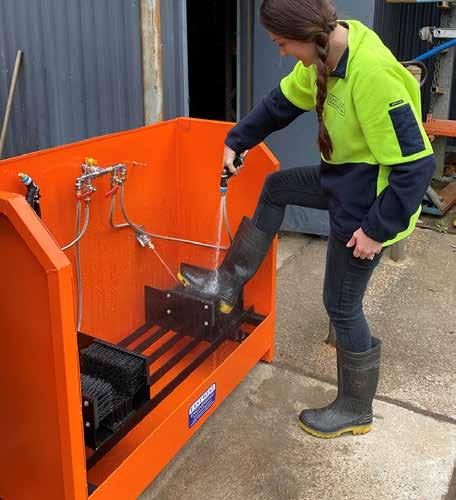
“Operations like cutting, grinding, drilling & spray painting generates industrial dust and grease in our production facility and must be regularly cleaned.
“Even still it’s impossible to stop this dust from being walked into the office, lunchroom and other common areas. This however brought about the idea of offering a boot cleaning station,” explained East West Engineering owner, Ron King.
The range includes equipment that consists of a hard wearing boot cleaning brush and grate (SWG) that is perfect for the entrance of any construction lunchroom, site office, farm or industrial workplace.
The metal grate is designed to scrape off hard stuck on debris while the three brushes give an all-round scrubbing of your boots.
For a more thorough clean, the 3-in-1 boot cleaner (SWS & SWL1) includes a hand-held water spray with optional spray jets.
Or there’s a sensor activated unit (SWHT-5300) featuring rotating brushes and automatic mixing of soap and water that’s fed to pressurised spray
bars, ideal for the food industry.
Whether to prevent food contamination, the spread of disease, or to simply keep your workspace clean, boot cleaning stations are the perfect solution.
Tough, all-purpose castors Plain text display goes with the flow
Tente’s range of high-quality stainless-steel castors can withstand permanent loading even when exposed to severe external influences.
Tente stainless steel castors are made of 1.4301 steel, also known as V2A steel. Consisting of 18% chromium, about 8-10% nickel and iron, castors made of 1.4301 stainless steel offer high resistance to a range of influences, such as water and humidity as well as acids, fats and strong cleaning agents.
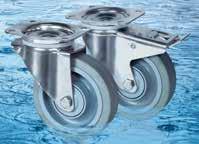
The castors remain durable and stable even under permanent loading.
Thanks to their corrosion resistance, the castors boast a long service life and can be used within a wide temperature range, including at temperatures approaching absolute zero. In situations where extreme temperatures are encountered, a combination of stainless-steel castors with heat-resistant components is possible. They can be used in bakeries or cold stores, for example.
These castors’ material properties also make them ideal for heavy-duty applications, including settings where strict hygiene regulations apply. They are therefore widely used in medical technology, as well as in the pharmaceutical and food industries.
In addition, the castors are washable, which is highly important in industries where hygiene is paramount.
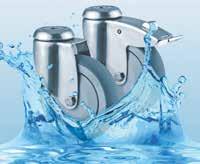
The new alphanumeric display on Turck’s FS101 sensors makes commissioning and operating its family of FS+ fluid sensors even easier.
The new FS+ devices have the standard Fluid+ look and feel, making them just as easy to run and commission as the rest of the range.
The fourdigit 12 segment display on the device shows the flow rate value as a percentage of the setpoint.
The IO-Link smart sensor profile simplifies replacement of IO-Link flow sensors from other manufacturers with FS+ devices, as process data, parameters and functions are standardised.
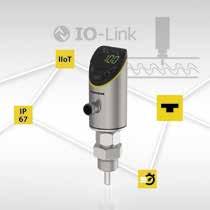
The new FS101 retains the unique Quick Teach and Delta Flow functions that already simplified commissioning in the existing FS100.
Delta Flow ensures that the teach-in is not performed until the warmup phase of the temperature peak is completed, and a constant flow is present. This avoids a frequent source of errors seen in traditional parameterisation processes. Users also benefit from the trouble-free operation via capacitive touchpads. Turck will continue to offer the earlier FS100 devices with a bar graph display. Turck flow sensors can be used in many applications including the monitoring of flow in coolant circuits or for dry-run protection in pumps.
PRODUCTS
Tente Australia tente.com.au Turck turck.com.au East West Engineering eastwesteng.com.au 86 | Industry Update Issue 130 Feb/Mar 2023 industryupdate.com.au










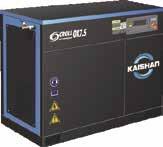


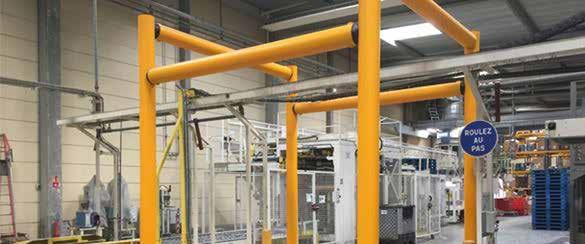

The SpecialiSTS in elecTronic DriveS for over 30 yearS Datafactory • Repairing of complex electronic boards, including obsolete boards that are no longer supported by vendors • Design and construction of multi-drive systems • Professional Control Systems Integrators • Repairing/retrofitting of electronic AC, DC and servo drives • Laboratory & Clean Room • Large Stocks of Spare Parts • Australia wide 24 hour service Call us on 03 9874 7737 www.datafactory.com.au Reduce overhead damage to building structures & doors A-Safe Australasia Pty Ltd - asafe.com | (02) 9625 8927 Make sure your business has a presence from a single $299+ GST or a double flash ad from $499+ GST The ads above are called flash ads and this is how they work.. Colour Logo Strong Headline Website, email and phone number Colour Picture FLASH ADS Call Scott 02 9439 1288 / sales@industryupdate.com.au


































































 by Christine Powis
by Christine Powis




 By Margie Smithurst
By Margie Smithurst

























































 By Margie Smithurst
By Margie Smithurst






























































































































































 By Margie Smithurst
By Margie Smithurst

























































 By Margie Smithurst
By Margie Smithurst



























































































































